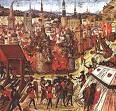
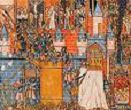

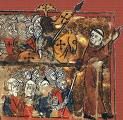



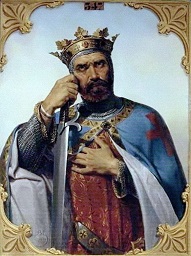
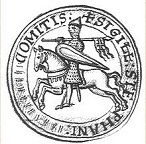
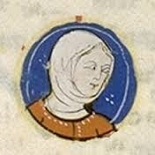

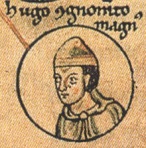
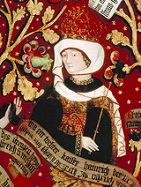



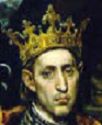
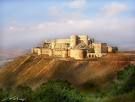


















TLW's Crusaderscoper™ (Crusades Historyscope) |
By T.L. Winslow (TLW), the Historyscoper™ |
© Copyright by T.L. Winslow. All Rights Reserved. |
Original Pub. Date: May 14, 2016. Last Update: Jan. 20, 2025. |
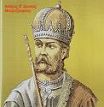


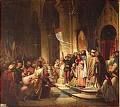
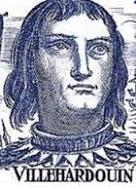
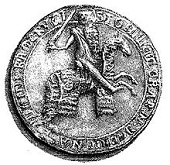

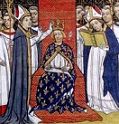

Westerners are not only known as history ignoramuses, but double dumbass history ignoramuses when it comes to Crusades history. Since I'm the one-and-only Historyscoper (tm), let me quickly bring you up to speed before you dive into my Master Historyscope.
1095 The First Crusade [Godfrey of Bouillon] (-1099)
1118 The Knights Templar are founded
1147 The Second Crusade [Louis VII] (-1149)
1162 Birth of Genghis Khan (d. 1227)
1188 The Third Crusade [Richard I] (-1192)
1202 The Fourth Crusade (-1204)
1204 The Crusaders sack Constantinople and harden the Great Schism
1217 The Fifth Crusade [John of Brienne] (-1221)
1228 The Sixth Crusade [Frederick II] (-1229)
1231 Pope Gregory IX establishes the Inquisition
1248 The Seventh Crusade [Louis IX] (-1254)
1270 The Eighth Crusade [Louis IX] (-1270)
1271 The Ninth Crusade [Edward I] (-1272)
1291 Acre falls - the Crusades end
On July 23, 636 the Muslim Arabs under Gen. Khalid capture Gaza, the principal Jewish community in Byzantine Judea from the Byzantines, then in Nov. siege Jerusalem for 6 mo. (until Apr. 637); Neapolis comes under Muslim rule, and its name is Arabicized to Nablus.
In Apr. 637 Caliph Omar personally receives the submission of Jesus' old digs of Jerusalem (which they call Elya Al-Quds) after Patriach Sophronius (560-638) prefers to accept the Umari Treaty (Pact of Umar) (Umariyya Covenant) rather than fight, in which the Holy Sepulchre and the True Cross are protected, and all Christian churches and relics are left in Christian hands, in return for paying a jizya (tribute); Caliph Omar comes from Medina to Jerusalem (600 mi.) humbly on a camel, carrying a bag of barley, a bag of dates, a water skin, and a wooden platter; he has only one attendant, and when his own emirs greet him in fine silks he throws a tantrum, as well as handfuls of dirt at them, impressing the Greek proprietors of Big J, who present him with a key to the city; he meets with Patriarch Sophronius of Jerusalem, with whom he tours the Holy Places, making jokes about his followers being too expensive, and refusing an invitation to pray at the Church of the Holy Sepulchre, saying he doesn't want to endanger its status as a Christian temple; Christian mucky-mucks had claimed that the Bible predicts that a humble but just and powerful man will come to Jerusalem riding on an ass and will actually prove to be a protector an ally to the Christians of Jerusalem, so Sophronius dies a happy man early next year?; Jews are allowed back and are allowed to practice their religion but are forbidden to ride horses, hold judicial or civil posts or build new synagogues; the neighborhood of Silwan (Heb. "Shiloah", Gk. "Silwan") in modern-day East Jerusalem (on top of the old City of David) is granted to an agricultural community of cave-dwellers living there called Khan Silowna.
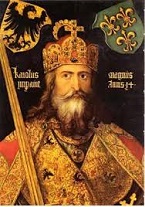
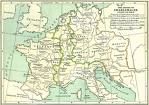
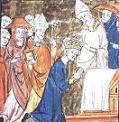
The Lion Trinity is born in Rome? On Dec. 23, 800 C.E. after being sent back to Rome by Charlemagne and kept in protective custody, Pope Leo III clears himself of Roman accusations of moral turpitude and is reinstated; on Dec. 25 (Christmas Day) Frankish king (since 768) Charlemagne (Carolus Magnus) (Karl der Grosse) (Charles the Great) (742-814) is crowned emperor of Rome by surprise as he is kneeling in prayer in the 4th cent. Church of St. Peter in Rome before St. Peter's tomb, and triple-threat Leo III pops up from the shadows and places a crown on his head, hailing him as Caesar and Augustus, with the rehearsed clergy and people shouting "Charles Augustus, crowned great and peace-loving emperor of the Romans, life and victory", causing Charlemagne to allegedly utter the soundbyte that he would never have entered the church that day if he had known the pope's intentions (he wanted to be crowned emperor in France sans the pope so he wouldn't owe him?); the First Reich begins (ends 1806), with capital at Aachen, which is likened to the New Jerusalem, complete with a throne modeled after King Solomon's; the term "Holy Empire" is used in 1157, and "Holy Roman Empire" in 1254; after trying to mollify the outraged Byzantines for stealing their imperial title by satisfying himself with "emperor, king of the Franks and Lombards", Charlemagne tries to erase the lost years since 476 C.E. and refound the Western Roman Empire (ends 1806), while his master the pope tries to make himself the supreme bishop of Christendom, reserving the title of Pope (Papa), and introducing azymes (unleavened bread) into the Eucharist; too bad, Leo III becomes the only pope in history to bow before an earthly king, but he later backtracks and asserts the right of popes to crown all emperors, who must bow before them, and later artists redraw the scene to make it PC; "... the only authentic nobility is the nobility of Visigothic/Merogingian origin. The Carolingians, then all others, are but usurpers. In effect, they were the functionaries of the king, charged with administering lands - who, after transmitting by heredity their right to govern these lands, then purely and simply seized power for themselves. In consecrating Charlemagne in the year 800, the Church perjured itself, for it had concluded, at the baptism of Clovis, an alliance with the Merovingians which had made France the eldest daughter of the Church" (Mathieu Paoli); too bad, after stirring up the Norse Vikings, the resurrected Western Empire lasts less than 30 years after Charlemagne's 814 death (until 843); at first the game is to challenge the Byzantine emperor's claim of universal temporal sovereignty and not get their butts kicked, and of course he refuses to recognize the elevation of an illiterate barbarian to the imperial purple, but Big Charles starts out to change their minds the tried and tested way with negotiations to marry Empress Irene and unite the two empires (by the power of Dick Almighty, oh those Slim Tips?); meanwhile he requires all males above age 12 to renew their oath of allegiance to both the empire and Christianity, making it a capital offense to refuse baptism, and tries to improve the admin. by dividing the empire into districts ruled by counts who defend the frontiers, while new missi dominici (imperial messengers) are hired to create a comm network; like any good emperor wanting to promote culture, he imports architects from Ravenna to Worms and Cologne to develop Romanesque Architecture (characterized by semi-circular arches, massive thick walls and symmetrical plan, sturdy pillars, groin vaults, large towers, and decorative arcading), and has poems sung to music at his court, which becomes a mecca for learned men from the empire, building up libraries of Greek and Roman mss., while Charlemagne sets an example by learning Latin and Greek (as well as German) and writing a grammar of his own language; his court has twelve peers called Paladins (from "palatine") (palace officers) (great knights) (douzepers) (actually a later fiction mixing up the old Roman Emperor and his Palatine Hill with King Arthur of Britain and his Knights of the Round Table); he also establishes a fleet to guard against Viking attacks in the Channel, causing them to invade Germany instead, discovering the Faroe (Sheep) Islands.; Charlemagne exchanges gifts with Abbasid caliph Harun al-Rashid, and the patriarch of Jerusalem sends Charlemagne the keys of the Anastasis along with some relics; Harun al-Rashid allows him to build a hospice in Jerusalem opposite the Anastasis, along with a church and splendid library; Charles goes on to erect a hostel in the Kidron Valley for pilgrims with 12 rooms and fields, vineyards, and market garden; after his death Latin chronicles claim that the caliph put Charles in er, charge of the Christians of Jerusalem, and wanted to give him the entire Holy Land although he could only make him owner of the Anastasis.
About 950 C.E. Medieval Climate Optimum (Climatic Anomaly) (Warm Period), a period of temps. 1-2 deg. F higher than normal begins (ends 1250); Tree Ring Growth in this half-cent. and the next cent. are especially rapid, indicating a warm period; the warmest period is between 950-1100, becoming the warmest period of the last 2K years prior to the 20th cent.
In 969 the Shiite Ismaili Fatimids under gen. Gawhar al-Siqilli (928-93) extend their N African empire by invading and conquering Ikhshidid-controlled Egypt, then set their sights on Syria, taking Jerusalem and burning the Dome of the Holy Sepulchre, founding the Ism'ili Shiite Egyptian Fatimid Dynasty (ends 1171), denying the legitimacy of the Sunni Abbasid caliphate and wanting to be numero uno, eventually controlling Egypt, N Africa, the Hijaz, and most of Syria; Janhar el-Kaid founds the new capital of Cairo (al-Qahirah) ("the Conqueror") (modern-day pop. 9.5M/20.4M) 3 mi. N of the old capital of Fustat (founded 641) (which was taken on Aug. 5), although the latter remains the center of pop., commerce, and industry; the Qaramitas take advantage of the fall of the Ikhshidids and seize control of S Syria.
In 969 the Byzantines capture Antioch and the N Syrian coast (until 1084); the Hamdanid emirate of Aleppo contracts to the city, and its hinterland becomes a Byzantine satellite by the end of the cent.
In 998 the Byzantines agree to a series of formal truces ' with the Shiite Fatimids of Egypt, giving Egypt control of Jerusalem and Damascus, while Antioch remains under Byzantine control.
In the 11th cent. the Medieval Climate Anomaly begins, bringing a warm climate; the sea level rises 0.5mm a year for the next four cents; Europe begins a period of optimal climate conditions for agriculture, producing large harvests until c. 1250 - good era for producing those legions of young unmarried stags who will go on military expeditions looking for the Three P's, poon, er, the Three B's?
About 1000 C.E. the Early Middle Ages end, and the High Middle Ages begin, with major changes in W European life, incl. the rise of medieval communes, the resurgence of city life, the appearance of the burgher class, the revival of long-distance trade with the Mediterranean, the founding of the first univs., the rediscovery of Roman law, and the beginnings of vernacular lit.; meanwhile the Byzantine Empire enjoys its Golden Age in Greece and Turkey.
In the 11th cent. the failure of Christ to return causes him to go from being portrayed as "Christ triumphant" to "the Christ of pain", becoming his main act by the 13th cent.
In the 11th cent. Venetian aristocrats begin using hereditary surnames, and by the end of the cent. returning Crusaders spread the custom throughout Europe.
In Sept. 1009 after ordering the destruction in 1003 of St. Mark's Church in Fustat, Egypt and replacing it with the al-Rashida Mosque, which impinges on nearby Jewish and Christian cemeteries, followed by orders to confiscate Christian bldgs., burn crosses, and build small mosques on their roofs, falling for advisors who tell him how rich and arrogant Christians in Jerusalem are, mad Egyptian Fatimid Shiite caliph Al-Hakim orders the destruction of all churches (30K?) and synagogues in Jerusalem; his men sack and nearly destroy the Church of the Holy Sepulchre, along with the Anastasis and the Martyrdom of Constantine, leaving only a few portions of the Rotunda on Golgotha; he follows with legislation to segregate dhimmis from the Muslim ummah and force them to convert to Islam by making Christians wear heavy crosses around their necks and making Jews carry a large block of wood; in 1011 Jews are stoned in Fustat as they follow a funeral cortege, while the synagogue in Jerusalem is desecrated and its holy scrolls burned; 1016 he turns on Muslims, forcing them to subsitute his name for God in Friday prayers, sparking riots in Cairo, which only makes him madder, and in 1017 he forbids Muslims to fast on Ramadan or to make the hajj to Mecca, torturing those who disobey; luckily for everybody, one night in 1021 he rides out of Cairo alone into the desert and is never seen again, leaving Christian Jerusalem in ruins, after which in 1023 his sister Sitt al-Mulk sends Patriarch Nicephorus of Jerusalem to Constantinople to report on the situation and get authorization to rebuild, only to be interrupted in 1024 by a revolt against the Fatimids by the Bedouin Jarrah Tribe, who seize control of the roads in Palestine and lay the countryside waste.
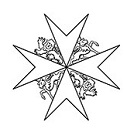
In 1048 Benedictine monks in Jerusalem, devoting themselves to the care of the sick and injured gain authorization by the caliph of Egypt to build a church, convent, and hospital donated by merchants from Amalfi, Italy (near Naples), and adopt the 8-pointed white cross emblem of the Repub. of Amalfi as their badge, later calling themselves the Order of St. John Ambulance ("walking hospital"); they are officially recognized by Pope Paschal II on Feb. 15, 1113; their symbol of a white 8-pointed cross on a black background becomes an internat. symbol of first aid; the Church of the Holy Sepulchre in Jerusalem is partially restored under the reign of Byzantine Emperor Constantine IX Monomachus.
In 1064 the Great German Pilgrimage (ends 1065), which incl. archbishops Siegfried of Mainz and Thiemo of Salzburg, and bishops Arnold of Bamberg and Altmann of Passau opens up future Crusader routes; too bad, after they reach the Holy Land Bedouins attack and plunder their fat purses, killing many before reaching their goal of Jerusalem.

In 1070 a group of monks from Calabria in S Italy led by Ursus (of the Merovingian bloodline?) travel to the Ardennes Forest in NE France, and are given patronage by Godfrey (Godfroi) de Bouillon's aunt and foster mother Matilda of Tuscany (1046-1115), who gives them land in Orval (Fr. "valley of gold", named by Matilda after she loses her wedding ring in a spring and it is returned by a trout) near Stenay, site of the assassination of Dagobert II; they mysteriously disappear by 1108; one of them is Peter the Hermit, who becomes Godfrey's tutor and sparks the First Crusade?
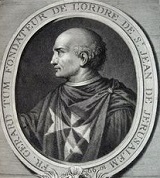
In 1070 after being given permission by Egyptian caliph Ali az-Zahir, the Hospital (Order) of St. John the Baptist (Hospitalers) (Knights Hospitaller) (black mantle with a white cross) is founded in the Muristan Christian district of Jerusalem near the Holy Sepulchre by Amalfi Merchants led by Mauro of Pantaleone to take care of sick pilgrims who just came in from the rough 5-mo. journey from W France, establishing the Abbey of St. Mary of the Latins and the Nunnery of St. Mary Magdalene, manned by Benedictine monks from Montecassino, who in the 1060s establish the Hospital of St John on the site of the Monastery of St. John the Baptist; in 1099 during the First Crusade they are militarized as the Knights of St. John of Jerusalem by the Blessed Gerard Thom (Thom) (Tum) (Tune) (Tenque) (1040-1120), and formally recognized by Pope Paschal II on Feb 15, 1113.


On Aug. 26, 1071 (Fri.) after rejecting all offers, the orthodox Sunni On Aug. 26, 1071 (Fri.) after first proposing a peace treaty, which is rejected, 30K orthodox Sunni Seljuk Turks from Turkestan under Sultan Alp Arslan ("Lion Hero") (Muhammad bin Dawud Chaghri) (1029-72) decisively defeat a 70K-man Byzantine force under Emperor Romanus IV Diogenes at the Battle of Manzikert (Malazgirt) (Melasgird) N of Lake Van, killing 2K-8K incl. the entire Varangian Guard along with the Norse and Anglo-Saxon mercenaries, and 2K Turkish mercenaries, capturing him after Andronicus Dukas and other magnates desert him along with 20K-35K mainly Frankish and Norman mercenaries, taking 4K POWs; Alp Arslan has the dusty tattered Romanus IV brought before him, and places his foot symbolically on his neck, then orders him to be treated as a king, releasing him after eight days for a 1.5M solidi ransom and a guarantee of 360K more each year; Turkoman chief Atsiz seizes and conquers Palestine; the Turks now control Jerusalem and have an open gate to the C Anatolian plateau, which they occupy and dechristianize (Muslimize) over the next two cents., cutting off all pilgrim routes to Jerusalem until the First Crusade in 1095; less-than-competent junior emperor (since May 22, 1067) Michael VII Ducas (Parapinakes) (Minus a Quarter) (1050-90), son of Constantine X is forced to assume rule by the bureaucrats as Roman Byzantine emperor #151 (until Mar. 24, 1078), appointing Byzantine scholar Michael Psellos (1017-78) as his chief adviser while devoting himself to learning instead of govt. admin., causing his military to deteriorate further; the Caliphate of Cairo in Egypt is still intact, as are the Dominions of the Almoravids in Africa and Spain; meanwhile Malik Danishmend founds a Seljuk principality in N and C Anatolia, which later becomes a rival to Rum. Alp Arslan returns from his campaign agains the Byzantines and deposes ruler (since 1054) Abu Nasr Mamlan II, ending the Rawwadid Dynasty (founded 979).
In 1074 after Pope Alexander II sends legate Rudolph to Prague to investigate the rivalry between bishop Jaromir of Prague and bishop John of Olomouc, and Jaromir snubs him, Rudolph is deposed, and new Pope Gregory VII convokes an Easter synod in Rome, ordering Jaromir's brother Vratislaus II of Bohemia to remove him; he then sends a Letter Calling for a Crusade, but because of the investiture controversy with HRE Henry IV, plus the Norman expansion in Italy under Robert Guiscard, it fizzles and no infidel Muslims get butchered in the name of Christ this year; he excommunicates mean old Norman Robert Guiscard, along with all married priests - Jesus did not marry Mary Magdalene?
In 1076 Khawrezmian Turkish mercenaries under Atsiz ibn Uvaq conquer S Syria incl. Damascus, displacing the Arabs for the next two cents.; Atsiz ibn Uvaq becomes the first Seljuk emir of Damascus, ordering the construction of the Citadel of Damscus; too bad, next year he unsuccessfully attacks Cairo, and is chased by the Fatimids back to Syria, quelling a revolt in Jerusalem and massacring the pop. while appealing to Tutush I, brother of Great Seljuk sultan Malik Shah I, who gets pissed-off at the massacre and orders him imprisoned and strangled then takes control of his territories, appointing Aruqud Dynasty founder Artuq bin Ekseb (-1091) as gov. of Jerusalem (until 1091).
In 1079 Abu Sa'id Taj ad-Dawla Tutush I (-1095) becomes Seljuk sultan of Damascus (until 1095), going on to conquer S Syria from the Turkomans, then kick the Fatimids out until they only have a thin strip of coastal Palestine.
In 1095 after taking Syria from his brother Seljuk sultan Malik Shah I in 1085 (losing it in 1086 and reconquering it in 1094) and finishing the Citadel of Damascus (begun 1076), Seljuq Damascus sultan (since 1079) Tutush I is KIA in a battle with Seljuk sultan (since 1093) Berkyaruq ibn Malikshah (-1105) near Ray along with his gen. Kakuyid Ali ibn Faramurz, and his younger son Duqaq (Abu Nasr Shams al-Muluk Duqaq (-1104) inherits Damascus, and elder son Ridwan (Fakhr al-Mulk Radwan) (-1113), inherits Aleppo, but gets ideas and seizes Damascus, launching a civil war, with Duqaq aided by Yaghi-Siyan of Antioch, and Ridwan aided by Jerusalem gov. Ilghazi and his brother Sokmen of the Artuqids; after Ridwan's atabeg Janah ad-Dawla splits and captures Homes from him, Yaghi-Siyan flops and marrries his daughter to Ridwan, and the two set out to attack Shaizar until they hear of the arrival of the infidel First Crusaders, and everybody returns home rather than unite to fight them; Tutush's kingdom in Syria falls apart as his sons contest the succession, making the Crusaders' work easier, even though the Seljuks continue to rule Syria E of the Frankish states until 1128.

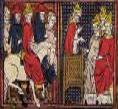




In 1095 the Fatimids of Egypt under emir (sultan) Aphdal take advantage of the quarrels among the Seljuks and take Palestine incl. Jerusalem and Tyre; Peter the Hermit (Peter of Amiens) (1050-1115), a priest of Amiens in Picardy (a former soldier under the counts of Boulogne, who took holy orders after his wife got old and ugly) visits the Holy Sepulchre in Jerusalem, gets pissed-off at the "sufferings of the natives and pilgrims of Palestine", and goes to ecumenical patriarch of Constantinople (1084-1111) Nicholas III Grammaticus (-1111) lobbying for Byzantine emperor (1081-1118) Alexius I Comnenus (Alexios I Komnenos) (1048-1118) to take it back, but is stonewalled, causing him to land in Bari and meet with Pope (1088-99) Urban II (Otto de Lagery) (1042-99), who shines to the idea, telling him to go out and preach the cause, which he does with gusto in Italy and France; "His diet was abstemious, his prayers long and fervent, and the alms which he received with one hand, he distributed with the other: his head was bare, his feet naked, his meagre body was wrapped in a coarse garment; he bore and displayed a weighty crucifix; and the ass on which he rode was sanctified, in the public eye, by the service of the man of God... every breast glowed with indignation when he challenged the warriors of the age to defend their brethren, and rescue their Saviour... The most perfect orator of Athens might have envied the success of his eloquence... and Christendom expected with impatience the counsels and decrees of the supreme pontiff" - Gibbon, Ch. 58; the whole story is phony baloney, made up by later writers as a coverup?; meanwhile, after receiving a letter from Byzantine emperor Alexius I seeking help against the Seljuks, Urban II hastily summons a church council to discuss the problem (really the opportunity to unite the two churches under himself); the 200-bishop, 4K-clergy, 30K-laity Council of Placentia hears Byzantine ambassadors pleading their Western European Christian brethren to come save Constantinople from the Turks, to take the battle to Muslim Asia before the Muslim Turks take the battle to Europe (later used by U.S. Pres. George Dubya Bush?), revealing the pope's true reason for the Crusade; like Bush, he wants Congress to approve it first, so he calls the 8-day Council of Clermont in Auvergne, France (his native country), which he attends on Nov. 27 with 13 archbishops, 225 bishops, and 400 priests, while thousands of adoring laity (plus lords and knights) attend; it proclaims the Truce of God (a suspension of hostilities four days of each week), places women, priests, husbandmen and merchants under the protection of the church from the current private wars, and the nine Christian Crusades to Jerusalem begin with the First Crusade when on Nov. 27 Pope Urban II gives a Killer Sermon, calling for an end to private wars among Christians and an all-out effort to sweep the Muslim infidels back and restore the site of the Holy Sepulchre into Christian hands, sweetened by a plenary (paid in full for all sins) indulgence for enlistment, telling them not to do it for vengeance but for contrition or penance; (you had to be there, but) as the crowd shouts "God wills it, God wills it!" (Deus vult, Deus vult!) (Deus lo volt) (Deix el volt), the pope exclaims, "And let this memorable word, the inspiration surely of the Holy Spirit, be forever adopted as your cry of battle, to animate the devotion and courage of the champions of Christ. His cross is the symbol of your salvation; wear it, a red, a bloody cross, as an external mark, on your breasts or shoulders, as a pledge of your sacred and irrevocable engagement"; after great numbers of clergy and laity get red and put the bloody cross on, and ask popey to lead them into battle, he, ahem, begs that his official duties preclude him from taking time from his busy schedule, and appoints Bishop Adhemar (Ademar) of Le Puy (-1098) (the first bishop he ever elevated) as his legate to the Crusades in Dec., and Count Raymond IV of Toulouse (Raymond I of Tripoli) (Raymond of Saint-Gilles) (1038-1105) as the military cmdr., with instructions to depart for the Holy Land on Aug. 15 of next year (Festival of the Assumption); meanwhile Urban II stays far from the action, traveling around in the rear giving more speeches to raise more suckers, er, soldiers and support; not to be left out, Benedictine brain man Guibert of Nogent (1055-1124) informs the Crusaders that Jerusalem must be seized as a necessary prelude to its eventual capture by Antichrist, followed by the Second Coming of Christ, with the soundbyte "The End of the World is already near" - he meant 1099, the next available Millennium Fever year?




On Feb. 11, 1096 despite Philip I's excommunications preventing him, a lunar eclipse makes Count Hugh the Younger of Vermandois (1057-1101) decide to join the First Crusade, taking the smart route via the Alps and Rome to Bari, then across the Adriatic Sea to Illyricum, sending an "absurd message" (The Alexiad by Anna Comnena) to Byzantine emperor Alexius I Comnenus: "Know, Emperor, that I am the King of Kings, the greatest of all beneath the heavens. It is fitting that I should be met on my arrival and received with the pomp and ceremony appropriate to my noble birth", later sending 24 envoys to the doux of Dyrrhachium with the message: "Be it known to you, Doux, that our Lord Hugh is almost here. He brings with him from Rome the golden standard of St Peter. Understand, moreover, that he is supreme commander of the Frankish army. See to it then that he is accorded a reception worthy of his rank and yourself prepare to meet him"; too bad, his fleet is lost in a storm, and he is thrown ashore near Epirus and brought to Dyrrachium, where the doux, the emperor's nephew John Comnenus (Komnenos) shows him hospitality and has him escorted by Gen. Manuel Boutoumites (Butumites) to the emperor, who talks him into swearing fealty and swearing that he will restore all former Byzantine territories lost to the Turks, and hold any conquests as fiefs; too bad, he tries to talk Godfrey of Bouillon into doing ditto, and receives the reply: "You left your own country as a ruler... with all that wealth and a strong army. Nnow from the heights you've brought yourself to the level of a slave. And then, as if you had won some great success, have you come here to tell me to do the same?", to which Hugh replies "We ought to have stayed in our own countries and kept our hands off other people's." On Apr. 20, 1096 (Easter), with Millennium Fever at a high pitch, and large numbers of unemployed mercenaries left over from Normandy and Sicily needing work, the People's Crusade (60K mainly poor knights and peasants), led by barefoot, ass-riding, cross-wearing Peter the Hermit (Peter of Amiens) (1050-1115) leaves Cologne for the Holy Land, and is soon joined by 20K German peasants led by the monk Godescal, followed by another 200K lowlifes, led by two holy mascots, a goose and a goat, who warm up by massacring prosperous Jewish colonies along the Rhine River (Cologne, Moselle, Verdun, Treves, Mentz, Spires, Worms, etc.) for fun and profit along the way after being put up to it by Count Emicho, who is killed by King Coleman of Hungary in late May; on May 3 the Crusaders drag 11 Jews into a church in Speyer, then kill them when they refuse to convert, while the rest of the Jews are protected by Bishop Johannsen, who gets some of the guilty Crusaders executed; on May 27 Archbishop Ruthard of Mainz hides 1.3K Jews in cellars, causing the Crusaders to break in and massacre 1,1014, a remnant being saved by concealment in the cathedral, and four Jews accepting baptism later committing suicide; on June 1 after Bishop Egilbert of Trier offers protection to Jews only on the condition of conversion, several women kill themselves and their children by drowning in the Moselle River; in June after the Jews of Cologne are given shelter in Christian homes while the Crusaders burn their quarter and kill stragglers, Bishop Hermann sneaks them to Christian homes in the country, but is discovered, and most of them are massacred, incl. 200 in two villages, and mass Jewish suicide in four others; on Aug. 20 after Bishop Allebranches of Worms tries to hide Jews in his palace and a crowd sieges it, he advises conversion to save themsleves, but 800 (most) commit suicide; the Jewish colonies take 70 years to recover; the first party of Crusader lumpen, lurdans, and rabble under the command of Walter de Pexejo and Walter the Penniless (Gautier Sans-Avoir) passes through Hungary safely, but are attacked in Bulgaria; Peter the Hermit and his 20K crusaders follow, but sack Belgrade and Semlin in June after seeing the clothing of 16 Crusaders on the walls of the latter, then march to Nissa (Nish) in Serbia, where they are first greeted hospitably but have their butts kicked on July 3 after an accidental quarrel; they then proceed to Constantinople, arriving in Aug.; while Peter is negotiating with the Byzantine emperor, his 300K-man army, led by the well-financed Walter the Penniless (eight horsemen for each 15K foot soldiers) is annihilated on Oct. 21 by Turkish bowmen at the Battle of the Plains of Nicaea (Nice), leaving a "pyramid of bones" (Gibbon); the Crusaders in Constantinople are shocked when they encounter the Turcopoles (Turopoliers), mixed Greek-Turkish mounted archers working for the emperor who profess to be Christian but might be Muslim inside, but they end up employing them as long as they eat at separate tables?; avg. Crusader height is 5'3", and they wear chain not plate mail, which isn't invented until the late 12th cent.; their horses are puny compared to the Muslims for lack of Arabian blood, and it takes two cents. to catch up. The second stringers are down, so call in the first string? On Aug. 15 after selling Bouillon to Bishop Orbert of Liege for 1300 marks of silver and 3 marks of gold (1 mark = 230g), bilingual (French and German) Godfrey (Godfroi) (Godefroi) (Geoffrey) de Bouillon (1058-1100), duke (since 108) of Lower Lorraine and Margrave of Antwerp, a direct descendant of Charlemagne in the female line and a descendant of Sigisbert, last Merovingian king) leaves for the Crusades with his brothers Eustace and Baldwin at the head of 80K infantry and 10K cavalry; too bad, he starts out by declaring that he would avenge the blood of Jesus upon the Jews, and kill all who won't convert, abetted by a monk who claims that an inscription on the Holy Sepulchre orders all Christians to convert them; William I the Conqueror's eldest son Robert Curthose pawns Normandy to William II Rufus for 10K marks (1% of its yearly revenue) to finance his departure for the Holy Land, his party consisting of Frankish and Norman barons Tancred (1075-1112) (nephew of Robert Guiscard by his daughter Emma and Marquess Odo), Bohemund (Bohemond) I de Hauteville, Count of Taranto (1057-1111) (son of Robert Guiscard) (the #1 military man of the First Crusade, who allegedly fights like a starved lion among a flock of sheep), Count (since 1093) Robert II of Flanders (1065-1111), and Count (since 1089) Stephen II of Blois and Chartres (1045-1102) (known for writing gung-ho Letters to Wife Adele About the Crusade), led by papal legate Bishop Adhemar of Puy and Raymond of Toulouse in several large contingents totaling well over 100K; on Dec. 25 Godfrey's main force of 60K arrives in Constantinople, where suspicious Emperor Alexius I is at first startled because he only asked the pope for 300 top knights, and instead sees a host of heretical locusts, which he locks outside the city gates, but finally gives up on stopping them and decides to use them, making the leaders promise to do homage to him for all territory conquered from their common infidel foes in return for giving them boat passage across the Bosphorus and opening food markets - I'll bet they renege? Taking advantage of their troubles with the Crusaders, David IV of Georgia renounces tribute to the Seljuks. Welf II/V of Bavaria divorces old hag Matilda of Tuscany, allowing his daddy Welf I/IV (d. 1101) to patch things up with HRE IV and get his dukedom back next year; too bad, he never remarries and leaves the dukedom swinging in 1120.
On Apr. 10, 1097 Bohemund arrives in Constantinople ahead of his army; Tancred arrives with the army a short time later; Duke Robert of Normandy arrives in May with the last large Crusader army; along the way Crusaders pass through Phlaginia (ancient Butelion) on the Dragur River at the foot of Mt. Pelister in Macedonia,and massacre the pop. and raze the town after discovering they are "heretics", after which a number of Greek monasteries are built in the area, causing it to be called Monastir; the principality of Lesser Armenia aids the Crusaders with equipment and troops; on May 14 the Crusaders siege Nicaea, where Turk leader Kilidge-Arslan (Soliman) holes up with 50K cavalry, and twice attacks the 6-mi.-dia. Christian camp, but the Crusaders capture it on June 19 after first bringing boats from the sea on sledges to Lake Ascanius, renaming it Iznik; the Turks agree to surrender only to Alexius, who takes over and sends the Crusader army under the guidance of a Greek general towards Phrygia, causing them to grumble that the emperor is a traitor to their cause; Soliman calls in all his markers and assembles a force of 200K-360K cavalry (Turks, Medes, Persians, Chaldeans), then catches up with the Crusaders on July 1 at the Battle of Dorylaeum (Eskishehir) 35 mi. S of Nicaea in Phyrgia in hot summer weather, and catches the 20K-man vanguard unprepared, almost defeating them with fast light mounted archers and dismounted archers who hold the bows in their feet while laying on their backs to increase the velocity until Duke Godfrey and the Count of Vermandois arrive with 60K cavalry, followed by Raymond of Toulouse, the Bishop of Puy, and the rest of the Crusader force, and rout Soliman, who evacutes Roum (Iconium) (Asia) with 10K guards, leaving the Latins to bemuse themselves with newfangled camels, then march 500 mi. through Lesser Asia unimpeded, finding the way to Syria blocked by the emirs of Cappadocia, taking Heraclea (modern-day Eregli in Konya Province) in Aug. by a cavalry charge, then coming to a desert which wastes them with heat, thirst, and steep passes on Mount Taurus in the Anti-Taurus Mts., killing 500 plus many horses incl. Baldwin's wife Gothilda, freaking him out because her lands will return to her family, making him desperate to make up for the loss by seizing and looting a city to the E; Soliman moves the capital of the Turkish Sultanate of Rum (Roum) (founded 1077) to Konya (Konia) (Iconium) in SC Anatolia, and the Byzantines recover the entire W coast of Anatolia. On Sept. 10 Tancred and Baldwin leave the main Crusader forces with 1.2K knights, capturing Tarsus and placing the Norman standard on its walls, followed by Mopsuestia (Mamistra); they then quarrel and fall out. On Oct. 21 after Bohemund and Robert of Flanders lead a foraging expedition that is attacked by the Turks outside the city on Oct. 20, the Crusaders begin the Siege of Antioch (ends June 3, 1098); Antioch, known for its strong thick walls with interlocking towers that foil battering rams is led by able Seljuk Turkish cmdr. Yagi-Shihan (-1098), known for his thick grey beard and big hairy ears, who sends the Christian pop. of the city outside the walls to dig trenches then locks them out, forcing the starving Crusaders to have to feed them too; in Dec. the Crusaders defeat a relief army from Damascus outside the city.
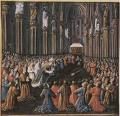
In early Feb. 1098 Tancred and his followers return to the main Crusader force; Tancred finds Peter the Hermit fleeing to Constantinople and returns him to the Crusader force; a delegation arrives from Fatimid Egypt sending greetings and offering to ally with the "great and small princes of the Christians" against the Turks, who are described as "a race foreign to me and dangerous to my kingdom"; on Feb. 9 the Crusaders and Fatimids battle Ridwan of Aleppo before the Fatimids return to Egypt with an agreement that if the Crusaders capture and hold Antioch, the Egyptians will retake Jerusalem and help Christians finish their pilgrimage and be assured of restoration of their churches and shrines, after which the Egyptians siege Jerusalem in Aug. and take it from the Seljukes before returning to Egypt, causing the Crusaders to waffle in their decision to march to Jerusalem until next year after deciding that the terms that they must arrive unarmed in groups of 200-300 is taken as an insult, rushing to take it in early 1099 and catching the Fatimids unprepared as they are tearing down the defenses to welcome the pilgrims; on Mar. 9 after Godfrey of Bouillon's brother Baldwin (Baudouin) of Boulogne (1058-1118) is invited by Greek Orthodox Armenian ruler Thoros of Edessa (-1098) of Edessa (Urfa) (modern-day Sanliurfa in SE Turkey) to help resist the Seljuks, capturing Turbessel (Tell Bashir) along the way, he makes an alliance with him in Feb., talking him into adopting him as his son and heir then inciting the people against him by promising to protect them from the Seljuks, getting him assassinated on Mar. 9 and his head carried triumphantly through the streets, after which he is given possession of the city, becoming count #1 of the County of Edessa (ends 1144), the first principality of the new kingdom of Outremer ("beyond the sea"), which lasts 54 years; meanwhile the Siege of Antioch (begun Oct. 21, 1097) grinds on for 7 mo., with at least 100K dead on each side, until Bohemund finds a traitor on the other side, Syrian Christian Tony Shalhoub, er, Phirouz, cmdr. of three towers, a wealthy Armenian Christian convert to islam who accepts a bribe and throws down ladders to help the Christians invade the city in a planned night attack on June 3, allowing them to capture all of the city except the central citadel after a great indiscriminate slaughter that makes the city stink to high heaven with piles of corpses; after hearing false news of the capture of the citadel, Yagi-Shihan flees the city, repents, starts crying, and is killed by a shepherd, who mounts his head on a stick, returning it to the Franks in the city; the next day a 600K-man Seljuk relief army led by Mosul atabeg Kerboga (Kerbogha) and 28 Turkish emirs appears, and on June 5 Stephen II of Blois flees, telling the advancing Byzantine army under Alexius I that he had just seen the kerboga man and all is lost, causing him to chicken-out and return to Constantinople and later get pussy-whipped by his wife Adela to try a 2nd fatal crusade in 1102; on June 7 the Turkish relief army begins a siege of Crusader-held Antioch, demanding unconditional surrender; on June 15 just as Crusader morale is breaking, a vision of St. Andrew by priest Peter Bartholomew (Bartholemy) (-1099) of Marseille, France leads him to choose 12 disciples and miraculously dig up the Holy Lance (Spear of Destiny) (Lance of Longinus) (the head of a Saracen lance he conceals in his robes and secretes at the bottom of a 12-ft. pit when they were about to give up after 1.5 days) in St. Peter's Cathedral in Antioch in front of a big crowd; many believe in this holy farce and morale soars, and Count Raymond of Toulouse latches onto it; on June 28 the Franks led by Bohemund (most of them dismounted due to having eaten all but 200 of 60K horses) win a decisive V against the Seljuk army, aided by the Holy Lance, plus the timely and miraculous appearance of three white-robed knights in the hills, which Bishop Adhemar claims are the martyrs St. George, St. Theodore, and St. Maurice (which J.R.R. Tolkien steals for his 1955 novel "The Two Towers"?); finally the central citadel is captured; Bohemund receives Antioch as a principality; too bad the Crusaders turn the city into a brothel, and an epidemic sweeps it, killing 50K incl. Bishop Adhemar in Aug.; Count Hugh of Vermandois is sent back to Constantinople to appeal for reinforcements to emperor Alexius I, but is pooh-pooh, and returns to France rather than fulfill his vow to make a pilgrimage to Jerusalem, getting scorned by the pop. and threatened with excommunication by Pope Paschal II, not to mention his wife Adelaide. On Dec. 12 after the Crusaders in Antioch suffer from starvation despite raiding the surrounding countryside, some Crusaders led by Raymond IV of Toulouse (Raymond I of Tripoli) (Raymond of Saint-Gilles) (1038-1105) and Bohemund I de Hauteville, Count of Taranto (1057-1111) siege and occupy Marre (Marra) (Ma'arra) (modern-day Maarat al-Numaan) between Aleppo and Hama and massacre the 8K pop., but still can't find enough food, resorting to cannibalism of Muslim corpses, boiling the adults and grilling the children along with choice buttock pieces from adults; "A dainty dish is Paynim flesh, with salt and roasting due" ("The League of Antioch").




On Jan. 13, 1099 Count Raymond of Toulouse leads the ragged horseless Crusaders onward to Big J, the brass ring city of Jerusalem, while Bohemund and his followers (except Tancred) claim Antioch for their own for the 2nd Outremer principality, and refuse to recognize the suzerainty of the Byzantine emperor, causing them to go to war; on Feb. 14-Apr. 5 a contingent of Crusaders under Count Raymond of Toulouse detour to lay siege to Arqa in Syria, but fail to take the town, and the whole expedition proves a bust, exhausting his resources. On Apr. 8 to satisfy skeptics of the Holy Lance, Peter Bartholomew is put through the "Trial of Ordeal" (fire) at the insistence of conniving Flemish priest Arnulf Malecorne of Choques (Rohes) (-1118), who hopes to take Adhemar's place in the Crusader ranks; Peter runs very smooth and very sexy through the 12-in. path in a 14-ft.-long pile of 4-ft.-high burning faggots, but is badly burned and dies of his injuries on Apr. 20, and the Holy Lance "soon vanished in contempt and oblivion"; meanwhile after Jerusalem is captured Arnulf becomes Latin patriarch of Jerusalem #1 (and again in 1112-18) - Gibbon, Ch. 58. In May 1099 the ragtag Crusaders, 40K strong incl. 5K cavalry (knights) leave Antioch to Laodicea, down the seashore through Tripoli, Tyre, Sidon, Acre, Ashkelon, and Caesarea to the brass ring city of Big J, Jerusalem, arriving with 1.5K cavalry and 12K healthy foot soldiers. On June 7 after the Egyptian Fatimids under Caliph #9 Abul-Qasim Ahmad al-Mustali (Mostali) bil-Lah (1074-1101) offered safe passage to the Holy Sepulchre along with expensive gifts, all in vain, and the Crusaders waited 10 mo. after the defeat of Kerboga "to enjoy the luxury of Syria" (Gibbon), 13K Crusaders begin the Siege of Jerusalem (pop. 200K); the 40K Egyptian defenders under Iftikhar al-Dawla (Arab. "pride of the dynasty") defeat the early assaults while awaiting reinforcements, which are too late, allowing the Crusaders to conquer the city on July 15 after (you guessed it) 40 days; on July 15 First Crusade leader Godfrey (Godfroi) de Bouillon (1058-1100), duke of Lower Lorraine, whose camp was pitched on Mount Calvary enters Jerusalem, and his Crusaders merrily begin a 3-day massacre of the pop., killing 70K for Christ (incl. driving quaking Jews to their synagogue then burning them alive), while the flag of Godfrey's Jerusalem Cross flies over the city; "If you want to know what was done to the enemies found in the city, know this, that in the portico of Solomon and in his Temple, our men rode in the blood of the Saracens up to the knees of their horses" - Godfrey de Bouillon and Raymond Daimbert, Letter to Pope Urban II from Jerusalem; "They went together through the streets with their swords and spears in hand. All that they met they slew and smote right down, men, women, and children, sparing none... They slew so many in the streets that there were heaps of dead bodies, and one might not go nor pass but upon them that so lay dead... There was so much blood shed that the channels and gutters ran all with blood, and all the streets of the town were covered with dead men." (William of Tyre, 12th cent.); this account is fiction, meant to fulfill the prophecies of Armageddon in the Book of Rev.?; the Crusaders take the crescent off the top of the Dome of the Rock and replace it with a cross, then build a Christian altar, only to see the Muslims take it back in 1187 and reverse the process. On July 17 a secret conclave is held, and Count Raymond of Toulouse asks for the kingship of Jerusalem, and is refused; Godfrey de Bouillon is offered ditto, and declines the title of king but suggests the title "Baron and Advocate (Defender) of the Holy Sepulchre", and is crowned by Peter the Hermit's associate King Tafur (from Calabria?); the secret conclave are mainly monks from Calabria via Godfrey's home in the Ardennes Forest who accompanied him on the Crusade, and move into the new Abbey of Mount Zion (Sion), built at Godfrey's request?; Raymond leaves Jerusalem, never to return, along with the French nobles; the new Latin Kingdom of Jerusalem, based on the cities of Jerusalem (falls in 1187), Antioch (falls in 1268), and Tripoli (falls in 1289) controls only a sliver of territory along the Syrian coast, except for the County of Edessa in SE Anatolia (until 1144), and depends on the Crusades of 1148, 1188, 1202, 1217, 1228 and 1249 for reinforcements, otherwise making little dent on the Muslim world?; the last Crusader fortress of Green Acres, er, Acre falls in 1291; in 1994 the Templar's underground tunnel in Acre is rediscovered by a woman unblocking a sewage pipe under her house. On Aug. 12 after mistaking the Crusaders for Byzantine mercenaries, offering them an alliance against the Seljuk Turks, only to see them capture Jerusalem from his Fatimid forces, causing him to come quick, Egyptian vizier (1094-1121) Al-Malik al-Afdal ibn Badr al-Jamali Shahanshah (1066-1121) and 20K-50K Fatimids are surprised-attacked and defeated at the Battle of Ascalon by 1.2K knights and 9K infantry (last battle of the First Crusade), and Godfrey de Bouillon becomes the first king of the new Kingdom of Outremer ("Beyond the Sea") for one year with a force of 300 knights and 2K infantry, aided by Tancred; Baldwin is sent to rule Edessa; Raymond Daimbert, archbishop of Pisa becomes the patriarch of Jerusalem; one quarter of Jerusalem and Jaffa are ceded to the Church; the Muslim Dome of the Rock is converted into the Templum Domini (Temple of the Lord); Godfrey de Bouillon allegedly composes the Assizes of Jerusalem, a legal code for the Latin Kingdom of Jerusalem, which is kept in the Holy Sepulchre until the city is retaken by Saladin in 1187; meanwhile the Crusaders abandon Ascalon, allowing al-Afdal to use it as a base for yearly attacks until 1107, incl. three major battles in Ramla in 1101, 1102, and 1105, following by frequent raids into Frankish territory until his assassination on Dec. 11, 1121. On July 29 Pope (since 1088) Pope Urban II (b. 1042) dies without learning the good news that his bloody red Crusaders won the Super Bowl after being pumped by his rave Clermont Council pep talk of 1095, and on Aug. 13 Italian Cluniac monk and cardinal (since 1076) Rainerius is elected Pope (#159) Paschal II (-1118), carrying on Hildebrand's policy against secular investiture; Antipope (since 1080) Clement III has been beaten, and loses most of his influence.
In 1099 the knight class is born in Europe, earning land in exchange for winning on the battlefield; they wear chain mail, not plate, and learn their siege concepts from the Muslims. The Crusades introduce new foodstuffs into the Euro diet, incl. the apricot, orange, shallot, and sugar ("sweet salt").






Where's my eye shadow? About 1099 (Crusader capture of Jerusalem) the Priory of Sion (scion of Zion?), a secret brotherhood to protect some kind of terrific secret about Jesus Christ being the secret husband of redheaded Mary Magdalene and leaving a sacred bloodline in S France was allegedly founded in Rennes-le-Chateau, France; a hoax spread by French draftsman Pierre Athanase Marie Plantard (1920-2000) in France in the 1950s, and fueled by English "Dr. Who" writer Henry Lincoln (Soskin) (1930-), who finds out that Rennes-le-Chateau master (1885-1917) Friar Francois-Berenger Sauniere (1852-1917) engaged in big spending, deducing that it came from money obtained from secret documents he sold, not knowing about a 1910 conviction for illegal trafficking in Masses?; in 1982 Lincoln, Michael Baigent (Michael Barry Meehan) (1948-2013) of New Zealand and Am.-born English writer Richard Harris Leigh (1943-2007) pub. The Holy Blood and the Holy Grail, after which in 2003 Am. novelist Daniel "Dan" Brown (1964-) pub. The Da Vinci Code, and they all begin dancing with the stars?
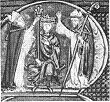
In Apr. 9, 1100 mo. after the fall of Jerusalem six elders of the Karaite Jewish community of Ashkalon (Ascalon) write the Letter of the Karaite Elders of Ashkalon to the Jewish elders in Alexandria, describing their ordeal in ransoming captured Jews and holy relics from the new Latin rulers of Jerusalem. On July 18, 1100 Godfrey (Geoffrey) de Bouillon (b. 1058), Baron and Defender of the Holy Sepulchre dies, and is buried in the Church of the Holy Sepulchre; on Dec. 25 his youngest brother Baldwin (Baudouin) I (1058-1118) is crowned Latin king #1 of Jerusalem (until Apr. 2, 1118).
In Sept. 1100 a large army of Lombard Crusaders, mainly peasants, led by Archbishop Anselm IV of Milan leaves from Milan; too bad, when they reach Byzantine territory they begin pillaging, causing Byzantine emperor Alexius I to arrive with his troops and escort them to a camp outside Constantinople, after which they break out, invade the big city and pillage his Blachernae Palace, killing his pet lion, after which the Byzantines round them up and ferry them across the Bosporus to Nicomedia.
In 1100 Melitene (Malatya) (Malatia) in E Anatolia, which guards one of the Cilician Gates through the Taurus Mts., ruled by wealthy Greek Orthodox Armenian soldier Gabriel of Melitene (-1103) is attacked by a large force of Danishmend Turks under Malik Ghazi Gumushtekin (Gumushtakin), emir of Sebastaea (Sivas) in C Anatolia, causing the Armenians to request military aid from Bohemond I of Antioch, who in Aug. marches N with only 300 knights and a small infantry force, and is ambushed and encircled by the Turks at the Battle of Melitene (Malatya), killing most of the Crusaders and capturing Bohemond along with his cousin Richard of Salerno, who are held for ransom; after a request by Gabriel of Melitene, King Baldwin I of Jerusalem relieves Melitene, and becomes its overlord; Baldwin of Courcq (Bourg) (1060-1131) (cousin of Godfrey of Bouillon) is appointed the new count of Edessa (until 1118), marrying Gabriel of Melitene's daughter Morphia of Melitene (-1126) next year.





In 1101 after a call for another crusade by Pope Paschal II, the Crusade of 1101 (Crusade of the Faint-Hearted) (composed mainly of those who turned back from the First Crusade) sees the Crusader group from Milan join up in Nicomedia ith a more prof. group of French, Burgundians, and Germans incl. Count Stephen II of Blois (1045-1102)) (who had been shamed by his wife (St.) Adela of Blois (1067-1137) ever since returning from the siege of Antioch in 1098 without capturing Jerusalem, and was pressured into joining this Crusade), Count Stephen I of Burgundy, Duke Eudes I of Burgundy, Conrad, HRE Henry IV's constable of Jerusalem, and Raymond IV of Toulouse, who is appointed leader; at the end of May after some Pecheneg mercenaries under Gen. Tzitas arrive from Constantinople, they march towards Dorylaeum along the 1097 First Crusade route, but break off the route to Konya after the Lombards clamor to rescue Bohemund I of Antioch in Niksar, capturing Ancyra on June 23, sieging Gangra (modern-day Cankiri), then continuing N to Kastamonu; too bad, after being attacked by the Seljuks under Kilij Arslan I they turn E instead of W, still going for Bohemund, and stumble into a combined Seljuk-Danishmend army under Kilij Arslan I, Ridwan of Aleppo, Malik-Ghazi of Sebastia, and Karaja of Harran, fighting the Battle of Mersivan (Merzifon) near the Paphlagonian Mts. in NC Anatolia in early Aug., which sees them surrounded and crushed them in a 4-day battle, the Muslims capturing most of the horseless Lombards along with the Crusader camp, incl. women, children, and priests; Raymond, Stephen of Blois, and Stephen of Burgundy flee N to Sinope, then return to Constantinople by sea; a new force from Bari, Italy then arrives in Constantinople under William II of Nevers, and sieges Konya (Iconium) in SC Anatolia, only to be ambushed at Heraclea Cybistra by Kilij Arslan I, who wipes them out except for the count and a few of his men; the last Crusader army then arrives, led by Duke William IX of Aquitaine (1071-1127) (the first troubador), Count Hugh the Younger of Vermandois (1057-1101) (son of Henry I of France and Anne of Kiev), and Duke Welf I of Bavaria (-1101), who brings along Austrian Babenberg queen Ida (Itha) of Formbach-Ratelnberg (1055-1101) (wife of Leopold II and mother of Leopold III of Austria), complete with her own army, and they split into two forces, one headed straight for the brass ring of the White House, er, Palestine via sea, the rest (15K) under Count William (Guillaume) II of Nevers (1088-1148) traveling by land, only to be ambushed and massacred in Sept. in Heraclea Cybistra, the survivors arriving on Oct. 18 in Tarsus, where Hugh dies of his wounds; Ida is KIA (and is rumored to be captured end up as the mother of Crusader enemy Zengi); on Nov. 6 after preventing a fight between the Crusaders and some Byzantine Pecheneg mercenaries pissed-off oat their pillaging of Byzantine territory, Welf I dies in Paphos, Cyprus on his way back;after all the remaining Crusaders regroup at Tarsus, they capture Tortosa with the help of a Genoese fleet, and arrive in Antioch by the end of the year. On Sept. 7, 1101 the First Battle of Ramla (Ramlah) (Ramleh) sees Baldwin I of Jerusalem take on the Egyptian Fatimid fortress of Ascalon with only 260 knights and 900 infantry in six divs. against 10K Egyptians; after the first two divs. are wiped out, the Egyptians pursue the 3rd one into the arms of the other three, allowing the Christians to show their viciousness in close quarter combat, causing the fatigued Fatimids to get timid and retreat in panic to Ascalon.
On May 17, 1102 the Second Battle of Ramla (Ramlah) (Ramleh) sees Baldwin I of Jerusalem bring only 500 knights against thousands of Egyptian Fatimids, and after the latter surprise them, the cocky Christian fools charge into the enemy lines only to be slaughtered, incl. Stephen of Blois and Hugh VI of Lusignan, after which Baldwin saves himself by barricading himself in Ramlah's only tower, then escaping under cover of darkness to Arsuf, where he talks an English ship capt. into breaking the Egyptian blockade of Jaffa, then rounds up a fleet of French and German Crusaders along with the True Cross for moral support and scores a V on May 27 against the way bigger Egyptian army at the Battle of Jaffa, using his cavalry to break the Egyptian lines and force them to flee to Ascalon, taking big booty; Stephen II of Blois is KIA in the final charge from the tower of Ramlah, where Conrad, constable of Jerusalem is captured, after which Stephen II's eldest son Guillaume is passed over for mental weakness, and his 2nd son Count Theobald II of Champagne (b. 1090) becomes count Theobald IV of Blois and Chartres (until 1151); Joscelin of Courtney decides to remain in Palestine, and ends up as count of Edessa in 1118; having kicked Crusader butt out of Asia Minor, Kilij Arslan I establishes his capital in Konya, and becomes a big man in the Muslim world, the first to kick Crusader butt; since he blocks the land route from Constantinople to Jerusalem, only the sea route remains for pilgrims; Tancred uses this fact to consolidate his power in Antioch without Byzantine interference, capturing Tarsus, Adana, and Massissa in Cilicia (SC Anatolia).
In 1103 the Danishmend Turks under Malik Ghazi Gumushtekin attack Melitene again, but the Crusaders fail to aid it because they're negotiating the release of Bohemond I of Antioch, and they conquer it and capture Gabriel of Melitene, who is executed outside the walls of a castle held by his men who refuse his order to surrender; meanwhile Byzantine emperor Alexius I tries to get even for Bohemond breaking his oath not to keep Antioch for himself, offering Gumushtekin 260K dinars for him, causing his overlord Kilij Arslan I to demand a 50% override on threat of an attack, after which Bohemond proposes a 130K dinar ransom cutting Alexius I out, which is paid by Baldwin I of Jerusalem, and after exchanging oaths of friendship with Kilij Arslan I, Bohemond returns in triumph to Antioch in Aug., then hooking up with Baldwin II of Edessa next Jan. to attack Harran.
On May 7, 1104 after faking a retreat for 2 (3?) days then suddenly turning and making their stand, catching the Crusaders not wearing their armor, the Battle of Harran 12 mi. of Harran near ar-Raqqah is a decisive V for the Seljuk Turks under Mosul gov. Jikirmish and Sokman, Artuqid lord of Mardin over the Crusader states of Antioch under Bohemond I and Edessa under Baldwin II, allied with Prince Tancred of Galilee, Joscelin of Courtenay, Antioch patriarch Bernard of Valence, Jerusalem patriarch Daimbert of Pisa, and Edessa archbishop Benedict, becoming the first major battle after the First Crusade, stopping Frankish expansion; Baldwin II and Joscelin are captured, and not ransomed until 1108; the Byzantines take advantage of the D to recapture Latakia and parts of Cilicia, while many towns ruled by Antioch revolt and are reoccupied by Muslim troops, and Armenian territories revolt in favor of Armenia or the Byzantines; Bohemond I makes Tancred regent of Antioch and returns to Italy and raises a huge Frankish army, takes it to Epirus and unsuccessfully sieges Durazzo, while emperor Alexius I avoids open battle; Baldwin I of Jerusalem retakes Acre, making it the chief Crusader port, taking advantage of the spice trade to make them wealthy, growing to 25K pop. by the 1130s; after their troops bear the brunt of the D at Harran, Edessa limps along until 1144, surviving only because of divisions among the Muslims.
On Aug. 27, 1105 the Frankish Crusaders led by Baldwin I of Jerusalem defeat the Fatimids at the Third Battle of Ramla (Ramlah) (Ramleh), which lasts most of the day and is the most bloody of the trio, ending with the Egyptians fleeing back to Ascalon again; Ridwan of Aleppo tries to take advantage of the Latin defeat at Harran by attacking Artah, but is defeated by an Antiochian army led by Tancred.
In fall 1107 Norwegian king (since 1103) Sigurd I Magnusson the Crusader (1090-1130) sails to England with 5K men in 60 ships to begin his Norwegian Crusade to Palestine (ends 1110) becoming the first Euro king to support the Crusaders; he never loses a battle.
In Oct. 1107 after marrying French king Philip I's daughter Constance and uses kingy's rep to gather a large army of adventurers, Bohemond I of Antioch decides against returning to Antioch, instead leading his forces against the Byzantines for attempting to restrict the expansion of his principality since 1098, landing in Dyrrachium.
In 1108 Bohemond I's attack on the Byzantines fizzles with a D in Devol (Diabolis) in modern-day Albania, and he is forced to sign the Treaty of Devil with emperor Alexius Comnenus, recognizing Byzantine suzerainty over Antioch, with a Greek patriarch to be appointed; Bohemond I returns to Apulia and dies, and his nephew and regent refuses to accept the treaty, increasing distrust between the Byzantines and Crusaders; it takes until 1137 for the Byzantines to restore control, and until 1158 to make it a vassal again.
In 1109 after Crusader Raymond of Saint-Gilles (1041-1106) spends the last five years of his life setting up for the final V, aided by Byzantine emperor Alexius I, building the Citadel of Raymond of Saint-Gilles on Mons Peregrinus (Pilgrim's Mountain), Tripoli is captured by his son Bertand (-1112), who becomes count #1 of the County of Tripoli (ends 1289), which becomes a busy port and center of silk weaving, with the pop. speaking the Lange d'Oc of Provence; the inland settlemennt of Pilgrim's Mountain grows from a citadel into a suburb, hosting the Church of the Holy Sepulchre of Pilgrim's Mountain, the Church of Saint Mary's of the Tower, and the Carmelite Church, becoming a major base for the Knights Hospitaller, who in 1142 are given the Krak des Chevaliers by Count Raymond II of Tripoli.
On Feb. 15, 1113 the Order of the Knights Hospitalers of St. John in Jerusalem is confirmed by Pope Paschal II in his bull Pie Postulatio Voluntatis (The Most Pious Request).
In Nov. 1114 a severe earthquake in the principality of Antioch damages many castles, after which next spring while supervising their repair Prince Roger of Antioch hears rumors of a Turkish invasion led by Bursuq bin Bursuq, and sends spies to observe his movements while assembling a 2K-man army at the Jisr al-Hadid Bridge (in modern-day Demirkopru, Antakya) over the Orontes River 12 mi. NE of Antioch, advancing to Atharib 37 mi. E of Antioch and 22 mi. W of Aleppo, where he makes an alliance with Syrian Muslim princes Toghtekin of Damascus, Ilghazi of Mardin, and Lulu of Aleppo to keep the Turks out, then advance 50 mi. S to the walled town of Apamea (Afamiya) on the right bank of the Orontes River and send a messenger to King Baldwin I of Jerusalem requesting military assistance, after which Bursuq's army arrives and storms the Muslim town of Hama 19 mi. SE of Afamiya, then makes camp in Shaizar (Saijar) 7 mi. to the NW, ruled by the Bani Munqidh tribe.
On Sept. 14, 1115 after King Baldwin of Jerusalem leads an army of 500 knights and 1K infantry along with 5K Muslim troops and hooks up with Count Pons of Tripoli and his 200 knights and 2K infantry, forbidding Roger of Salerno from engaging the enemy before he arrives, burning the town of Shaizar as punishment for allying with the Seljuks, causing the Seljuk army led by Bursuq bin Burquq of Hamadan to retreat and the Crusader army to disperse, after which Bursuq turns around and captures the Christian-held town of Kafr Tab (Kafartab) (Capharda) S of Shaizar near Afamiya and heads toward Zerdana (Zardana) (Zirdand) 37 mi. SE of Antioch, Roger reassembles his army (with reinforcements from Count Baldwin of Edessa) and camps at Rugia Castle by a bridge over the Orontes River near Jisr al-Shugour (ash-Shugur) 25 mi. S of Antioch, surprising the Seljuks while watering at the First Battle of Sarmin (Tell Danith), and winning a decisive V.

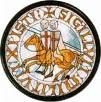
On Apr. 2, 1118 king (since Dec. 25, 1100) Baldwin I (b. 1058) dies in Egypt after eating some bad fish, and on Apr. 14 his nephew (cousin?) Baldwin II of Jerusalem (1060-1131) (Baldwin of Bourcq) (count of Edessa since 1100) becomes Latin king #2 of Jerusalem (until Aug. 21, 1131); after 300+ pilgrims are ambushed by marauding Saracens between the port city of Jaffa and Jerusalem, and other bands appear outside the walls of Jerusalem, presto-digito heah cum de judge, nine pious Christian knights from N France led by Hugues (Hugh) de Payens (Pajens) (Payns) (1070-1136) and Godfrey (Godefroi) (Gaufred) (Geoffrey) de St. Omer (huge pay-ins and gobs of free saintly lucre?) suddenly arrive at Baldwin II's palace and offer their services, claiming to have taken the vows of poverty, chastity, and obedience, plus another to protect the pilgrims on their journeys between the holy city and the coast; Baldwin bites, and the religious-military order of the Knights Templar (Order of the Poor Knights/Fellow-Soldiers of Christ and the Temple of Solomon) is founded to protect pilgrim routes in the Holy Land by Baldwin II, who grants them a HQ in Jerusalem in the E part of his palace, in the Al-Aqsa Mosque, which stands on the Temple Mount (site of the Jewish Temple of Solomon), under which the Qumran Copper Scroll (discovered in the 20th cent.) claims huge quantities of gold and valuables are buried to keep it from the Romans, who razed it in 70 C.E.; they are also given attached stables big enough to accommodate 2K horses; their seal is two men seated on the same horse, to signify their vow of sodomy, er, poverty; they are a front for the mysterious Order (Priory) of Sion, AKA Order de la Rose-Croix Veritas (Order of the True Red Cross) (Rosicrucians)?; the secular overlord is Count Hugues of Champagne (1074-1125), with spiritual leadership given by French abbot-monk (St.) Bernard of Clairvaux (1090-1153) (#1 spiritual figure in the West, a pope-maker and preventer of Jewish pogroms), who draws up their rule (sanctioned by the Council of Troyes in 1128), based on the Cistercian Rule, with the vows of poverty, chastity, and obedience, and the rule of the canons regular; the order consists of knights (allowed to wear the white mantle with large red Latin cross on the back), chaplains, and men-at-arms (servants); admission is limited to those of noble blood; org. is by commanderies, under a grandmaster; too bad, these monkish Magnificent Nine spend their first nine years, not protecting pilgrims, but locked up inside their HQ, excavating through solid rock in search of the Holy of Holies of the Jewish Second Temple, giving later conspiracy theorists plenty of dream pillow material about how they dug up some magnificent treasure or great secret they used to blackmail the papacy with, maybe some secret documents, or the Shroud of Christ - or the formula for Viagra? In 1118 the aedicula of the Holy Sepulchre in Jerusalem is rebuilt by Bolognese sculptor Renghiera Renghieri.

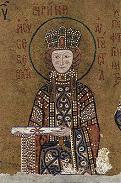
On Aug. 15, 1118 C.E. Byzantine emperor (since Apr. 1, 1081) Alexius I Comnenus (b. 1048) dies after executing Bogomils sect leader Basil the Physician (-1118) for heresy, and his short ugly swarthy (Moorish-looking) but extremely pious son John II Comnenus (Kalojoannes) (the Good) (the Beautiful) (1087-1143) becomes Roman Byzantine emperor #154 (until Apr. 9, 1143), with his wife (since 1104) Irene (Piroska) of Hungary (1088-1134) as empress, proving of high moral integrity and ability, getting compared to Roman emperor Marcus Aurelius, concentrating on taking back the old frontier on the Euphrates and the Latin states of Syria; too bad he's less than top drawer as a military leader?; his ambitious bred-to-the-purple brain woman sister Anna Comnena (Komnene) (1083-1153), who expected to have her statesman-historian hubby (since 1097) Gen. Nikephoros Bryennios (Nicephorus Bryennius) (1062-1137) take the throne plots to have her brother John II assassinated at Alexius I's funeral, but it falls through, and after her hubby chickens-out ("Nature had mistaken the two sexes and had endowed Bryennios with the soul of a woman" - Choniates), she is stifled; after hubby's death she is retired to the Convent of Kecharitomene in Constantinople, turning into a historian herself (first female historian?), writing the 15-vol. Alexiad, a panegyric on her family and father's reign which becomes a major historical source for the period, explaining why she hates the Crusaders' guts.
On June 28, 1119 after allying with Joscelin I of Edessa to put military pressure on Aleppo, causing it to ally with Turkmen Artukid (Ortoqid) emir of Mardun (1107-22) Ilghazi (Najm ad-Din Ilghazi ibn Artuq (-1122) last year, who invades, and refusing to wait for reinforcements from Jerusalem and Tripoli, leaving him with a force fo 700 knights incl. 500 Armenian cavalry, plus 3K infanty, Roger of Salerno, Prince of Antioch meets Il-Ghazi at the Battle of Ager Sanguinis (Field of Blood) (Sarmada) (Balat) near Sarmada, and Roger's army is trapped and destroyed in a place Latins later call the Field of Blood; Roger is KIA, after which the Muslims scatter to plunder the surrounding area and fail to attack Antioch, after which the Latins Crusaders led by Baldwin II defeat Il-Ghazi at the Second Battle of Tell Danith (Sarmin) (Hab) on Aug. 14; tactically the battle is indecisive, but strategically the battle ends Il-Ghazi's offensive in N Syria; Baldwin becomes regent of the principality of Edessa.
On Jan. 16, 1120 the Council of Nablus, convened by Jerusalem King Baldwin II and Patriach Warmund establishes 25 canons along with the limits of secular and religious authority, beoming the first written laws of the Latin Kingdom of Jerusalem; Hugues de Payens obtains permission from Baldwin II and Warmund to found the Knights Templar.
In 1120 the Muslim rulers of Damascus send the Arab Maan (Ma'an) Tribe from Hadramaut, Yemen to take on the Crusaders in the seaport of Beirut and keep them from moving inland; they end up settling in the SW slopes of the Lebanon Mts. and convert to the Druze Muslim sect.
On May 29, 1123 after King Baldwin II of Jerusalem is captured while patrolling in Edessa, the unsuccessful Battle of Yibneh (Yibna) (Ibelin) between Ascalon and Jaffa becomes the last attempt by the Egyptian Fatamids to invade the kingdom of Jerusalem, getting crushed by a Crusader force led by new Jerusalem regent-constable Eustace Grenier (Garnier) (-1123), who dies on June 15, and is replaced as regent-constable by Fresh, er, French prince of Galilee (since 1119) William (Guillaume) I of Bures (-1142).
On Oct. 8, 1124 after being released from Aleppo, Baldwin II turns around and sieges it, causing a relief army under Seljuk atabeg Aq-Sunqur il-Bursuqi to march S to relieve it, causing Baldwin II to mysteriously withdraw from his 3-mo. siege without a fight next Jan.
On June 11, 1125 (13?) after Aq-Sunqur il-Bursuqi receives reinforcements from atabeg of Damascus (since 1104) Toghtekin (-1128) and seiges Azaz N of Aleppo in the County of Edessa, a Crusader army of 1.1K knights and 2K infantry led by Baldwin II, Joscelin I of Edessa, and Pons of Tripoli win a decisive V over the Seljuk Turks under Aq-Sunqur il-Bursuqi at the Battle of Azaz in N Syria after pretending to retreat to draw them into the open and surround them, using the booty to ransom POWs incl. the future Joscelin II of Edessa, avenging the 1119 D at Ager Sanguinis.
In Oct. 1126 prince of Antioch (since 1111) Bohemond (Bohemund) II (1107-30) comes of age, gaining control of Antioch from Tancred's nephew Roger of Salerno, and starting a war with Edessa, causing Baldwin II to cancel plans to attack Aleppo.
On June 27, 1127 Baldwin II of Jerusalem captures Tyre after a 5-mo. siege, and reconstructs the cathedral that was destroyed in 303 C.E. during the Diocletian persecution; starting in 1244 the kings of Jerusalem are crowned here, and HRE Frederick I Barbarossa is entombed here in 1190.
In 1128 Imad al-Din Zengi (Zenghi) (Zangi) (Zengui) (Zenki) (Zanki) I (1085-1146) of Mosul captures Aleppo, Syria from the Artuquids (who held it since 1117), founding the Zengid (Zangid) Dynasty (ends 1250), which goes on to unite Aleppo and Mosul and rules parts of the Levant and Upper Mesopotamia on behalf of the Seljuk Empire, disintegrating Crusader control of N Syria and causing the Assassins (Hashashins) Cult to flee to the N Syrian coast and build the mountain fortress of Alamut in the Alborz Mts. S of the Caspian Sea in Persia, going on to stage suicide missions until the Mongols destroy their base in 1256; each leader takes the title of Sheikh (Shaykh) al-Jabal ("the mountain chief") - I start up each day with a loosening-up exercise?


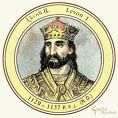
On June 2, 1129 after going on Crusade in 1120 and becoming a close friend of the Knights Templar, and being about to return to Anjou in 1127 when Baldwin II made him an offer he couldn't refuse (after William I Bures and Hugues de Payens returned empty-handed from a mission to France to find her a better hubby), Count Fulk (Fulques) V the Young of Anjou (1089-1143), marries his daughter Melisende (Melusine) (Melisanda) (1105-61) putting him in line to become king-consort of Jerusalem when he dies (1131); after Sunni Damascus ruler (since 1128) Taj al-Din Buri (-1132) orders the massacre of 6K Ismaili Muslims after hearing rumors that they are conspiring with the Crusaders to give them the strategic fort in Banias (named after the Greek god Pan) at the foot of Mt. Hermon N of the Golan Heights in return for control of Tyre, a 60K-man Latin army incl. the Templars head to Damascus with 60K troops, causing Buri to ally with Imad al-Din Zengi of Alepoo to stop them, gaining reinforcements from Hama as well as Turkomen and Arab allies; too bad, a division under constable William I of Bures sets off to gather supplies, and is intercepted by a Muslim force in Buraq (Braq) (Burak) (modern-day Al-Buraq) SE of Hama, ending the Latin offensive before the army reaches the city; meanwhile Fulk leaves Anjou (incl. Maine and Touraine) to his son Geoffrey V Plantagenet, causing Louis VI the Fat to worry about the Anglo-Norman menace.


In 1131 king (since Apr. 14, 1118) Baldwin II (b. 1060) dies, and is succeeded by his son-in-law Count Fulk (Fulques) V the Young of Anjou (1089-1143), husband (since June 2, 1129) of his daughter (Godfrey de Bouillon's niece) Queen Melisende (Melusine) (Melisanda) (1105-61) as Latin king #4 of Jerusalem (until 1153), with Melisende as joint ruler; too bad, he cuts her out of the loop and favors fellow countrymen from Anjou for his administration, proceeding to bring most of Syria under Christian control, and the Kingdom of Jerusalem reaches its peak in his reign; his marriage causes the Plantagenet family, lords of Anjou to claim descent from the Merovingians.
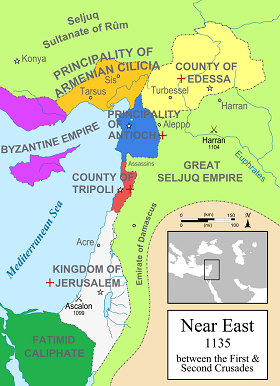
In 1136 Raymond of Poitiers, prince of Antioch seizes Levon I of Lesser Armenia by treachery, and ransoms him for 60K gold pieces, plus Saravantikar, Mamistra, and Adana, plus promise of help against the Byzantines; once released, Levon recaptures the cities and attacks the principality of Antioch allied with the Kingdom of Jerusalem (ends 1137).
In 1137 Fulk of Anjou, Latin king of Jerusalem is captured by the Zanghid Turks at Baarin in N Syria, and held for a time.

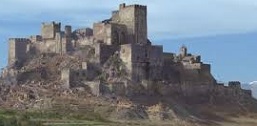
In 1142 a small Kurdish castle on the road between the Muslim city of Homs and the Christian city of Tripoli on the E end of the Mediterranean, captured in the First Crusade, is given by the Christian Count of Tripoli to the Knights of the Hospital of St. John of Jersualem, who over the next 150 years build it up into Krak des Chevaliers (Crag of the Knights), the most impregnable fortress in the world (never taken by direct attack) (see 1271). In 1142 Kerak Castle (Crac des Moabites) is built in Moab E of the Dead Sea (modern-day Jordan) by Pagan the Butler (-1148), butler of Baldwin II of Jerusalem, becoming one of the largest Crusader castles; in 1189 it is captured by Saladin.

On Nov. 13, 1143 king (since 1131) Fulk of Anjou falls (b. 1089) of his horse and dies in Acre, and on Dec. 25 his 13-y.-o. son Baldwin III (1130-63) becomes Latin king #4 of Jersualem (until Feb. 10, 1163) under his regent mother Queen Melisende, presiding over the decay of Latin power in the East after inheriting his daddy's lack of attention to the Crusader states.
On Nov. 28-Dec. 24, 1144 after Atabeg (ruler) Imad al-Din Zengi (1085-1146) of Mosul leads a Muslim jihad against the Christian Franks in the Holy Land, he sieges and captures Edessa (Urfa), and destroys the oldest Crusader principality of Outremer (founded 1098), becoming the first Crusader state to be eliminated; Mosul is on its way to becoming cock of the Muslim walk and mastering Egypt?; early next year the bad news is brought back to Europe by returning pilgrims.

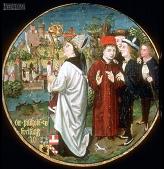
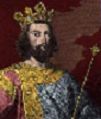
On Feb. 15, 1145 after Arnold of Brescia (who likes to crusade against the immorality of the clergy) goes to Rome and whips up the good ole pope-free Roman Senate to declare Rome independent of the papacy, with its temporal power abolished, Pope Lucius II is killed leading a small army against the Roman Senate, and on the same day Bernardo Pignatelli (Cisterian monk Bernard of Pisa) is elected Pope (#166) Eugene (Eugenius) III (-1153) (first Cistercian pope); the Roman pop. then rises and deposes Giordano Pierleoni, and invites Eugene III back; on Dec. 1 in response news of the fall of Edessa, from Bishop Hugh of Jabala (Gebal) (modern-day Lebanon), Eugene III issues the bull Quantum Praedecessores in Viterbo, proclaiming the Second Crusade, becoming the first bull on the subject of a Crusade, calling for the strongest kings of Europe to lead it, and for a route to be planned in advance; too bad, there is a ho-hum response; meanwhile Bishop Hugh of Jabala also tells bishop-historian Otto of Freising (1114-58) stories about King Prester John (John the Priest), the leader of the Nestorian sect (who aided Mongol conqueror Yeh-lu Ta-shih in his conquests), descended from one of the three Magi who visited infant Jesus, claiming he is willing to help the Crusaders, whipping the pope up; fabulously wealthy, he sleeps on a bed of sapphires, rides dragons through the air, has a fountain of youth and is 562 years old (b. 583?); meanwhile the anarchy in Rome causes Pope Eugene III to leave, and Giacomo da Vico is elected next year as the new patrician (until 1152); after arriving in Paris, Eugene III goes in pomp to the cathedral, which was in the Jewish quarter, where the Jews send a delegation to present him with a Torah, and he blesses them before eating paschal lamb with the king. Here's the evil he's become? On Dec. 25, 1145 to atone for his guilt in the massacre at Vitry-le-Francois, French king (since Aug. 1, 1137) Louis VII the Younger (1120-80) in Bourges declares his intention going on a pilgrimage to the Holy Land, but Abbot Suger and the nobles try to talk him out of it, causing him to consult St. Bernard of Clairvaux, who tells him about the papal bull and refers him to Pope Eugene III, who talks him into it.
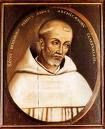

On Mar. 1, 1146 Pope Eugenius III reissues his bull calling for a new Crusade, granting the same indulgences that Pope Urban II granted for the First Crusade, and authorizes his mentor St. Bernard of Clairvaux (1090-1153) to preach it throughout France, starting at the French parliament in Vezelay, Burgundy on Mar. 31, where Louis VII, his wife Eleanor of Aquitaine, and all the princes and lords prostrate themselves at his feet to receive the pilgrims' cross, causing attacks on Jews; he induces German king (since 1138) Conrad III (1093-1152) to join it by Christmas, leaving with an army of 20K men heading for Hungary- I only have 12 bullets so you're gonna have to share?

On Sept. 14, 1146 Turkish atabed (since 1127) Imad al-Din Zengi (b. 1085) of Syria dies in Damascus, and his youngest son (of two) Nureddin (Nur ad-Din) (Arab. "Light of the Faith"") (Nur ad-Din Abu al-Qasim Mahmud ibn Imad ad-Din Zengi) (1118-74) inherits the W portion of his father's kingdom based in Aleppo, devoting his career to kicking Frankish Crusader butt; his older brother Saif ad-Din Ghazi I (-1149) inherits Mosul.
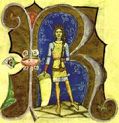
In June 1147 Louis VII of France sets out for the Second Crusade from the Basilica of St. Denis with his manly wife Eleanor of Aquitaine, leaving his kingdom in the hands of Abbot Suger; after hearing about it, the Church forbids women to join future Crusades; unlike the First Crusade, attacks on Jews are openly encouraged, with Abbe Pierre of Cluny uttering the soundbyte: "What is the good of going to the end of the world at great loss of men and money to fight the Saracens when we permit among us other infidels who are a thousand times more guilty toward Christ than the Mohammedans?" In June Conrad III arrives in Hungary, where in Aug. Louis VII hooks up with him; king (since 1141) Geza II (1130-62) asks Louis VII to be his son Stephen's godfather, launching decades of good relations between France and Hungary; Louis VII and Conrad III of Germany take separate routes to avoid conflicts.
I think we're alone now, the beating of our hearts is the only sound? In summer 1148 Conrad III's army reaches Byzantine territory, and Emperor Manuel I Comnenus permits them to move through his territory for the sake of his wife Irene (Conrad's sister-in-law Bertha of Sulzbach) (-1159); seeing his chance, the Normans under Roger II of Sicily begin a grab on the Greek-held islands, starting a war with the Byzantines (ends 1158), ravaging Euboea and Attica, plundering Thebes and Corinth, and carrying away silk workers, establishing them at Palermo, arriving outside Constantiople in Aug. On Oct. 25, 1148 after the Greeks clash with the Crusaders outside the walls of Constantinople, nearly defeating them, and Emperor Manuel I stops it with diplomacy, securing an alliance with Conrad III against Roger II of Sicily, after which the army is speedily ferried across the Bosphorus to Damalis, while the emperor stabs him in the back by giving info. on his strength and movements to the Turks, the Seljuks of Rum under Masud I defeat the 20K-man Second Crusader German army (unaided by the Byzantines) at the Second Battle of Dorylaeum (Eskishehir), and on Nov. 16 ambush and defeat the starving French army (unaided by the Byzantines) at the Battle of Laodicea (Denizli), killing or capturing most of Bishop Otto of Freising's force and selling the POWs into slavery; Conrad III and his remaining 2K men join Louis VII's army, unsuccessfully sieging Damascus.


On June 29, 1149 Edessa (Urfa) is lost again by the Crusaders, led by prince of Antioch (since 1136) Raymond of Poitiers (1115-49), prince of Antioch to the Muslims led by Turkish Zengid atabeg of Aleppo (since 1146) Nureddin (Nur ad-Din) (Arab. "light of the faith") (1118-74) (son of Imad ad-Din Zengi) at the Battle of Inab (Fons Muratus) (Murez) (Ard al-Hatim); Raymond is KIA, and seeing his way open to the Mediterranean, Nureddin rides to the coast and bathes in the sea to celebrate his V, which becomes his trademark, going on to capture the Crusader fortress of Artah, Harim, and Imm, opening the way to Antioch, which is defended by Raymond's widow Constance of Antioch (1128-63) and Patriarch Aimery of Limoges, who bought Nureddin off, going to the sea to do you know what before helping finish capturing Afamiya; the Second Crusade ends disastrously with the loss of many men in Asia Minor; on ? Conrad III of Germany leaves for Germany, and in Nov. Louis VII of France leaves for his neglected kingdom with his wife Eleanor becoming estranged from her by the ordeal - the original Paul McCartney and Heather Mills? On July 15, 1149 (50th anniv. of the capture of Jerusalem) Queen Melisende and Bishop Fulcherius consecrate the rebuilt Church of the Holy Sepulchre, which stands to modern times; an inscription is placed on the bronze main door: "This holy place has been sanctified by the blood of Christ, therefore our consecration adds nothing to its sanctity; however, the edifice which covers this holy place has been consecrated on the 15th of July by the Patriarch Fulcherius and by other dignitaries, the IVth year of his patriarchate and the 50th anniversary of the capture of the city, which at the time shone as pure gold. It was the year 1149 of the Birth of Christ."
In 1150 in this half-cent. Muslim texts on ancient Greek philosophers and scientists begin to arouse interest in Europe, and within a cent. they are getting serious and shifting into high gear; meanwhile Caliph Mustanjid of Baghdad orders all the philosophical works of Avicenna and the Brethren of Sincerity burned, and by 1200 speculative thought is kaput in the Muslim World.
In 1152 Baldwin III, Latin king of Jerusalem reaches the age of majority.
In 1153 after a 5-mo. siege Baldwin III of Jerusalem reconquers the funky ancient Philistine city of Ashkelon (Ascalon) on the Mediterranean coast from the Fatimids, annexing it to the County of Jaffa to form the County of Jaffa and Ascalon (until 1191).
In 1154 Turkish sultan Nureddin (Nur ad-Din) captures Damascus, ending the great Crusader dream, and unifies the Syrian interior.
In 1155 Raynald de Chatillon raids and plunders Cyprus, pissing-off Byzantine emperor Manuel I Comnemnus, who captures him in 1159 in Antioch, making him beg for mercy.
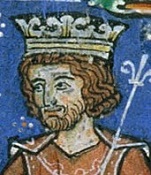
On Feb. 10, 1163 king (since 1143) Baldwin III (b. 1130) dies, and his brother Amalric I (1136-74), (2nd son of Fulk of Jerusalem and Melisende of Jerusalem) becomes king #5 of Jerusalem (until July 11, 1174).
On Oct. 27, 1168 a fleet of 230 Byzantine war ships carrying heavy cavalry on 60 special transports, landing in Damietta; meanwhile in Nov. after reneging on his deal with the caliph, King Amalric I of Jerusalem marches through Sinai, sieges Bilbays (Belbeis) and slaughters the pop., then camps outside Cairo demanding 2M pieces of gold not to invade the city; on Nov. 12 after reaching a pop. of 200K, Fustat, Egypt (founded 641) is burned down by order of vizier (since Dec. 1162) Shawar (Shawer)(-1169) to keep the pesky Crusaders from stealing its wealth, and the fire burns for 54 days and nights; the remains are absorbed by nearby Cairo (al-Qahirah) ("the Conqueror") (modern pop. 9.5M/20.4M) N of Babylon-in-Egypt, which had turned into a garbage dump; in Nov. after receiving frantic letters in Aleppo from Caliph Adhad (al-'Adid) begging for help, sends Shirkuh at the head of 6K Syrians and 2K Turkmen warriors from Damascus to Cairo, with Saladin coming along.
In 1168 Guy de Lusignan (1150-94) and his brothers of Poitou (part of the duchy of Aquitaine) ambush and kill Salisbury earl (since 1145) Patrick of Salisbury, 1st Earl of Salisbury (uncle of William the Marshal) while returning from a pilgrimage, pissing-off their overlord Richard I Lionheart, who banishes them; Guy ends up in Jerusalem by 1180, while his elder brother Amalric marries the daughter of Baldwin of Ibelin and moves on up the ladder.
On Jan. 2, 1169 after they don't pay his 2M gold piece ransom but only a 50K down payment, and instead a large army under Nur ad-Din's lt. Shirkuh appears in front of Cairo, Amalric I breaks camp and returns to Jerusalem; after his plot to kill Shirkuh and Saladin at a banquet is foiled, Shawer is murdered, and his head sent to the caliph, and Shirkuh becomes vizier, witht he caliph giving him the title Al Melik Al Mansur (the Victorious King); too bad, he dies on Mar. 26, and his 31-y.-o. nephew Saladin succeeds him as vizier of the Fatimid govt. in Egypt, working for a Shiite caliph and a Sunni caliph, ordering Nur ad-Din's name to be mentioned in Fri. prayers after Adhad's; in Aug. after backing them up against a closed gate, Saladin defeats 50K black Sudanese troops loyal to the Fatimid caliph (supported by more loyal Armenian troops), accepting their surrender on condition of safe passage to Giza, but as they are paraded down the Mukatamb Hill, Saladin's Turkish troops under orders of his brother Turan Shah suddenly slaughter them - no more mayhem, it's my New Year's resolution?
In the 1170s the Chivalric (Fr. "horsemanship") Ideal takes over European and British noble society, with everybody wanting to win his spurs as a knight.




You are everything, and everything is you? Look me in the eye, boy, you are quarterback of this team until I tell you different? In Apr. 1170 William I of Scotland visits Henry II's court at Windsor, then visits his estates in Huntingdon, then on June 14 attends the coronation at Westminster of Henry II's eldest son Henry the Young King (1155-83) as official English successor, giving him personal homage on June 15; the attempt of the archbishop of York (backed by Henry II) to do the anointing causes archbishop of Canterbury Thomas Becket (b. 1118) to get pissed-off and obtain the support of Pope Alexander III and Louis VII in a showdown, causing Henry II to exile Becket, but Henry II repents and backs down, and formally reconciles, and Becket returns to Canterbury on Dec. 25 and excommunicates three pro-Henry bishops, who flee to Henry II in Normandy, causing him to go into a rage, crying "Will no one rid me of this troublesome priest?" (probably not, but he should have?) and/or "What! Shall a man who has eaten my bread... insult the king and all the kingdom, and not one of the lazy servants whom I nourish at my table does me right for such an affront?", causing four of Henry's Norman baron knights, Hugh de Morville (1155-1204) (Fr. "dead village"), William II de Tracy (-1189) (Gael. "fierce, warlike"), Reginald Fitzurse (1145-73) (Gael. "son of the bear"), and Richard le Bret(on) (de Brito) (Fr. "the brute") to take him literally, swear an oath to kill him, and cross over to England to find him, apparently without the ing's knowledge; on the way to Canterbury they stop at Bletchingley Castle to see Earl Roger the Good de Clare (1115-73), grandson of Earl Gilbert de Clare (-1117) (an expert on hunting accidents?); on Dec. 29 (5 p.m.) they find Becket in Canterbury Cathedral at Vespers, demand that he lift the excommunications, and when he refuses they begin arguing with him and try to arrest him, and when the 6'2" dude (compared to an avg. height of 5' back then) resists, they murder him on the altar, with Fitz Urse drawing first blood, knocking off the crown of his head and spilling his blood and brains all over the floor (in the shape of a rose and lily?), after which they all close in and finish him off, then stir the brains with a sword to be sure he's dead before leaving; too bad, the locals immediately steal samples of his blood in cloths and vials, then announce miraculous cures within days, turning him into a martyr, causing anger against the king and assassins to spread throughout Europe, all to the chagrin of kingy back in Normandy, who is called the new Nero and Judas, holing-up in his chamber for three days sans food while sending emissaries to the pope to declare his innocence and promising to perform penance; Pope Alexander III uses the opportunity to save Louis VII from Henry II's wrath; Becket is hastily entombed in a crypt without bathing (since he's bathed in martyr's blood), and the cathedral soon becomes a center of pilgrimage for England's new martyr of church-state relations, with 2M+ words written about his miracles; the word "canter" comes into use from the easy Canterbury gallop which medieval pilgrims use to ride to the town; Becket is discovered to be wearing an itchy-scratchy goat-hair shirt beneath his sacerdotal robes along with breeches of the same that "swarmed with vermin", cinching his martyr status; the four bad barons do lifetime penance by becoming Crusaders in the Holy Land.
On Sept. 12/13, 1171 caliph (since 1163) Adhad (al-'Adid) (b. 1150), the last Fatimid caliph dies, ending Shiite rule of Egypt, with control reverting to the Abbasid caliphs in Baghdad under true blue Sunni Saladin, who doesn't like the suzerainty of Nureddin (Nur ad-Din) of Syria, causing them to plan a final battle; on Sept. 17 (Fri.) (Muharram 567) Saladin orders the Abbasid caliph declared in the Fri. sermon (khutba) in Fustat and Cairo, and takes the title Muhyi Dawlat Amir al-Mu'minin (Reviver of the Empire of the Commander of the Faithful), signaling the replacement of the Fatimids by the Ayyubids, while the remaindsof the Fatimid regime and Ismailism are ruthlessly exerminated, causing the Nizari Ismailis AKA the Assassins to plot a comeback; meanwhile in Sept. Jewish brain man Maimonides becomes Ra'is al-Yahud (Head of the Jews) (until 1173); meanwhile Nureddin sieges Jerusalem, sans Saladin's aid, who hopes the Crusader kingdom will serve as a buffer between Egypt and Syria, and ditto happens in 1173.
In 1172 Bohemond III of Antioch invades Armenia after it allies with Nureddin.
In 1172 Stefan I Nemanja of Serbia joins the anti-Byzantine coalition of Venice, Hungary, and the HRE, and incites the Serbian citizens of Ravno to refuse passage to Byzantine ally Henry the Lion of Saxony; Kilij Arslan II of Rum makes a pilgrimage to Jerusalem, and meets with Henry the Lion near Tarsus, embracing and kissing Henry and claiming that they are blood cousins because he descends from a daughter of Svyatoslav II.
On May 15, 1174 Syrian sultan Nureddin (Nur ad-Din) (b. 1117) dies of fever in Damascus, and his preteenie son As-Salih Ismail al-Malik (1163-1181) (son of the sister of Bertrand of Toulouse?) becomes sultan of Syria; Saladan declares himself his vassal, while planning to conquer Syria and Egypt, marrying Nureddin's widow.
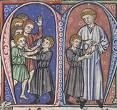
On July 11, 1174 king (since 1163) Amalric I (b. 1136) dies, and his leprous son Baldwin IV (the Leper) (1161-85) becomes Latin king #6 of Jerusalem (until Mar. 16, 1185) - the original Jason?

A little bit of rhythm and a whole lotta soul, do the locomotion with me? In 1174 Nur ad-Din (b. 1117) dies, and his empire (Damascus, Aleppo, Mosul) is distributed to his relatives and lts., causing common-born Kurdish (Sunni) officer Saladin (Salah ad-Din Yusuf ibn Ayyub) (1138-93) of Damascus to begin a series of campaigns to conquer and reunify it (ends 1185); after he overruns Syria, he is created sultan of Egypt and Syria by the caliph of Baghdad, ending the Fatimid Dynasty that ruled Egypt since 968, and founding the Ayyubid Dynasty in Egypt and N Africa, Hejaz and Yemen, Syria, and N Mesopotamia, with capital in Damascus (ends 1341), declaring himself caliph - a natty dresser, all in black, with a black turban and beard?
In 1176 after being ransomed from the gov. of Aleppo, former prince of Antioch (1153-61) Raynald (Reynald) (Reginald) of Chatillon (1125-87) marries Stephanie of Milly (1145-97), widow of Humphrey III of Toron, gaining possession of Kerak Castle and going on jihad against the pesky Muslims, harassing camel trains and attempting to attack Mecca in 1183, claiming he's trying to prevent Saladin from unifying the Muslim states - it's a mind over matter case?

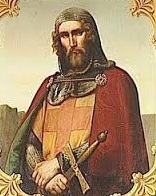
In June 1177 William "Longsword" Montferrat, Count of Jaffa and Ascalon (b. 1140) dies of malaria in Ascalon, and in Aug. his wife (since 1176) Queen Sibylla (Sibylle) (1160-90) (daughter of Amalric I, and first cousin of Henry II of England) bears Baldwin V (Baudoinet) of Jerusalem (Monteferrat) (1177-86), going on to become the love goddess of the Crusaders; in Easter 1180 after her first cousins Bohemond III of Antioch and Raymond III of Tripoli invade the kingdom of Jerusalem to force her to marry her to old fart Baldwin of Ibelin (1131-87) (older brother of Balian of Ibelin), they are headed off at the pass when her leprous brother Baldwin IV marries her to Guy de Lusignan (1150-94), brother of Jerusalem constable Aimery (Amaury) (Amalric) II of Lusignan (1154-1205) (son-in-law of Baldwin of Ibelin), a badass climber who pals with Muslim-killer Raynald of Chatillon while Sibylla wears the britches; Baldwin IV also betrothes his half-sister 8-y.-o. Isabella I of Jerusalem (1172-1205) (daughter of Amalric I of Jerusalem and Maria Comnena) to Humphrey IV of Toron (1166-98), putting her in the hands of his mother Stephanie of Milly and her hubby Raynald of Chatillon in Kerak Castle.
On Sept. 21, 1177 after Pope Alexander III intervenes on Louis VII's side, Henry II and Louis VII sign the Treaty (Pact) of Ivry, a non-aggression pact, clearing the way for the Third Crusade.
On Nov. 25, 1177 a Crusader force of 450 knights (80 Templars) and several thousand infantry under Baldwin IV, Raynald de Chatillon, and Odo de St. Amand defeats Saladin and his 9K-26K Ayyubids at the Battle of Montgisard, attacking after his army begins to disperse and securing a rare Latin V.
In 1177 Bohemond III of Antioch and Count Philip of Flanders (who arrived on pilgrimage) unsuccessfully siege Harem (Harim) in N Syria on the route between Antioch and Aleppo.
On June 10, 1179 a Latin army led by Baldwin IV and Raymond of Tripoli is defeated by the Ayyubid army Saladin at the Battle of Marj Ayyun (Ayyoun); Templar master Odo of St. Armand is blamed for his rash attack.
In 1179 Count Henry I of Champagne, who had gone to Jerusalem with French knight-relatives Peter of Courtenay (brother of Louis VII), Philip de Dreux et al. is captured while returning overland by Kilij Arslan II of Rum, who forces Byzantine emperor Manuel I to pay his ransom, after which he soon dies (1181).
The original Begin the Beguine? About 1180 the first Beguine (from the French word for begging) community for lay widows of Crusaders is established in Liege by Roman Catholic priest Lambert le Begue (Bčgue) (the Stammerer) ( Lambert li Bčgues) (-1187); the widowed babes take no vows and are free to leave and marry, and the governors are called mistresses; no wonder that after the sect spreads all over Europe they begin to be suspected of ho, er, heresy?
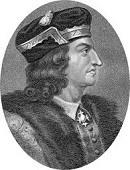
On Sept. 18, 1180 king (since Aug. 1, 1137) Louis VII the Not So Younger (b. 1120) dies, and on Sept. 18 his really young Latin-less 14-y.-o. miserable crafty hunchbacked son (no time for education now?) Philip II Augustus (1165-1223) becomes Capetian king #7 of France (until July 14, 1223); in his long reign he strives to enlarge the French royal domain (which is why they call him Augustus, although they probably mean the Augmentor?), eventually acquiring Normandy, Maine, Anjou, and Touraine at the expense of ninny King John I of England, and creating the bailii, bureaucrats that combine the functions of the English sheriffs and itinerant judges, without their roots in the local community, replacing the corrupt prevots; Philip II goes on to become known as the Maker of Paris, paving and walling it, starting construction of the Louvre, and issuing a charter for the U. of Paris, which evolves into a nice place to get a traditional liberal education (like he didn't have time for) (while Oxford tries to keep up with it?); he makes a 6-year alliance with Henry II of England so that he can take on Philip of Artois and the counts of Champagne and crush the baronial league; seeing his chance, duke Hugh III of Burgundy (1142-92) gets several nobles to change allegiance to him, pissing-off Philip II and causing him to invade Burgundy and siege Chatillon until Hugh yields, pays a high ransom for his captured son, and gives up his territorial ambitions, ending up going on the Third Crusade and becoming the most trusted ally of Richard Lionheart of England.
In 1183 Ibn Jubair tours Christian Syria, which has a larged mixed Euro-Syrian pop. after the Crusaders failed to bring their wives, and describes his fellow Muslims as well-treated by the Franks and prosperous, but complains of Acre "swarming with pigs and crosses", with a vile Euro Christian smell, wishing that one day the infidel polytheists will rise to the level of his superior Muslim civilization; meanwhile after swearing to never pardon him for his attacks on Muslim caravans, Saladin sieges Kerak Castle in Oultrejordain (Transjordan) 75 mi. S of Amman, stronghold of Raynald (Reynald) (Reginald) of Chatillon (1125-87); since he does it during the marriage of Humphrey IV of Toron and Isabella I of Jerusalem, he chivalrously agrees not to target their wedding chamber with his siege machines; the siege is quicky relieved by Raymond III of Tripoli, former (1174-6) regent of Baldwin IV of Jerusalem, who arrives carried on a stretcher; Saladin tries it again next year, with the same result, becoming the last major Muslim siege of a Crusader stronghold until Jerusalem in 1187.
In Sept. 1183 the week-long Battle of Al-Fule (La Feve) (Castrum Fabe) near Merhavia in the Jezreeel Valley 5 mi. SE of modern-day Afula, Israel is a push between the Crusader army of Guy de Lusignan and the Ayyubid army of Saladin, who is forced to retreat without capturing any strongholds after destroying many farms and villages.
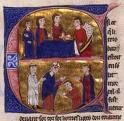
On Nov. 20, 1183 leprous king (since July 11, 1174) Baldwin IV (d. 1185) has his 6-y.-o. nephew (son of his sister Sibylla) crowned as Baldwin V (1177-86), Latin king #7 of Jerusalem after rejecting the idea of appointing pilgrim-ambusher Guy de Lusignan as regent (until Mar. 16, 1885); meanwhile Isabella I and Humphrey IV of Toron wed, keeping Guy's main backers Raynald of Chatillon and Joscelin of Courtney away from Jerusalem.
In 1183 Saladin captures Aleppo from the Zengids, who held it since 1128; it is ruled by the Ayyubids until 1260.

Where's the underground spaceship? On Feb. 10, 1185 London's Caen-stone circular Temple (Templar) Church on Fleet St. in London is consecrated by Latin Patriarch of Jerusalem (1180-7) Heraclius (Eraclius) (1128-91) of Jerusalem; damaged by the Luftwaffe in 1940 then restored; Heraclius then consecrates Clerkenwell Priory in London, founded in 1100 by Lord Jordan Briset as the HQ for the Hospitalers; burned down by Tyler's Rebellion in 1381, and rebuilt in 1504; after Henry II holds an aulic council in it, Heraclius tries to talk him into sending troops for a new Crusade, but can't talk the barons into allowing Henry to lead them personally, even in exchange for the crown of Jerusalem, causing him to utter the soundbyte: "Here is my head.... treat me as you did my brother Thomas Becket. It doesn't matter to me whether I die by your orders or in Syria by the hands of infidels, for you are worse than Saracens."
On Mar. 16, 1185 leprous king (since July 11, 1174) Baldwin IV (b. 1161) dies, and the high court (haute cour) of Jerusalem rules that a committee consisting of the pope, the HRE, and the kings of France and England have the right to choose between Sybilla and Isabella I if Baldwin V dies before reaching the age of majority, which he does next year.

In late Aug. 1186 king (since Mar. 16, 1185) Baldwin V (b. 1177) dies, and in mid-Sept. despite opposition from Raymond III of Tripoli and Balian of Ibelin, who want Isabella I, Patriarch Heraclius annoints (did I mention pilgrim ambusher?) Guy de Lusignan (1150-94) as Latin king #9 of Jerusalem (until May 1192) after Sibylla places a crown on his head.
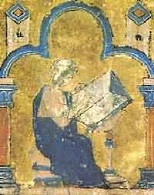
On Sept. 29, 1186 after being passed over for Latin Patriarch of Jerusalem in 1880 for his rival Heraclius, Jerusalem-born archbishop of Tyre (since June 6, 1175) dies, and Joscius (Josce) (Josias) (-1202) becomes archbishop of Tyre; too bad, after Jerusalem falls on Oct. 2, 1187, he is sent W in a black-sailed ship to appeal for aid from William II of Sicily, then to Rome, where he gives the bad new to Pope Urban II, causing him to you know what, then to France to appeal for aid from Philip II of France, Count Philip of Flanders, and Henry II of England; after the Third Crusade (1189-92) he becomes chancellor of Jerusalem for Henry II of Champagne; William of Tyre leaves History of Jerusalem (Deeds Done Beyond the Sea) (23 vols.), covering from the conquest of Syria by Caliph Umar, through the First Crusade and the Kingdom of Jerusalem up till 1184, making him the #1 chronicler of the Crusades.






On May 1, 1187 the Battle of Cresson sees the Knights Templar and Hospitalers defeated by the Ayyubids led by Saladin's son al-Afdal. Beating me, beating me down, into the ground, falling away from me? Crusaders from the Kingdom of Jerusalem break the truce and attack a caravan carrying the sister of cool all-black-wearing Kurdish Ayyubid sultan of Egypt and Syria (since 1171) Saladin (Salah ad-Din Yusuf ibn Ayyub) (1138-93), causing him to begin a holy war (jihad) against the Crusaders, invading the Kingdom of Jerusalem with his nephew Taqi al-Din and Gok-Bori and 200K Saracen troops (aided by Yaqub al-Mansur of Spain), then sieging the city of Tiberias; Byzantine Emperor Isaac I'm-No-Angelus allies with Saladin to avoid messing up his hair, and a relief army is organized by the Latins, led by Jerusalem king Guy de Lusignan, Count Raymond III of Tripoli (1140-1187), and Balian of Ibelin (1141-93) (not a blacksmith like Orlando Bloom in the 2006 Ridley Scott film "Kingdom of Heaven"?), but it gets trapped on July 4 at the Battle of the Horns of Hattin (Karnehatin) near the Sea of Galilee 6 mi. from Tiberias, and the heat-stroked Latin army is wiped out, with only 3K of 20K Christians escaping Saladin's 30K troops; after personally beheading Raynald of Chatillon, Saladin spares Guy de Lusignan with the soundbyte "Real kings don't kill each other"; the True Cross is fixed upside down on a lance and sent to Damascus, and several of Saladin's men leave his army to take their Frankish POWS with them; on July 5 Saladin captures Tiberias, allowing Countess Eschiva, Princess of Galilee (1118-87) safe passage to Tripoli with her family, followers, and possessions; on July 6 Saladin gives the Templar and Hospitaler POWs the chance to convert to Islam, and some become devout Muslims, while the rest choose martyrdom, incl. Hospitaler St. Nicasius (1135-87); Guy de Lusignan is taken as a POW to Damascus and held for ransom for a year; after Maimonides of Cairo talks him into it, Saladin permits Jews as well as Muslims to return and settle; on July 29 Saladin takes Sidon; plug-ugly Crusader Reginald of Sidon (-1202) (who speaks Arabic and grooves on Arabic lit., causing the other Crusaders to distrust him) bugs out of the rear of the Battle of Hattin and flees to Tyre, attempting to negotiate its surrender to Saladin until Conrad of Montferrat arrives and kicks him out, causing him to flee to the Crusader stronghold of Beaufort after finding that Saladin has captured Sidon, where he holes-up until 1190. On Sept. 20 after conquering Acre, Ibelin, Nablus, Toron, Sidon, Beirut, Ramla, and Ascalon, giving Balian time to organize the city defenses and create 60 new knights from the burgesses to supplement the 2-14 he had, Saladin begins the Siege of Jerusalem, and after knocking down some walls but finding the Christian diehards prepared to destroy the city and kill each other rather than surrender, he shows why he's a wise and honorable sport and permits the fashion model Queen Sibylla, the Christian defenders, and most of the Christian pop. to leave with safe passage, ransoming 18K people (incl. 7K men) for 30K bezants (with two women or 10 children being equal to one man for the same price), the remaining 15K being forced into slavery after a 40-day payment period lapses; on Oct. 2 Balian of Ibelin hands over the keys to the Tower of David, and the Christian losers march away in three columns, with Balian and Patriarch (since 1180) Heraclius (Eraclius) (1128-91) leading the last one on Nov. 20, ending the Latin Kingdom of Jerusalem (founded 1099); although he does not sack the city, Saladin ravages the Church of the Holy Sepulchre and turns it into a mosque, stripping the gold reliquaries and carrying away cartloads of treasure, later returning it to the Christians after an agreement with Byzantine emperor Isaac II Angelus; the hostages end up in Tripoli; Heraclius and Sybilla take refuge in Antioch; Saladin goes on to capture all Crusader territory except the seaport of Tyre, which remains in the hands of the Franks, and the cities of Antioch and Tripoli. On Sept. 27 after Stefan I Nemanja of Serbia attacks the Repub. of Dubrovnik, and Norman reinforcements arrive to help them, he signs a peace treaty declaring eternal peace, with nominal rule by Serbian kings, and the statehood of the repub. guaranteed. On Oct. 20 Pope (since 1185) Urban III allegedly dies of a broken heart after hearing the bad news from the Holy Land at Ferrara while en route to excommunicate HRE Frederick I Barbarossa for his antics, and on Oct. 21 Cardinal Alberto de Morra is elected Pope (#172) Gregory VIII (-1187), but he dies on Dec. 17 after only 1 mo. 27 days after proclaiming the Third Crusade and making overtures to reconcile Frederick I with the Church so he can be free to kick Muslim butt and get the Holy Sepulchre back, and on Dec. 19 Roman-born Paolo Scolari is elected Pope (#173) Clement III (-1191), immediately seeking to heal the old rift between the papacy and the Roman pop.
In Jan. 1188 after hearing of the bad news from Jerusalem from the archbishop of Tyre, France and England make a truce on the battlefield, and the archbishop persuades Philip II Augustus of France, Henry II of England, and his son Richard I Lionheart to pledge themselves to a crusade on the spot, declining the crown of Jerusalem but levying the Saladin Tithe (Aid of 1188) (a tenth of the value of incomes and chattels, subject to adjudication by a local jury) in aid of the Holy Land, becoming Henry II's 2nd taxation of personal property; in Feb. Pope Clement III triumphantly returns to Rome, and begins massing Christian soldiers against the Muslims for his delightful blood-drenched Third Crusade (ends 1192), the first to feature personal insignia on shields; Guy de Lusginan is released by Saladin, gains naval reinforcements from Pisa and sieges Acre in Aug., but is unsuccessful after Saladin's troops siege them; Saladin uses Damascus as his HQ during the Crusade; during the negotiations in the Champ Sacre (Sacré) (Sacred Field) of Gisors in Normandy, Henry II and his men (incl. Richard I Lionheart) hunker down under the 800-y.-o. Elm of Gisors, leaving Philip II and his men in the sun, ending in a battle in which the French take the elm and cut it down; after this incident, the Order of Sion splits ranks with its child the Templars, with Jean de Gisors (1133-1220) (vassal of Henry II and Richard I until 1193, who owns Titchfield Manor in Hampshire, England, and allegedly met Thomas Becket at Gisors in 1169) becoming the first Grandmaster (Nautonnier) (Pilot) of the Order of Sion (until 1220), which changes its name to the Priory of Sion, and makes every grandmaster assume the name Jean or Jeanne to indicate an esoteric successor to St. John, with Jean de Gisors calling himself Jean II; the Priory of Sion adopts the subtitle Ormus (Ours is Fr. for bear, Orme is Fr. for elm, Or is Fr. for gold), and begins calling itself the Order of the True Red Cross (Rose-Croix Veritas) (Rosicrucians?).


In 1188 Canterbury archbishop (1185-90) Baldwin of Forde(e) (1125-90) and Welsh-born Gerald of Wales (Giraldus Cambrensis) (1146-1223) preach the Third Crusade in Wales; Gerald of Wales pub. Itinerarium Cambriae in 1191, followed in 1194 by Description Cambriae.

In Jan. 1189 Saladin utters the soundbyte: "I shall cross this sea to their islands to pursue them until there remains no one on the face of the earth who does not acknowledge Allah" - he proved to be right, 1900 years later? On July 6, 1189 after Richard Lionheart delays his trip to the Holy Land immediately and joins his father Henry II (b. 1133) of England on an attack on Raymond of Toulouse, and Philip II comes to Raymond's aid, and Richard in a fit of anger at hearing that his brother John is now daddy's favorite switches sides, invading Henry's heartland of Anjou with Philip II and taking NW Touraine, after which Henry II is driven from Le Mans (his birth town, dear to his heart) to Saumur, defeated, forced to pay homage to Philip II for all his French possessions and acknowledge Richard as his heir, he is harried to his death in Chinon, cursing his sons with his last breath, after which Richard pays respects to his corpse as it is taken to Fontrevaud Abbey, upon which "blood flowed from the nostrils of the deceased, as if... indignant at the presence of the one who was believed to have caused his death" (Roger of Wendover); he gets the last laugh with pesky martyr Thomas Becket when secular courts begin taking jurisdiction from clerical courts, liberating English law from feudal and ecclesiastical constraints and making it as supreme as in imperial Rome; on Sept. 3 French-speaking eldest remaining son Richard I Lionheart (Coeur de Lion) Plantagenet (1157-99), a military adventurer and leading trouvere (not much of an administrator type, infected with the skeptical culture of Provence and the gay science of the troubadours, making him English in name only?), who owns the Cognac region in W France is crowned the 26th monarch and Plantagenet king #2 of England (until Apr. 6, 1199), releasing his mommy Eleanor of Aquitaine from imprisonment (since 1173); he spends the next 5 mo. raising money to go on Crusade, appropriating the royal treasury, removing thousands of officials and selling them their offices back, and selling charters of freedom to cities; in his 10-year reign he only visits England twice, for a few mo. at a time, and only to obtain money for going on Crusade; he plays the part of a good Crusader and bans Christ-killing Jews from the coronation, after which the London pop. gets it mixed up and thinks he ordered their extermination, massacring them for Christ, the pogrom spreading to Lincoln, Stamford, and Linn; the London pogrom was started by nobles trying to get out of debts owed to Jews?; a mob led by Richard de Malabestia kills 300 Jews in York; 150 Jews led by Rabbi Yom Tob commit suicide; Richard I forgives William the Marshall for attemped murder, as the sonnet by Lord Dagonell Collingwood goes, "Count Richard forgave King Henry's knight, for William did only what he knew was right"; the Scottish church, which Henry II had subordinated to the English makes itself directly answerable to the pope in an attempt to retain independence; on Dec. 5 Richard I annuls the 1174 Treaty of Falaise for 15K (10K?) marks in the Quitclaim of Canterbury to help finance his war against the Sacrilegious Saracens, and the Scots avoid being permanently swallowed-up once again, with William I now at the height of his power, enjoying a golden decade and becoming known as the Lion of Justice.
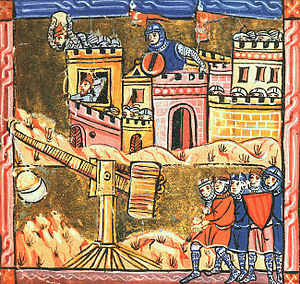
On Aug. 28, 1189 the Siege of Acre begins (ends July 12, 1191), with Saladin attempting to exterminate the pesky Crusader kingdom, and the Crusaders led by Guy de Lusignan of Jerusalem holding out at high cost, becoming the first time that the king of Jerusalem has to personally defend the Holy Land from the pesky Muslims; it starts with Lusignan's Crusader army of 3K men arrives and attempts a surprise-attack on the 6K-man Muslim garrison, fails, and sets up camp outside the city, causing Saladin to arrive on Oct. 4 with 20K men, meeting the reinforced Crusader army of 7K infantry and 400 cavalry, with the Templars advancing on Saladin's right wing and put them to flight, then stoop to loot and retreat, causing Saladin to send his light cavalry, which slaughters them, killing 4K-5K until Christian reinforcements arrive, causing Saladin to retreat the Crusaders to blockade Acre by land, receiving news of the imminent arrival of HRE Frederick I Barbarossa, along with the arrival of former Latin patriarch of Jerusalem Heraclius, pumping them up.

Don't rock the boat, baby, don't tip the boat over? In 1189 German "I never learned to swim" HRE (since Jan. 2, 1155) (2nd Crusade veteran) Frederick I Barbarossa (1122-90) leads the totally lay and royal Third Crusade (ends 1192), leading an awesome 100K-man German Crusader army from Regensburg via Hungary to Bulgaria, stopping at Nis, Serbia, where Stefan I Nemanja tries unsuccessfully to talk him into changing to a war against the Byzantines, until a Byzantine force tries to block him from reaching Sofia, causing him to plan an offensive against Constantinople, for which Nemanja offers 20K men, while Bulgarian leaders Ivan Asen I and Peter IV (have some lemonade, check out all the trees?) offer him 40K more; too bad, it all falls through since Freddie wants safe passage into Anatolia; meanwhile the Latin Crusader army sieges Acre, and turns on Saladin's army as it is hindering their efforts, winning initial success, breaking into Saladin's camp using crossbows and cavalry, but the ensuing breakup of the ahem, Christian army as it turns to looting gives the Muslims the opportunity to regroup and bring in fresh reinforcements, resulting in 7K Christian soldiers killed; Saladin captures the Crusader castles of Montreal and Kerak; meanwhile the Bulgarians defeat the Byzantines at the Battle of Berrhoe; William II of Sicily, husband of Richard I Lionheart's sister Joan dies while planning to lead the Third Crusade; Hamburg receives a charter from HRE Frederick I Barbarossa in return for services rendered during the Third Crusade, making it a free imperial city and giving it important commercial privileges.






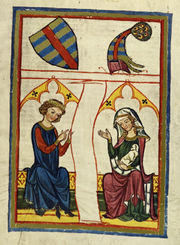
You didn't have to shake it but you did, you did, you did, and I thank you? In 1190 the Third Crusade is led by the Big Three of Christendom, German HRE (since 1155) Frederick I Barbarossa (1122-90), English king (since 1189) Richard I Lionheart (Coeur de Lion) Plantagent (1157-99), and French king (since 1180) Philip II Augustus (1165-1223), while Pope (since 1187) Clement III (-1191) tries in vain to get in charge to get the credit for this lay effort?; Austrian duke Leopold V (1157-94) also goes, accompanied by Alsace-born minnesinger Reinmar the Old of Hagenau (-1207); on Feb. 14 Frederick I (b. 1122) signs a peace with the Byzantines in Adrianople, allowing him to pass through undisturbed; in Mar. Richard I leaves on Crusade after raising mucho dinero, becoming known for squeezing his subjects while enjoying luxury and lavish feasts; too bad, after getting through Rum, on June 10 Frisky Freddy (b. 1122) is drowned in the 150-mi.-long Saleph (Goksu) (Göksu) River in the Taseli Peninsula in Cilician Armenia in SE Asia Minor in hip-deep water while bathing (heart attack from the shock of the cold water?) after the Holy Lance of Christ slips from his hands, causing his 15K-man (100K-man?) Crusader army (incl. 3K knights) to panic and disintegrate under Turkish attacks as the Muslims attribute his death to the will of Allah and get pumped up, with only 5K reaching Acre; after attempts to preserve Drop Dead Fred's body in vinegar to bury him in Jersualem fail, his bones are buried in Cathedral of Tyre, his flesh is buried in the Church of St. Peter in Antioch, and his heart and internal organs in Tarsus; his eldest son (by Beatrice of Burgundy) Henry VI (1165-97) succeeds him as German Hohenstaufen king #3 (until Sept. 28, 1197), and his 3rd son Frederick VI of Hohenstaufen, Duke of Swabia (1167-91) becomes leader of the remnants of the Crusader army, leaving Richard I and Philip II as the real leaders of the Crusade.



In spring 1191 Crusaders Richard I Lionheart of England, Philip II of France, incl. Templars and Hospitallers, Angevins, Bretons, and Flemings under James (Jacques) (Jacob) of Avesnes (1152-91) set sail to attack the Holy Land, and Richard I Lionheart stops in Rhodes to drop off his sister Joan Plantagenet (1165-99) (widow of William II of Sicily) to talk Sancho VI of Navarre into agreeing to give him his eldest daughter Berengaria of Navarre (1165-1230) in marriage so that he can get his hands on Navarre (dumping Alys, his betrothed), and when they leave to follow him and get shipwrecked by a storm on Cyprus, hot-headed Cyprus despot (since 1184) Isaac Comnenus (Komnenos) of Cyprus (1155-96) captures them, pissing-off Richard and causing him to turn around (or get blown there by a storm), land in Lemesos (Limassol) on May 6, conquer it, then kick Comnenus' butt at the Battle of Tremetusia, and trick him into surrendering at his Kantara Castle on Cape St. Andreas on the Karpas Peninsula by promising not to put him in irons, after which he uses silver chains (ha ha), and turns him over to the Knights of St. John, who keep him in Margat (near Tripoli) until 1194, after which he travels to the sultanate of Rum to gain support, and ends up poisoned; Richard then marries Berengaria on May 12 in Limassol at the Chapel of St. George, the wedding attended by Prince Levon of Cicilian Armenia (ever eager to get noticed so they can promote him to king?), and decides to use Cyprus as a Crusader supply bridge to Jerusalem; Richard buys two Arabian horses in Cyprus, which he puts gold bridles on, causing them to be called brigliadores; Comnenus' daughter "the Damsel of Cyprus" joins Richard's court, and travels back to England with Joan; meanwhile Egyptian sultan Saladin conquers Haifa, and dismantles the city of Ashkelon on the Mediterranean coast; in Apr. the French under Philip II Augustus and Conrad of Montferrat arrive at Acre after Philip's nephew Count Henry II of Champagne beats him to it, then erect huge siege engines; the English under Richard I Lionheart arrive on June 9 and take contol of the siege, using sappers to undermine the walls; Richard offers his men first one then four gold coins to race across the open plain dodging Saracen bowmen and hot oil-slingers and pull a single stone from Acre's thick wall; on July 12 after their supplies run out, Acre, AKA Ptolemais surrenders to the Crusaders; Philip II gets sick and accuses Richard I of trying to poison him, and returns to France, making final capture of Jersualem impossible, as if that would stop them?; the Crusaders demand the delivery of 1.6K Christian captives, payment of 200K dinars, delivery of the True Cross, and allow the pop. of Acre to leave on the condition that they carry nothing but the clothes on their backs; too bad, on Aug. 11 an exchange of POWs and moolah is aborted after the Crusaders quibble; on Aug. 20 after Saladin takes too long to respond, Der Fuhrer Richard I orders the execution of 2.7K Muslim hostages, "avenging their fallen comrades who had died at Acre", slicing open their bellies looking for swallowed treasure; Saladin responds in kind, ordering the execution of all 1.6K Christian POWS, and hiding the True Cross (under the doorway of the Mosque in Damascus?); Isaac Comnenus of Cyprus surrenders to Richard I, who imprisons him in the Syrian castle of Markab; after Richard I unsuccessfully backs his vassal Guy de Lusignan for king of Jerusalem over the German candidate Conrad of Montferrat, Guy gives the Hospitallers a portion of the tower in Acre, and Richard I sells Cyprus to Guy and the Knights Templar, and Guy becomes king of Cyprus next year (until 1194); the Crusaders rule Acre for the next cent; meanwhile after Richard I insults Duke Leopold V of Austria by throwing his banner into the acres of mud of Acre, the latter invents the red-and-white triband Austrian Flag when there is a white strip of cloth found under his bloody tunic after the battle; in Aug. knowing they need to control the port of Jaffa before taking Jerusalem, the Crusaders leave Acre and go S, and, after being harassed all along the way by archers finally defeat Saladin on Sept. 7 at the Battle of Arsuf near Jaffa, remembering the lessons of the Horns of Hattin and taking measures against heat exhaustion and thirst, although they are tormented at night by tarantulas; on Aug. 30 as they approach Caesarea, the rear guard under Duke Hugh III of Burgundy is cut off, but Richard rallies his troops to save them with the cry "Sanctum Sepulchrum Adjuva!" (Help us, Holy Sepulchre!); during the battle the Muslims are sorely pressing the Crusaders, until Hospitaler grandmaster Garnier de Nablus disobeys Richard's orders and goes beserk and leads a charge, which Richard decides is their big chance to turn the tide, after which Richard "advanced with untiring sword strokes, cutting down the unspeakable race as if he were reaping the harvest with a sickle, so that the corpses of Turks he had killed covered the ground everywhere for the space of half a mile"; Saladin's myth of invincibility is shattered, with 7K Muslims killed vs. 700 Christians (according to the Christians); the slap-happy Crusaders then recapture St. Peter's old Dorctown of Jaffa, although Big J is out of their grasp and they decide to cut off Saladin's main supply base of Egypt instead.


On Apr. 2, 1192 Richard I Lionheart of England sends his rep. Henry II of Champagne from Acre to Tyre to inform Conrad of Montferrat of his election as Latin king of Jerusalem, but on Apr. 28, a few days after Henry returns Conrad is murdered by two hashashin in Tyre, and when Henry is sent back to Tyre two days later to help with his coronation, he finds a funeral instead, and eight days later after supposedly wowing her with his virility (being 20 years younger than Conrad) he marries Conrad's pregnant widow Isabella of Jerusalem (1172-1205) (daughter of Amalric I and Maria Comnena), and becomes king of Jerusalem (until 1197); on July 29 the Crusaders, incl. 80 knights and 2K Genoese crossbowmen recapture Jaffa from 7K Muslim cavalry troops, and reach Jerusalem but fail to capture it, and on Sept. 2 after a trial balloon proposal of a marriage of Saladin's brother to Richard I's sister Joan, with Big J invested to the lucky groom, the Crusaders give up fighting for Christ and agree to the 3-year Peace of Ramlah (Ramleh) with Dinner Salad, er, Saladin, giving the Christians a strip of steak, er, coastal territory between Jaffa and Acre, plus access to Jerusalem, and it takes until 1229 for the Christians to recapture Big J; Guy de Lusignan resigns his title of king of Jerusalem, but still has the serviceable launchpad island of Cyprus (until 1194); meanwhile new king Henry II of Champagne meets with the Assassins in their fortress stronghold of al-Khaf, smokes, er, watches two of the fanatics kill themselves to prove what robots they are, then signs a treaty with their grandmaster, causing speculation of a plot with Richard to knock off Conrad all along - get my caddy and my calculator? On Oct. 9 Richard I returns from the Crusades, but suffers from seasickness and decides to cross the Alps disguised as a Knight Templar; too bad, he is captured on Dec. 11 at an inn near Vienna by his enemy Duke Leopold V of Austria (1157-94), then imprisoned (in violation of an unwritten law that Crusaders can't be detained) by orders of grudge-bearing HRE Henry VI in a dark castle in Durnstein (Durrenstein) on the Danube River on Dec. 21 (until Feb. 4, 1194); after his return to France Philip II Augustus begins scheming with Richard's brother John Lackland, getting Normandy handed over by secret treaty; Philip II tries to get Richard I handed over to him as his prisoner, but is refused.


On Mar. 4, 1193 Saladin (b. 1137) dies in Damascus, and his Ayyubid Dynasty lands in Egypt and Syria are split between his family and lts. (until 1200). Hubert Walter becomes archbishop of Canterbury, then justiciar in 1194-8, ruling England in Richard's absence while keeping Prince John in check; Richard I is handed over to HRE Henry VI, who imprisons him in a secret location, demanding a huge ransom of 150K marks, double the annual revenue of the English crown; Richard I's mother and regent Eleanor of Aquitaine and her justiciar Hubert Walter attempt to raise his ransom by taxation of his English subjects, while Philip II violates his pledge and attacks and seizes English possessions in France, and both he and King John try to outbid them to keep him in captivity; Richard I writes a ballad while imprisoned, appealing to his countrymen to pay the ransom; William I of Scotland opposes John's attempts to seize power, and contributes 2K marks to Richard's ransom; meanwhile after much searching, Richard is found in Durnstein by his traveling minstrel Blondel de Nesle (1155-1202), who hears his master's voice singing along with a minstrel from the dungeon, then returns to England and reports it; the ransom money is used to build walls around Vienna - all right, you're not the person you were before you got rheumatic arthritis?
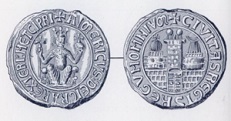
On July 18, 1194 Guy of Lusignan (b. 1150) dies in Nicosia, and his brother Aimery II of Lusignan (1145-1205) succeeds as ruler of Cyprus (until 1205), going on to accept investiture in 1196 as king #1 from HRE Henry VI.
On Aug. 14 (Oct. 11?), 1196 St. Meinhard dies, and Bertold becomes bishop #2 of Livonia, arriving in Riga with a Crusader army to force the pesky pagan Finnic Livs to convert; too bad, they defeat the army and kill him, pissing off Pope Innocent III, who issues a bull declaring a Crusade against the Livonians.






In Apr. 1201 (Lent) Fourth Crusade envoys Geoffrey I of Villehardouin (Geoffroi de Villehardouin) (1169-1229) (Marshal of Champagne), Doge (1192-1205) Enrico (Henricus) Dandolo (1107-1205) et al. conclude the Treaty of Venice, with Venice, agreeing to transport 33.5K men and 4.5K horses in return for a 85K mark payment, and leave on June 29, 1202 for Egypt, which is thought to be the best route to the Holy Land; on May 24 Crusade leader Count Theobald III of Champagne (b. 1179) dies in Troyes, and his posth. son (born on May 30) Theobald (Thibaud) (Thibault) IV (the Troubadour) (the Chansonnier) (the Posthumous) (1201-52) succeeds him as count of Champagne in France (until July 8, 1253), immediately facing crushing debts from his crusading uncle Henry II of England, plus a succession dispute by Henry II's daughter Philippa and her hubby Erard I of Brienne, Count of Ramerupt (1170-1246), which takes until 1222 to resolve by buying him off; meanwhile in June the Assembly of Crusaders in Soissons elects famous Lombard soldier Marquess Boniface I of Montferrat (1150-1207) to lead the Crusade. On Dec. 25 a meeting is held in the forest town of Hagenau in Alsace-Lorrane between Philip of Swabia, dethroned Byzantine emperor Isaac II Angelus' son Alexius (brother of Philip's wife Irene), and Boniface, where a successful pitch is made to divert the Fourth Crusade to Constantinople to reinstate Isaac I, obviously in return for much baksheesh?

Ain't it good to know you got a friend? On Apr. 20, 1203 the Fourth Crusaders leave Zara for Corfu, then take Durazzo, where Isaac II Angelus' son (by his wife Margaret of Hungary) (the Crusaders' eager-to-please accomplice) Alexius IV Angelus (Alexios IV Angelos) (1182-1204) is proclaimed emperor, and on June 23 they arrive in Constantinople and begin a siege, causing Alexius III to flee to Adrianople on the night of July 18, after which they free and restore Isaac II Angelus, and make him proclaim Alexius IV co-emperor on Aug. 1, becoming Roman Byzantine emperor #160 (until Jan. 28, 1204); as the Crusaders' puppet Alexius IV bankrupts the treasury to pay them a heavy tribute of 100K marks, and the Greek and Roman churches are remarried for the time being, on paper, but not in reality, as the patriarch has no intention of going to Rome to request the grant of the pallium and the believers ain't about to change any of their ways; meanwhile Alexius asks the Crusader army to delay their planned Sept. 29 (Michaelmas) departure for Syria for one year, giving them time to discover how totally incompatible they and their new bride are, resulting in spousal abuse and a permanent dysfunctional relationship?



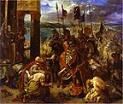


Everyone wants an old school lord and master? On Jan. 1, 1204 after some Crusaders attack a mosque in Constantinople, causing citizens to confront them, and a fire ravages a section of the city, causing the Latin pop. to take refuge in the Crusader camp, Byzantine emperor Alexius IV launches fire ships at the Venetian fleet, which they stop; on Jan. 25 after pissed-off Greeks mad about paying money to stinkin' heretic Latins start a riot, Alexius III's son-in-law Alexius V Ducas (Alexios V Dukas) Mourtzouphlos (Gr. "bushy eyebrows"?) (1140-1204) sees his chance and has Alexius IV Angelus (b. 1182) and Isaac II Angelus (b. 1156) arrested and killed on Jan. 27/28, and is crowned as Roman Byzantine emperor #161 on Feb. 5 (until Apr. 12), ending negotiations with the Crooked Crusaders and refusing to make any more payments, while strenghtening the city defenses, personally leading a surprise attack on the Crusader camp and beating back a Crusader assault on Apr. 9; too bad, on Apr. 12-13 soldiers of the Fourth Crusade, comprised of French nobles and their followers, as well as Venetians and Flemings (OE "men from the lowlands"), surprise, capture, and Sack the Hell Out of Constantinople, then rub this date rape in by declaring it a marriage, announcing the Latin Empire of the East (Romania), based in Constantinople (ends 1261), conveniently cutting Venice's rival "La Superba" Genoa (who is backed by Greece) out of the trade routes; Alexius V ducks out and escapes to Mosynopolis in Thrace, HQ of deposed emperor Alexius III, and marries his daughter Eudocia Angelina, until his new father-in-law turns on him and has him blinded and cast out, after which the Crusaders under Thierry de Loos capture him in Nov., bring him back to Constantinople, condemn him for treason against their puppet Alexius IV, and throw him from the top of the Theodosian Column in Dec., and he becomes the last Byzantine emperor in Constantinople until 1261; Boniface of Montferrat captures Boukoleon Palace on the shore of the Sea of Marmara, discovering a gaggle of women incl. Empress Margaret, daughter of Bela II of Hungary, whom he marries; happy camper Pope Innocent Three Times is the Charm declares the Great Schism ended, but the icon-loving Greeks refuse to give up that easy, and the result is its permanent hardening within two generations as the rapee tries to get loose and turn states' evidence or set the bed on fire?; a council composed equally of Crusaders and Venetians divides the Eastern Empire, giving the imperial crown to Count (since 1194) Baldwin of Flanders, crowning him Baldwin I (1172-1205), Latin emperor #1 of the East on May 16 in the Hagia Sophia in Constantinople (until 1205); Thomas Morosini (1170-1211) of Venice replaces the Greek patriarch, becoming the first Latin patriarch of Constantinople (until July 1211); Boniface of Montferrat is made king of Salonika (Thessalonica), which incl. part of Thrace, Macedonia, and Thessaly; the rest of the empire is split up among various baron vassals; Venice receives three-eighths of the city, plus Adrianople, Gallipoli, Crete (until 1669), Euboea (a triarchy), Naxos, Andros, the SW tip of the Peloponnesus (Coron and Modon), Durazzo and other posts on the coast of Epirus, the Ionian islands, and some islands in the Aegean; some believe the Shroud of Christ is taken back to France among the huge loot of holy relics by Knight Templar Richard de Clare, 4th Earl of Hertford (1162-1218), along with many priceless treasures melted down into coins; the looting happened because the Venetians, who supplied the ships took so long that many Crusaders made their own way and thus underbooked them, causing them to look for a way to get paid?; actually the long-simmering animosities between Venice and Constantinople, exacerbated by religious rivalry and that old Greek-Roman thang helped to breed a bank-robber-in-the-family mentality?; Pope Innocent III professes to be (really is?) shocked (innocent?), along with most of Europe, and excommunicates the Venetians for it, but makes hay of his opportunity to Latinize the Greek Orthodox Church, hardening the schism further; in 1207 after living through the Apr. 13, 1204 battle for Constantinople between the W Euro Roman Catholics and Byzantine Orthodox Catholics, French marshal of Champagne Geoffrey of Villehardouin (Geoffroi de Villehardouin) (1160-1212) begins writing De la Conquete de Constantinople (On the Conquest of Constantinople), a 3rd person memoir in lovely French, becoming one of the first works of French prose - another day here in the park, I think it was the Fourth of July, or, what a lady what a night, or, get that icon down? On Nov. 14 Pope Innocent III writes to the Roman Catholic clergy in the East, calling the transfer of imperial power in Constantinople from the Greeks to the Latins "the Lord's doing, and it is marvelous in our eyes", a quote from Psalms 118:23; the overthrow of the Byzantine Empire leads to successor Latin states in Greece; Michael I Comnenus Ducas (Michael I Komnenos Doukas) (1170-1214) sets up the independent Greek Empire (Despotate) of Epirus (ends 1340, then 1356-1479), which attempts to expand to the E and lasts until the Turks take it over in the 15th cent.; Theodore I Comnenus Lascaris (Theodoros I Komnenos Laskaris) (1174-1222), son-in-law of Alexius III founds the Empire of Nicaea in Bithynia (which eventually becomes top dog) as Theodore I (until 1221), and makes an alliance with sultan Kilij Arslan III of Rum to block the Crusader advance into Anatolia, but is defeated by the Crusaders under Peter de Bracheuil; Alexius III and David Comnenus sets up the Empire of Trebizond (Trapezuntine Empire) on the N coast of Anatolia, with Alexius at Trebizond and David at Sinope (ends 1461); the capture of Big C ends trade with Kiev, causing it to further decline until its final destruction by the Mongols in 1240; after they pass him as Latin emperor of Constantinople for Baldwin of Flanders because his brother Conrad married into the Byzantine royal family, the Venetians send Crusade leader Boniface of Montferrat (1150-1207) to conquer Thessalonica, which he does, founding the Kingdom of Thessalonica (ends 1224), which acknowledges subordination to Baldwin I, expanding by next year S through Thessaly, Boeotia, Euboea, and Attica; meanwhile crusading barons led by Burgundian nobleman Otto (Othon) II de la Roche (1170-1234) conquer Attica and the Peloponnesus, and he becomes the first duke of Athens (until 1225), acquiring Thebes by 1211; Bulgarian Tsar Kaloyan uses the opportunity to firm his kingdom up, seizing W Macedonia and aligning with Pope Innocent III, who sends a papal legate to crown him, along with a primate for Bulgaria.
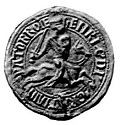
The Latins take over Byzantium only to inherit their problem with the Bulgar buggers? On Apr. 14, 1205 the Bulgars under Kaloyan, supported by the Cumans and local Greeks kick Frankish Crusader butt at the Battle of Adrianople, and capture Emperor Baldwin I (b. 1172), imprison him in Baldwin's Tower in Veliko Tarnovo, then kill (poison?) him; after receiving the bad news, next Aug. 20 his brother Henry of Flanders (1174-1216) succeeds him as Henry I, Latin emperor of Constantinople #2 (until June 11, 1216) (the ablest of the Latin emperors?) while the Bulgars overrun Thrace and Macedonia and exterminate much of the Greek pop.

In 1205 Guillaume (William) de Champlitte (1160-1209) and Geoffrey of Villehardouin conquer Achaea, and divide it into 12 feudal baronies on the French pattern (until 1278), with William I of Champlitte becoming prince #1 of Achaea (until 1209); the Achaean armorial is a cool yellow Latin cross on a red shield; despite being run by Roman Catholics, the Orthodox Greco-Slavic pop. is well treated and the govt. is popular with them?

In 1206 Spanish Castilian priest St. Dominic (Domngo Felix de Guzman) (1170-1221) attempts to convert Albigensians in Prouille, France with litttle success until he allegedly receives a vision of the Blessed Virgin, who gives him the Rosary as a tool against heretics, going on to found the Dominican Order (of Preachers), which is approved by Pope Honorius III via the bull Religiosam vitam of Dec. 22, 1216.
On Jan. 15, 1208 a knight working for Count (since 1194) Raymond VI of Toulouse (1156-1222) kills papal legate Pierre de Castelnau, and Pope Innocent III deposes him for it; the pesky Byzantine heretics seemingly in hand, Pope Innocent III first vainly appeals to Philip II of France, who refuses to get involved, then proclaims a Crusade against #2 on his list, the Cathars (Albigensians) (Catharists of Albi) ("Western Buddhists"), a sect of too loose heretical dualistic vegetarians in S (Provencal) France centered in Toulouse, which started out as a reaction against clerical corruption but was joined by the nobles as a way to appropriate Church lands, becoming fabulously wealthy and getting mixed-up with the Templars; believing that Christ was a prophet of Amor (love), they refused to make a big deal of the Crucifixion, which they regarded as an emblem of Rex Mundi (Lord of the Material World), which has twisted Amor into its opposite, Roma, also denying the sacraments of Baptism and Communion, and practicing birth control and abortion, accepting reincarnation and the female principle, allowing women parfaits (priests), and insisting on direct personal contact with God rather than mere faith; looking for a get-out-of-purgatory-free card, Duke Eudes III of Burgundy steps up to the plate and organizes a campaign against the Cathar strongholds in Languedoc next year, starting the Albigensian Crusade (ends 1229). On July 22, 1209 after 30K Crusader knights and foot soldiers under Simon de Montfort storm Languedoc in SE France along the Garonne River, the most advanced and civilized section of France, known for religious tolerance along with mass abandonment of Roman Catholic faith, 15K-20K are massacred in Beziers (Béziers) after an officer allegedly asked a papal rep how to distinguish Cathar heretics from true Roman Catholic believers, and was told "Kill them all, God will recognize his own"; they then do ditto to Perpignan, Narbonne, Carcassone, and Toulouse.
On June 30, 1208 after invading Thrace and defeating the Crusaders in June at the Battle of Beroia (Stara Zagora), 33K Bulgarians under Boril are defeated by the main Crusader force of 2K knights plus several thousand soldiers at the Battle of Plovdiv (Philippopolis); this time the Crusaders don't fall for the same tricks as in Adrianapole, and instead lure Boril into a trap, causing him to flee and his army to follow; he refuses to give up and make peace until 1213.
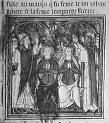
On Sept. 13, 1210 French Crusader John of Brienne (1170-1237) reaches Acre, and on Sept. 14 he marries Marie de Montferrat (1192-1212) (queen of Jerusalem since 1205), and on Oct. 3 is crowned king of Cypress and Jerusalem in Tyre (until 1225).
In June 1212 the Children's Crusade in France (poor people not children?) is preached by big-mouthed boys Stephan (Stephen) of Cloyes (b. 1200) and Nicholas of Cologne (b. 1202); too bad, it fizzles when Stephan's crowd is sold into slavery or returns home after reaching Marseilles, while Nicholas' contingent allegedly reaches as far as Pisa and the Papal States before being turned back; the origin of the legend of the Pied Piper?
In 1212 Queen Mary de Montferrat of Jerusalem (b. 1191) dies of puerperal fever from childbirth, and her hubby John of Brienne becomes regent for their infant daughter Yolande (Isbella) II de Brienne (1212-28).
Medieval soundbyte of the century by Pope Geraldo? In 1213 Pope Innocent III declares that Muhammad has been positively identified as the Antichrist, and that the Second Coming of Christ will happen in 1284 because it is 666 years after the founding of Islam (618).

It finally happens: an army of real turn-the-other-cheekers get more than their cheeks slapped by the Catholic Reality TV Show of the time? On Sept. 12, 1213 after king (since Apr. 25, 1196) Peter II of Aragon (b. 1178) comes to the aid of his brother-in-law Count Raymond VI Count of Toulouse against Simon IV de Montfort, he is unhorsed, shouts "I'm the king", but is killed anyway by enemy troops at the Battle of Muret, after which his 30K-40K Albigenses panic and are defeated by 1.8K Roman Catholic Crusaders, who split their army into three divs. in honor of the Trinity; the Provencal culture in S France is now systematically wrecked along with the Albigensian heresy in a long series of horrors by disgusting Simon IV de Montfort, and many troubadors flee S France to Aragon and Catalonia; Peter II's son James I (the Conqueror) (1208-76) becomes king of Aragon (until July 27, 1276), going on to expand Aragon into Valencia to the S, Languedoc to the N, and the Balearic Islands to the N, plus get hold of the county of Barcelona from Louis IX, establishing naval supremacy in the W Mediterranean, and making Catalan the official state language.
In 1214 after Pope Innocent III, in an effort to reward the Crusaders issues the bull Quia Major, proclaiming the Fifth Crusade and ordering Jews to forgive all interest on loans made to them, Philip II of France balks, ordering Crusaders to settle up with "our men" (hominem nostris); Innocent III utters the soundbyte: "No Christian shall do the Jews any personal injury... or deprive them of their possessions... or extort money from them by threatening to exhume their dead"; Hugh of Lucca is appointed surgeon for Bologna, Italy for 600 Bolognini/year, with his contract requiring him to join the Fifth Crusader army in Egypt, where he discovers that wine cleanses and disinfects wounds, and that pus is unhealthy and not what other doctors call "praiseworthy pus" that cleans toxins from blood.
Start the music, the Catholic Unmagna Charta, or, Oh Hell, you can't stop us now? Perfect opportunity to kick the Eastern Church when it's down? On Nov. 1-30, 1215 the first three Lateran Councils (1123, 1139, 1179) are topped by the Fourth Lateran (12th Ecumenical) (Great) Council, called by Pope Innocent III and attended by two Eastern patriarchs incl. Raoul of Merencourt (-1225), Latin patriarch of Jerusalem (1214-25) (who gives a killer speech on day 1 calling for a new Crusade), new Latin patriarch #2 of Constantinople Gervasius (Gervais) of Heraclea Pontica, plus reps. of many secular princes, 412 bishops, and 800 abbots and priors; it approves 70+ decrees, incl. a condemnation of the Cathari, Waldenses, Albigenses, and other heresies (true Christians?), along with a call to all bishops and princes to be especially vigilant against all heresy (now a combo civil-religious crime), esp. blasphemy of their precious Jesus Christ (the beginning of the horrible Inquisition?), the first confession of faith containing a definition of the new don't-say-cannibal doctrine of Transubstantiation (the turning of the bread and wine of the Lord's Supper into Christ's actual body and blood after a prayer by the priest), a requirement for all church members of the age of discretion to confess their sins to a priest and take Communion at least once a year ("Omnis utriusque sexus") (so they can be checked for heresy?), a decree forbidding priests to take part in ordeals, the command that damned Jews and Muslims in Christian Europe must wear items of clothing distinguishing themselves from saved Christians (color-coding for infidels, usually a 3-in. yellow cloth circle) probably taken from the Muslim World, which did it to Christians and Jews), and are prohibited from holding public office or going out during Holy Week (for their protection, of course), and a decree forbidding new monastic orders (new women have to join the existing ones); the Roman Catholic Church is declared the only true faith, outside which nobody can be saved, although the council recognizes the patriarchs of Constantinople, Alexandria, Antioch, and Jerusalem after the numero uno pope, in that order; Jews are doomed to perpetual servitude for crucifying Jesus; the council bans the teaching of the works of Aristotle except those on logic and ethics; all that remains is to prohibit Bible reading by laymen, which is done in 1229 - it took them over a thousand years to finally make up their minds about all this, and they leave a back door for the Greek Orthodox Church in hopes of reconciling?
On Nov. 30, 1215 (last day) Pope Innocent III issues a Call for the Fifth Crusade at the Fourth Lateran Council, with Egypt as the objective and the date to be 1217; meanwhile he imposes another income tax on his clergy to pay for it, and prohibits trade with the Muslims to ensure a supply of ships; meaning to control it personally this time so it won't end up a bummer like the Fourth Crusade, he orders the Crusaders to meet with him in Brindisi next year, where he plans on offering each of them an indulgence for fighting or even helping with expenses; Frederick II vows to go on Crusade, and abdicate the kingdom of Sicily when he gains full recognition of the German princes, and is crowned as Hohenstaufen German king #6 Frederick II (1194-1250) in Aix-la-Chapelle, and the Hohenstaufen family rules Germany again until 1254. Simon de Monfort sieges Toulouse and Narbonne; Raymond VI retires to England, goes to Rome to plead with Pope Innocent III again, then goes to Aragon after being refused.


On June 11, 1216 Henry I of Flanders, Latin emperor of Constantinople (since 1205) dies in Thessaloniki (poisoned), and is succeeded by his brother-in-law (through his sister Yolande) Peter II of Courtenay (1155-1219), who is consecrated in Rome by Pope Honorius III next Apr. 9, and is captured en route to Constantinople by Theodore Comnenus Ducas of Epirus, dying in prison in 1219; his wife Yolanda of Flanders (Hainaut) (1175-1219) reaches Constantinople and rules as regent (until Aug. 1219), making peace with Theodore I Lascaris of Nicaea, who marries her daughter Marie (Maria) de Courtenay (1204-28). On June 16, 1216 Pope (since 1198) Innocent III (b. 1160) dies without having crowned his former ward Frederick II as HRE, and on July 18 Pope (#176) Honorius III (1150-1227) (yet another Roman) is elected, taking charge of the Crusade; meanwhile Stephen Langton travels to Rome to argue for the Magna Charta.

In 1217 Peter II of Courtenay is captured by Theodore Dukas Angelus, despot of Epirus, and his wife Yolande becomes regent (until 1219), while her daddy John of Brienne (1170-1237) becomes Latin king of Jerusalem (until 1225); meanwhile in the spring after Pope Honorius III bars pesky Frederick II from participating, the Fifth Crusade begins (ends 1221); the Crusaders, led by Leopold VI of Austria and Andrew II of Hungary leave for Acre, where they are joined by John of Brienne, Hugh I of Cyprus, and Prince Bohemund IV of Antioch in an attack against the Ayyubids in Syria; Jerusalem Patriarch Raoul of Merencourt goes along, carrying a relic of the True Cross to pump them up; too bad, a screwup in funding causes a motley crew of cripples, aged, infirm, thieves et al. to join the army and be transported to the Holy Land, where they prove useless (except to prove to Muslims that Christians stink?); too bad, after they reach Jerusalem they find the walls and fortifications torn down and the Muslim defenders gone, and the Euros end up returning home next year; meanwhile, while no field battles are fought, both sides fight battles near their opponent's camps with the object of capturing or destroying their facilities; Andrew II overspends, causing him to sell royal land to oligarchs; the Latin Province of Syria is established, with Franciscian brother Elias as minister; by 1229 the Franciscans have a small house in Jerusalem near the 5th station of the Via Dolorosa.

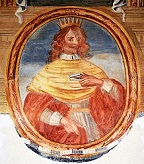
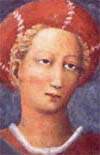
On Jan 10, 1218 king (since Apr. 1, 1205) Hugh (Hugues) I de Lusignan (b. 1194) dies, and his infant son Henry I (the Fat) (le Gros) of Lusignan becomes king of Cyprus, with his mother Alice of Champagne (1193-1246) (eldest daughter of Count Henry II of Champagne and Isabella I of Jerusalem) as regent (until 1223). On June 25 after the defenders of Toulouse construct a trebuchet, and the Crusaders construct a cat (mobile shelter), which is destroyed by the trebuchet, Provencal-killer Simon IV de Montfort (b. 1160) is KIA by a siege engine operated by women, and Raymond VI regains his position as count of Toulouse. In June after Oliver of Cologne arrives with a fresh German army, and Count William I of Holland arrives with a Dutch-Flemish-Frisian army, and they hook up with Leopold VI of Austria and John of Brienne and decide to go straight to the Ayyubid heartland in Damietta, Egypt, allying with Seljuk sultan Keykavus I of Rum in Anatolia to attack the Ayyubids in Syria as a diversion, the Crusaders siege Damietta, and on Aug. 25 take the tower outside the city; Saladin's brother Al-Adil dies (of grief?) upon hearing of the Crusaders' seizure of the chain bridge, and is succeeded by his son Al-Malik al-Kamil (al-Kamal) Muhammad (1180-1238) as sultan of the Ayyubid Dynasty in Egypt and Syria (until 1238); too bad, the siege bogs down and the Crusaders begin dying from disease, causing William I and his army to sail for home. Peter II of Courtenay (b. 1155) dies, and his son Robert I of Courtenay (-1228) becomes Latin emperor of Constantinople (until 1228), with his mother Yolande as regent until next year when he reaches the age of majority, spending his career watching his empire shrink while begging for Western aid.


In Sept. 1219 Italian Roman Catholic preacher St. Francis of Assisi (1181-1226) (founder of the Franciscan Order) visit Egypt and boldly cross the lines in 1219, being taken to the court of Saladin's nephew Al-Malik al-Kamil (1180-1238), announcing his intention of converting him to Christ and making him give up Muhammad by reason (sure, it would be the first time, in which case he's a shoo-in for saint?); he talked religion for a week without getting beheaded (maybe because the sultan had just survived a coup attempt backed by Coptic Christians and didn't want to rile them up), failing to make a dent and coming out of it as the one who was changed, picking up the idea of five daily prayers and bringing it back as the three daily recitations of the Angelus, and going bigtime for the Muslim rosary, albeit Irish Christians began using it around 800 C.E.
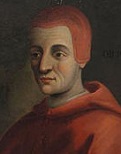

On Mar. 31, 1220 the Muslims attack the Crusader camp in Damietta; on Aug. 29 the Crusaders counterattack the Muslim camp; meanwhile after Pelagius of Albano keeps refusing to let John of Brienne rule Damietta, he gets fed up and returns to Acre, and Pelagius requests Frederick II to come with a fresh army.
In 1220 after accompanying Peter II of Courtenay from Rome as papal legate and being captured with him then released,
In 1220 Cardinal Giovanni Colonna (1170-1245) becomes regent of the Latin Empire of Constantinople (until Mar. 25, 1221).
In 1220 St. Francis hears about the Five Martyrs of Morocco, friars he had sent to convert the Moroccans into giving up devil man Muhammad for god man Christ, who didn't fare so well, ending up tortured and executed, their example launching the career of Portuguese-born St. Anthony of Padua (1195-1231), who became such an exemplary Franciscan preacher that he was canonized in 1232 less than one year after his death, a fast-tracking record that still stands.
By the way, the Fifth Crusade was another bust for the Christians. Obviously, by now the Christian monarchs were de facto pagans again, using Christianity as the opiate of the people while becoming just as mean and vicious in war as the Muslims, but the Christian preachers had the moral high ground with the example of Christ, allowing the West to buy time until Science could take over and become the new religion, developing a moral-legal-social code that didn't require books authored by gods, although they probably didn't know it yet.
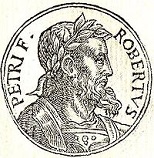
On Mar. 25, 1221 after his older brother Marquis Philip of Namur renounces the succession, Robert of Courtenay (-1228), younger son of Peter II of Courtenay and Yolanda of Flanders becomes Robert I, Latin emperor of Constantinople (until 1228), immediately appealing for help from Pope Honorius III and Philip II of France, who send little aid.
In July 1221 after HRE Frederick II doesn't show up and Jerusalem king (1210-25) John of Brienne (1170-1237) returns to Damietta, the don't-you-just-love-Mondays Crusaders attempt to march on Cairo, but are blocked both ways and trapped by a flood of the Nile River, and after their supplies run out they they are ambushed in a night attack by al-Kamil, causing Pelagius to surrender the army and agree to an 8-year truce in the Treaty of 1221; Damietta in N Egypt is lost to the cross-kissers, and they retreat with their crosses dangling between their legs, ending the Forked Over Fifth Crusade (begun 1217); al-Kamil promises to return the True Cross, which it later turns out he doesn't have; English Magna Charta baron Robert Fitzwalter, who participated in the siege of Damietta returns to England, where he makes up with Henry III.
In 1223 after a dispute of Philip of Ibelin, Alice of Champagne leaves Cyprus while remaining regent for her son Henry I, going on to unsuccessfully claim the kingdom of Jerusalem against the infant Conrad (son of her niece Isabella II of Jerusalem and HRE Frederick II).In 1225 HRE Frederick II marries Yolande, heiress of the Latin kingdom of Jerusalem, then declares himself king of Jerusalem, forcing John of Brienne, who is traveling on the Continent to relinquish the title, while he soon commands papal troops in an attack upon Frederick II's possessions; 8-y.-o. Henry I is hastily crowned king of Cyprus in Nicosia to avert a seizure of power by Frederick II; John of Brienne's daughter Isabella is crowned queen of Tyre.


On Jan. 30, 1226 Pope Honorius III approves the mendicant Carmelite Order (founded in 1224), and induces French king Louis VIII (b. 1187) to crusade against the remaining Albigenses, and he conquers Avignon in Provence, then most of Languedoc, starting the practice of bestowing huge fiefs as appanages on princes of the blood, which later backfires in Burgundy and elsewhere; he then dies on Nov. 8 of dysentery on his return to Paris, and his able, carefully-educated Capetian son Louis IX (the Saint) (1214-70) (canonized in 1297) (the ideal medieval king?) succeeds him as Capetian king #9 (until Aug. 25, 1270), with his mother Blanche of Castile (1188-1252) as regent, going on to continue his daddy's policy of enlarging the French royal domain and getting brownie points with the Church by kicking any remaining Albigensian butt around the Mediterranean, and introducing the title of admiral into France while winning a rep. for justice which makes him the arbiter of Europe, and his reign the golden age of medieval France; in the meantime his devout mouther, er, mother gets the support of the people, officials, and Church to suppress a number of feudal rebellions (1226-31) while he finished growing up, wearing the saint-making itchy-scratchy goat-hair shirt.
In 1226 Duke Conrad of Masovia (Poland) invites the Palestine-based Teutonic Order (Knights) into Poland to help them fight the pagan Prussians; initially claiming to want to stay only a year or two, they instead conquer most of the Baltic coast within the next two cents., blocking Polish access to the sea.
In 1226 Robert of Courteney, Latin emperor of Constantinople is defeated by Theodore of Epirus and John III of Nicea, causing him to promise to marry Eudoxia, daughter of late Nicaean emperor Theodore I Lascaris, but since his sister Marie de Courtenay was his wife, Patriarch Manual Sarantenos prohibits the marriage, causing him to switch to the Lady of Neuville (-1228) (Eudoxia?), pissing-off a Burgundian gentleman, who organizes a conspiracy of knights in Constantinople to attack the house of the new wife and her mother, cutting off their lips and nostrils and throwing them in the sea, causing Robert to flee to Rome t

On Mar. 23, 1228 Pope Gregory IX renews the excommunication of double-shuffling wannabe HRE (since Nov. 22, 1220) Frederick II Hohenstaufen (1194-1250) and proclaims a Crusade against his Sicilian lands, then is publicly insulted by a Ghibelline mob, causing him to pick up his holy robes and flee to Perugia, from where he directs an invasion of Apulia (ends 1229); on June 28 Frederick II finally sails for the Holy Land to lead the lay-royal Sixth (6th) Crusade (ends 1229), assisted by wealthy Richard of Cornwall, 1st Earl of Cornwall (1209-72) and Count Thibaud (Theobald) IV (the Troubadour) (the Posthumous) de Champagne (Navarre) (1201-53), but this only causes the pope to ban him a 2nd time; on July 21 he lands at Limassol, engages in a power play with John of Ibelin, the Old Lord of Beirut, sails for Acre, then goes to Jaffa where he holds truce conferences with Egyptian sultan Malik al-Kamil, nephew of Saladin, exposing his soft stance on Islam, helped by being fluent in Arabic; Stupor Mundi (Wonder of the World) Frederick II speaks six languages fluently, incl. Arabic, making him the first Crusader to speak dangerous Muslim talk, causing rumors that he might be the Antichrist.
In 1228 loser Robert I of Courteney, Latin emperor of Constantinople since 1218 dies, and is succeeded by his 11-y.-o. brother (by Peter I and Yolande) Baldwin II of Courtenay (1217-73), who becomes the last Latin emperor of Constantinople (until 1261); his youth causes antsy Frankish nobles in Constantinople to propose Bulgarian tsar John Asen II (-1241) as emperor to counter the aggression of Theodore Dukas Angelus of Epirus, but the Roman Catholic clergy nix it by 1230; he spends his reign peddling holy relics looted from Big C throughout Europe - the Devil wears Prada?
On Feb. 18, 1229 the Crusaders under cool multilingual brain man HRE Frederick II negotiate the Treaty of Jaffa and Tell Ajul with al-Kamil, Ayyubid sultan of Egypt, ending the Sixth Crusade (begun 1228), agreeing to a commercial convention along with the surrender to the Crusaders of part of the Kingdom of Jerusalem, incl. the complete tour package of Jerusalem, Nazareth, Bethlehem, and Lydda, along with a corridor to the sea for Christian tour groups, and a 10-year truce; since Jerusalem is wallless, neither ruler much cares?; Frederick II promises not to build the walls of Jerusalem; the Temple Mount incl. al-Aqsa Mosque and the Dome of the Rock remain in Muslim hands, along with the Crusader Oultrejordain (Transjordan) castles; the Christians retake Jerusalem until 1239, prohibiting Jews from living there; the Muslim and Christian pops. greet the news with riots, with mobs attacking al-Kamil's camp at Tel al-Ajul and having to be driven away by troops; Sheikh Sibt al-Jauzi speaks before sobbing crowds at the Great Mosque in Damascus, calling al-Kamil a traitor, which he lamely responds to by claiming he only gave up "some churches and ruined houses"; on Mar. 18 after no priest will do it, HRE Frederick II crowns himself king of Jerusalem in the Church of the Holy Sepulchre, along with his infant son Conrad IV (b. 1228), for whom he acts as regent, then tours the Temple Mount, speaking with the attendants in Arabic and beating up a Christian priest who dares to enter al-Aqsa Mosque carrying a Bible, ordering the muezzin to be allowed to issue the daily calls to prayer, pissing-off the Templers, who plot to assassinate him; actually the patriarch of Jerusalem, who opposed Frederick II at every turn to please his boss the pope ordered all clergy locked up so they couldn't help in the ceremony; hobbled by his ban he leaves in June early in the morning while the Templers pelt him with manure and entrails, then seizes Cyprus with his Longobard troops, defeats a papal army in Sicily, and makes peace overtures to try to get the ban lifted; meanwhile the pope and the emperor trade epithets, accusing each other being the Antichrist (and they're both right?); former Latin king of Jerusalem (1210-25) John of Brienne returns to Jerusalem, and is chosen by the Latin barons of Constantinople to become regent of boy emperor Baldwin II of Constantinople, then becomes emperor in 1231 until he comes of age in 1237.
On Apr. 12, 1229 Raymond VII of Toulouse surrenders to 17-y.-o. Louis IX and his regent mother Blanche of Castile, and signs the Treaty of Paris (Meaux), ending the Albigensian Crusade (begun 1209), betrothing his heiress to Louis' brother Alphonse, while Louis IX is betrothed to Margaret of Provence (1221-95), marrying her on May 27, 1234, proceeding to steal Provence from the HRE; Raymond VII cedes over half of his territory to the king, retaining the remainder only during his life and agreeing to dismantle his fortifications in Toulouse et al., causing Occitan political autonomy to be kaput, and Cathars to lose their last political protection, with Raymond required to hunt them down as vassals of the king.
On July 14, 1229 HRE Frederick II defeats imperial bailiffs outside Nicosia and seizes Cyprus from regent John of Ibelin (1179-1236), old Lord of Beirut, who flees with his family to Palestine and sets up shop in Jaffa, vowing to kick Hohenstaufen butt, launching the the War of the Lombards (Imperialists) (Ibelin War) between the reps of HRE Fredrick II, supported by the Knights Hospitaller and Teutonic Knights vs. the native aristocrats led by Ibelins and Montforts, supported by the Knights Templar (ends 1243).
In 1229 Geoffrey I of Villehardouin (b. 1169) dies, and his eldest son Geoffrey II of Villehardouin (1195-1246) becomes Latin prince #3 of Achaea (until May 6, 1246), becoming the most powerful vassal of the Latin Empire of Constantinople, helping the Crusader states in Greece regroup around him, going on to rescue Constantinople 3x and receiving the reward of suzerainty over Euoboea by Emperor Baldwin II, becoming known for his benevolent and just rule, keeping his popularity with the Orthodox Greco-Slavic pop. by restricting the activities of Latin priests, even after the pope excommunicates him, knowing that things are so iffy that he will reinstate him, which he does.
How do you approach the Word of God? You don't? Progresso, what a soup of holy words shouldn't be? In 1229 after the first hand-copied partial translations of the Bible by the pesky Albigensians begin appearing, the (non-ecumenical?) Council of Toulouse forbids lay persons from reading the Bible, to be enforced by the Papal Inquisition, run mainly by the Dominicans (is that a Bible in your pants or are you just happy to see me?); "Search the Scriptures, for in them ye think ye have eternal life, and they are they which testify of me" (John 5:39); "Use of the vernacular [would mean] demolition of a language barrier that safeguarded the clergy's exclusive dominion over religious matters" (Massimo Firpo); meanwhile the U. of Toulouse is founded in Toulouse, France, becoming one of the oldest Euro univs. to survive to modern times; it is later renamed in honor of 1912 Nobel Chem. Prize winner Paul Sabatier (1854-1941).

In Feb. 1230 a flood of the Tiber River causes Rome to invite exiled Pope Gregory IX back; on July 20 the Peace of San Germano is concluded between HRE (since 1212) Frederick II (1194-1250) and the pope, who gets his papal states back, while Freddy II gets unexcommunicated, and they kiss and make up by Sept.; now the pope is free to crack down on those !*?! heretics as the Sixth Crusade fizzles and he needs some more sheep to slaughter ("not only the reductio ad absurdum of crusades, but of papal excommunications" - H.G. Wells). About this time the Crusaders bring leprosy back with them to Europe.
In May 1232 the Battle of Casal Imbert (Az-Zeeb) N of Acre (2nd field battle in the Lombard-Ibelin War) is a V for the Lombards; on June 15 the Battle of Agridi (3rd) is a V for the Ibelins, allowing 15-y.-o. Henry I (the Fat) (le Gros) of Lusignan (1217-53) to assume control of Cyprus (until Jan. 18, 1253).
In 1236 Christian Crusaders invade Jewish settlements in Anjou and Poitou, incl. Bordeaux and Angouleme, and order all Jews to be baptized, trampling 3K who refuse to death under their horses' hooves; Pope Gregory IX condemns the slaughter.
On Mar. 17, 1238 Pope Gregory IX writes the encyclical Considerantes Olim, asking HRE Frederick II for support for a Crusade to bolster the threatened kingdom of Latin Romania.
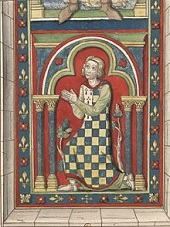
In 1239 at the call of Pope Gregory IX, the Baron's Crusade of 1239 begins (ends 1241), led separately by king (since 1234) Theobald I the Troubadour of Navarre (1201-53) (count of Champagne since 1201) and super-rich earl (since 1225) Richard of Cornwall (1209-72) (2nd son of King John of England), with a side crusade to Constantinople led by Baldwin the Broke of Courtenay (1217-73) (last Latin emperor of Constantinople since 1228), which captures Tzurulum; in Nov. after Duke (1213-21) Peter Mauclerc I of Brittany (1187-1250) leaves on the march from Acre to Ascalon, he and his lt. Raoul de Soissons (1210-70) leave the main force and attack a Muslim cattle drive on the Jordan River en route to Damascus, holing-them up then taking their castle and seizing POWs and booty, pissed-off caravan leader An-Nasir Dawud (1206-61), emir (1229-48) of Kerak attacks Jerusalem, forcing the garrison of the citadel to surrender on Dec. 7, destroying its fortifications, but due to internecine warfare between the Ayyubids withdraws to Kerak in exchange for Crusader help against the Ayyubid sultan of Egypt, allowing the Franks to return and take control of the city incl. the Temple Mount, causing the Christians to hang church bells in Al-Aqsa Mosque and celebrate Mass in the Dome of the Rock, pissing-off the local Muslim pop; meanwhile on Nov. 12 after the main army reaches Jaffa, a group of 400-600 knights breaks ranks and rides off on a night raid, meeting up with an Egyptian army under Rukn al-Din al-Hijawi in Gaza on Nov. 13 and getting soundly defeated before the main force can catch up and turn around to Acre.
In 1240 Richard of Cornwall and Simon de Montfort go on a crusade to Jaffa.
In 1241 Duke Hugh IV of Burgundy and Richard of Cornwall take Ascalon (Ashkelon) and negotiate a peace with Egypt.
In 1243 the Crusaders led by Richard of Cornwall retake Jerusalem for one year.
In July 1244 Jerusalem is surprise-attacked by Persianized Turkish Sunni Muslim Khwarezmian (Khwarazmian) (Khwarismian) mercenaries (freebooters and unemployed soldiers left over from the 1220 Mongol invasion) in the employ of Egyptian pasha Khwarazmi after he discovered the Christians intriguing against him; the garrison flees to the Tower of David and holds out for nearly six weeks, surrendering on Aug. 23, after which they sack the city, decimate the Christian pop., and drive out the Jews; Jerusalem remains under Egyptian control until 1517, and under Muslim control until 1917 when British Gen. Allenby captures it. In 1247 they in turn are driven out by the Ayyubids. In 1250-1517 Jerusalem is ruled by the Egyptian Muslim Mamluks (Mamelukes), Turkish slaves who overthrew their masters. During this period many clashes occurred between the Mamluks on one side and the Crusaders and the Mongols on the other.
On Oct. 17-18, 1244 a major Latin army (allied with local Ayyubid princes) is destroyed by the Egyptians and their allies near Gaza in the Battle of La Forbie; the three Christian military orders have their butts kicked bigtime by the Allah Akbars, and 312 of the 348 Knights Templar are KIA, incl. grandmaster Armand de Perigord (Hermann de Pierre-Grosse) (b. 1178); Louis IX the Saint of France becomes a Knight Templar, gets sick, and swears that if he recovers he will start the Seventh Crusade to stop the Egyptian attacks; he does, so guess what, he does the saintly thing and takes up the Cross; meanwhile the reaction among Christians is to revert to Millennium Fever, taking to the soapbox to whip the masses up to go on YAC (yet another crusade) - maybe Jeezy just doesn't care about the *!?*! place, no matter how much the tourist companies are hurting?
In 1247 the Egyptians under sultan Ayub capture Ascalon and Tiberias from the Knights Hospitaller, leaving Jaffa as the main Crusader base on the coast.
In 1247 Bethlehem Royal Hospital in Bishopsgate outside the wall of London is founded as the priory of the new Order of St. Mary of Bethlem by Goffredo de Prefetti of Italy, bishop-elect of Bethlehem to collect alms for the Crusades; it begins to be called a hospital in 1330, and by 1377 (1403?) after the English govt. secularizes it, it begins admitting the insane; by the 14th cent. it becomes known as Bedlam; in 1547 it is acquired by the City of London, operating until 1948; it is now part of the British NHS Foundation Trust.
In 1248 the Seventh (7th) Crusade (ends 1254) is led by Louis IX of France, with the aim of freeing Palestine via the capture of Egypt; after putting his mother Blanche of Castile back in charge of France as regent (until 1252), he winters in Cyprus to make preparations to invade Egypt.

Walk like an Egyptian, way-oh-way-oh? Early in 1249 William II of Achaea captures the fortress of Monemvasia (Malvasia) in the Peloponnesus with the help of his Euboean vassals, then hooks up his 400 knights and 28 ships with Louis IX of France and his poorly organized Seventh Crusaders in Cyprus; in early June they land in Egypt, capture Damietta on June 4-6 (without a blow?), then wait for the Nile to subside before heading for Cairo; on Nov. 23 Sultan (since 1240) As-Salih Ayub (Al-Malik as-Salih Najm al-Din Ayyub) (1205-49), last Ayyubid ruler of Egypt dies in battle in Mansourah fighting the Crusaders, and his widow (a former Turkish Mamluk slave) Shajar (Shagrat) al-Durr (-1257) ("Tree of Pearls") conceals his death to rule in his name, becoming the first female ruler of Egypt since Cleopatra next May 2 (until Apr. 28, 1257); to save face, the Muslim leaders of Cairo make her marry former slave Aybak (-1257) and pretend that he's the ruler; the Kipchak Turkic Mamluks (Mamelukes) (Arab. "possessed", "owned") (white slave Turks and Mongols who earned the right to own weapons and are used as guards by the kaput Ayyubid sultans) go on to rule Egypt until 1517.
Video killed the radio star? In 1250 Millennium Fever is raging in the Franciscan Order among the followers of super-popular Joachim of Fiore (Joachim of Flora) (Gioacchino da Fiore) (1135-1202), who predicted this year to be the dawn of the Age of the Holy Spirit; when it doesn't happen, they reset it to the year 1260 and keep asking for donations?
About 1250 the Medieval Climate Optimum (begun 950) along with the optimal climate conditions in Europe since 1000 end, and the Little Ice Age (ends 1850) begins as Atlantic ice pack begins growing, bringing poor harvests, famine, and disease, and changing the sociopolitical landscape with a pop. reduction, uprooted vagabond farmers, and a blind rage against the rich and Jews; Europe begins to be rapidly deforested, leading to a shortage of wood for heating and cooking by 1500, along with a decline of wild game and a food shortage; luckily, in the 16th cent. potatoes and corn (maize) are brought in from the New World, and soft coal begins to be used as fuel.
Black Egyptian Muslims kick white Christian butt in the days of hand-to-hand? In Feb. 1250 a Coptic Christian helps the Seventh Crusaders led by French king (1226-70) Louis IX find a ford across the Nile River, and on Feb. 8-11 they defeat the Egyptians under Al-Zahir al-Malik Baybars (Baibars) (Arab. "panther") (1223-77) at the Battle of Al Mansura (Mansurah) on the Nile River (30 mi. SW of Damietta) (founded about 1200), but on Apr. 6 they are totally defeated by Egyptian forces under new caliph (since Nov. 22, 1249) Al-Muazzam Turanshah (-1250) (older brother of Saladin) at the Battle of Fariskur; the Crusaders are routed, most of their 15K-man army is KIA, and Louis IX is captured and held for ransom (until 1252).
In 1251 thousands of shepherds (pastoreaux) lead the popular Pastoureaux (Shepherds) Insurrection (Crusade) in N France allegedly to rescue Louis IX, intending to usher in the Parousia by slaughtering "heretics", i.e., Jews, Muslims, intellectuals, and the rich.
In Oct. 1253 Pope Innocent IV returns to Rome; Russian prince Daniel of Galicia (Volynia_ (1201-64) sells out the Russian Church to him to secure aid for a crusade against the Tartars, but it fizzles. The Mamluks and the Ayyubids sign an agreement granting the Mamluks sovereignty over the kingships W of the Jordan River, and the Ayyubids those E of the Jordan River.
In 1254 King Louis IX returns to France from the Holy Land, ending the Seventh Crusade (begun 1248), and expels the Jews from France, ending the Tosaphists Period; most go E to Germany or farther; Louis IX founds the Order of the Ship and the Double Crescent for nobles who accompanied him on his ill-fated Seventh Crusade.
In 1256 pissed-off at losing Ascalon, the Mamluks siege Jaffa, but John of Ibelin returns from Ascalon and defeats them, giving up control of Jerusalem to his cousin John of Arsuf (Ibelin) (1211-58). In 1256 the Venetian-Genoese (Hundred Years) War between the maritime repubs. of Venice and Genoa begins when the Venetians are evicted from Tyre, and try to move into Acre onto land owned by the Monastery of St. Sabas, which Genoa claims, starting the War of St. Sabas (Saba) (ends 1270) in Acre, with John of Ibelin, count of Jaffa, and the Knights Templar supporting the Venetians, and Philip of Monfort, John of Arsuf, and the Knights Hospitaler supporting the Genoese, who win early Vs until the repub. of Pisa signs a 10-year military alliance with Venice.
In 1257 after he tries to take over, Mamluk ruler Shagarat ad-Durr has her hubby Aybak murdered in his bath, and next year former Turkish slave Al-Malik Baibars(-1223-77) becomes Mamluk ruler #2 (until 1177), going on to murder Sultan Qutuz in 1260 and become the first Mamluk sultan, kicking Crusader butt, building up the military, and organizing the govt. to prevent incompetence, which holds until 1517.
In 1258 the Venetians under adm. Lorenzo Tiepolo break through the harbor chain in Acre and defeat the Genoese navy, capturing the disputed St. Saba monastery, then after the 800 Genoese soldiers and crossbowmen hold their quarter of the town, Tiepolo begins a blockade, after which in Aug. John of Arsuf, hoping to aid Genoa signs a treaty with the city of Ancona granting commercial rights in Acre, but it backfires when John of Ibelin and John II of Beirut turn them to Venice's side, leaving only Philip of Monfort on the Genoese side, but after his 380 men are defeated, on Oct. 16 a peace treaty is signed by the Templars, Hospitallers, and Teutonic Knights, and the tired Genoese leave their acre in Acre for Tyre, continuing the fight.

Speaking of parts west? On Mar. 1, 1260 after the Mongol forces of Hulagu Khan combine with the Franks under Bohemond VI of Antioch and the Cilician Armenians under Hetoum I and capture Aleppo, they hook up with Hulagu's Christian Turkish gen. Kitbuqa (-1260) and capture Damascus, celebrating Xmas Mass in the Grand Mosque of the Umayyads (formerly the Cathedral of St. John the Baptist), profaning numerous mosques and sacking Jerusalem; An-Nasir Yusuf is KIA by Hulagu, and the Ayyubid Dynasty (founded 1171) becomes kaput, continuing in name only, with the Muslim power center in Cairo not Baghdad or Damascus; meanwhile the death of Great Khan Mongke causes Hulagu to leave for Karakorum to help decide who will succeed him, and he leaves only 10K horsemen in Syria under Kitbuqa to occupy it, who raids as far S as Ascalon and Jerusalem, and stations a garrison of 1K in Gaza and another in Naplouse. On Sept. 3, 1260 after the Mamluks take advantage of the absence of Hulagu to move on them, the Mongols offer an alliance with the Franks, but Pope Alexander IV forbids it, and Count Julian Grenier of Sidon (-1275) (son of Balian I and Margaret of Brienne) causes the death of a grandson of Kitbuqa, causing him to sack Sidon, pissing-off the Christians so bad tht they allow them to pass through Crusader territory, 10K-20K Egyptian Mamluks defeat and wipe out 10K Mongols in the Battle of Ain (Ayn) Jalut (Arab. "Spring of Goliath") (Heb. "Spring of Herod) in the Palestinian desert in the Jezreel Valley near Ein Harod (near Nazareth), becoming the first Mongol D that isn't avenged, forever defining the SW limit of Mongol expansion as the Tigris River; Kitbuqa is executed; Syria suffers severely from the Mongol invasion, worsened by subsequent invasions in 1281 and 1299; the Egyptians use portable hand cannon (midfa) using gunpowder cartridges charged with 2-3-15 (sulfur-carbon-saltpeter) gunpowder; on the way back to Cairo Al-Zahir al-Malik Baybars (Baibars) (Arab. "panther") (1223-77) AKA Abu al-Futuh (Abu l-Futuhat) (Arab. "father of conquest") murders Sultan Qutuz, and becomes Bahriyya sultan #1 of the Mamluk Empire (until July 1, 1277); the Kipchak Turkish Mamluks (Mamelukes) (Arab. "possessed", "owned") seize control of the Egyptian sultanate, ruling Egypt until 1517, and continuing as vassals of the Ottoman Empire until 1811, becoming known for kicking the Franks out of Palestine, and kicking the last Crusader's butt out of Asia; the Bahriyya (Bahri) Sultanate of the Mamluk Empire (ends 1382) is founded, becoming the leading Muslim state, integrating and ruling the Syrian provinces in 1271-1516 while recruiting Mamluk soldier-slaves from the Caucasus, which causes ethnic tensions between Turks and Circassians (known for their beautiful babes); Cairo becomes the richest city W of the Indus River until 1300, with public works erected by exploited peasants; the usual form of succession is assassination; Christian participation in the 1258 Mongol invasion of Baghdad et al. cause the Muslims to begin a persecution, ushering in a "devastating reversal of Christian hopes... [and] the... decisive collapse of Christianity in the Middle East and much of Africa" (Colin Chapman); by the middle of this decade Western Christians wake up and begin accepting Mongol feelers about a Franco-Mongol Alliance against the greater threat of the Muslims, the Mongols promising them Jerusalem in return for cooperation; too bad, despite several pro-Christian Buddhist Mongol khans sending embassies, it never happens, perhaps because the Christians demand their conversion first, giving Islam time to slam-dunk and convert them.
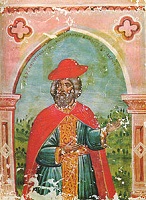
Build muscle, slim fat, lose weight? On July 25, 1261 after making an alliance with the Bulgarians and concluding the 1261 Treaty of Nymphaeum (Nymphaion) with Genoa on Mar. 13, promising them the privileges enjoyed by the Venetians, and catching the Venetian fleet away and crossing the Bosphorus Strait with a Greek army under Gen. Alexius Comnenus Strategopoulos, Nicaean emperor (since 1259) Michael VIII Palaeologus (Palaiologos) (1223-82) surprise-attacks Constantinople, entering the city through a secret passage and recapturing it without much difficulty from the hated Latins, ending the Latin Empire (founded 1204), and restoring the Byzantine Empire in a downsized version under Nicaean leadership after its 57-year exile; Baldwin II wakes up, flees after forgetting to take his scepter and crown with him, and boards a Venetian galley, which heads to Negropont, Athens, Apulia, and France, retaining his title of Latin emperor of Constantinople while sponging off Charles of Anjou, who takes over Sicily in 1267, diverting him from recapturing Big C; the Palaeologan (Palaiologos) Dynasty, the last Byzantine dynasty is founded (ends 1453), finally officially adopting the old Roman double-headed eagle as the official armorial (ending up turning the Byzantine Empire into a subject for paleographists and paleontologists?); after being left behind in Nicaea and blinded on Dec. 25 (his 11th birthday) to make him ineligible for the throne, John IV Ducas Lascaris (b. 1250) is exiled and imprisoned in a fortress in Bithynia, after which Michael VIII marries off his sisters to two Italians and a Bulgarian noble so their descendants can't threaten the imperial succession; despite an attempt to keep the blinding secret, the news comes out, causing Patriarch Arsenios to excommunicate him until the appointment of Patriarch Joseph I in 1268; former emperor Baldwin II escapes to Italy and transfers his claims on the throne of the Latin Empire of Romania (East) (Constantinople) to Charles I of Naples and Sicily or the Two Sicilies (Charles of Anjou and Provence) (1226-85) (youngest son of French king Louis VIII); the duchy of Athens continues for the next two cents., controlled in turn by French, Spanish, and Italian rulers, becoming one of the most brilliant feudal courts of Europe in the 14th cent. Henry III persuades Pope Urban IV to release him from his promise to support the Provisions of Oxford, and to declare the enactments of the barons since 1258 null and void; the English govt. is split into two camps, and civil war brews.
In 1263 Guy I dies, and his Greek-speaking Herodotus-quoting son John I de la Roche (d. 1280) becomes the last Latin lord of Athens (until 1280).
On May 24-27, 1267 William II of Villehardouin, prince of Achaea and his former Latin lord Baldwin II of Constantinople acknowledge Charles I of Naples (Sicily) (Anjou) as lord of Achaea in the Treaty (Treaties) of Viterbo, transferring most of the rights of the defunct Latin Empire of Constantinople to him.
In 1267 after making an alliance with Baybars last year, who reneges on a promise of some troops, the Genoese attack Acre, capture the Tower of Flies and blockade the harbor for 12 days before being kicked out by the Venetians.
In 1268 with pesky John of Ibelin (d. 1266) out of the way, Sultan Baybars of Egypt captures and destroys the ancient city of Jaffa, then in May conquers Lesser Armenian-held Antioch and compels the pop. to embrace Islam, causing the Patriarchs of Antioch to permanently leave the city and take up residence eventually (1366) in Damascus; after learning that Count Bohemond VI left Antioch before he arrived, Baybars writes a letter to him, with the>soundbyte: "You would have seen your knights prostrate beneath the horses' hooves, your houses stormed by pillagers and ransacked by looters, your wealth weighed by the quintal, your women sold four at a time and bought for a dinar of your own money! You would have seen the crosses in your churches smashed, the pages of the false Testaments scattered, the Patriarchs' tombs overturned. You would have seen your Muslim enemy trampling on the place where you celebrate the Mass, cutting the throats of monks, priests and deacons upon the altars, bringing sudden death to the Patriarchs and slavery to the royal princes. You would have seen fire running through your palaces, your dead burned in this world before going down to the fires of the next, your palace lying unrecognizable, the Church of St. Paul and that of the Cathedral of St. Peter pulled down and destroyed; then you would have said, 'Would that I were dust, and that no letter had ever brought me such tidings!'"


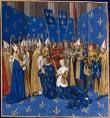
In 1270 Mamluk Sultan Baybars destroys the ancient city of Ashkelon (Ascalon) on the Mediterranean coast of Palestine; in the 16th cent. the Ottomans establish the Arab village of aj-Majdal a few km. inland. In 1270 after Albertus Magnus successfully preaches a crusade in Austria, and at the insistence of Charles of Anjou, whom he made king of Sicily in 1265 and who has big Mediterranean ambitions, French king (since 1226) (St.) Louis IX (b. 1214) leads the Eighth Crusade (his 2nd), makes an ill-advised expedition to Tunis, and dies on Aug. 25 in Damietta of dysentery along with his son John Tristan; his army returns to France with his body, which is buried in Saint-Denis; he is succeeded by his pious but uneducated and bold (rash in judgment) son Philip III (the Bold) (the Strong) (1245-85) as Capetian king #10 (until 1285); Charles of Anjou takes over the Crusade, which fizzles; being uneducated but pious, Philip III ends up being dominated at various times by his mother Margaret of Provence (1221-95), his favorite valet Pierre de la Broce (Brosse) (-1278), his wife Mary of Brabant (1250-1321), and his uncle Charles I of Naples.
In 1270 the War of St. Sabas (begun 1256) finally ends after 20K are killed on both sides, fatally weakening the Crusader states; even then, the Venetians don't give the Genoese their quarter of Acre back until 1288.


I'm just the muscle you muscleheads need? On Apr. 8, 1271 the impregnable Crusader stronghold Krak des Chevaliers (Crag of the Knights) in the Syrian desert 25 mi. W of Homs, guarding the road from Damascus to Tripoli and Jerusalem, "the most wholly admirable castle in the world" (Lawrence of Arabia), which had withstood 12 Saracen attempts finally falls after Mamluk Sultan Al-Zahir Baybars, leading an Egyptian army tricks the skeleton crew of monkish defenders by sending a carrier pigeon with a forged letter purportedly from the Grandmaster of the Hospitalers in Tripoli ordering them to surrender; Baybars gives the garrison free conduct to Tripoli amid his loud laughs; after hearing of this, Prince Edward I Longshanks (1239-1307) leads the (last) Ninth Crusade (ends 1272), taking his wife Eleanor of Castile along and winning Vs at Acre and Haifa, then trying to figure out how to take back their impregnable fortress without the carrier pigeon trick - the idea of a security backdoor is born too late?

1272 In June sultan (since Oct. 24, 1260) Baibars of the Bahri Dynasty is so worried by the arrival of Edward I Longshanks at Acre that he makes an assassination attempt on him, getting him wounded in the arm with a poisoned dagger, which becomes so inflamed that his surgeon has to cut away the diseased flesh, causing his babe Queen Eleanor to be led from his bed "weeping and wailing; after concluding a 10-year truce with the Muslims, they leave Palestine in Sept., and reach Sicily in Dec., learning of Henry III's death. Time won't let me wait that long? On Nov. 16 king (since Oct. 19, 1216) Henry III (b. 1207) dies after a 56-year reign, and his tall (6'7"), handsome (with a drooping left eyelid like his daddy), quick-tempered 33-y.-o. son (makes a dashing figure on his horse?) Edward I (Longshanks) (1239-1307) becomes king of England (the 29th English monarch) (everybody called him Longshanks, but never to his face?), the English Justinian, the first truly English king, an able ruler and great legislator surrounded by able ministers and lawyers and frequently consulting the knights and townsmen; his motto is "pactum serva" (keep troth); returning from the Crusades, he spends a year in Gascony (Basque-ony, old land of the car-door-ear Basques in SW France on the Bay of Biscay), and is not crowned until 1274; the permanent loss of Jerusalem ends the fantasy of it being the capital of Christendom, further solidifying European unity that was helped in 1453 by the loss of Constantinople.
In May 1274 after Byzantine emperor Michael VIII Palaeologus allies with the papacy against Charles I of Naples and Sicily, the Second Ecumenical Council of Lyons (first 1245) convenes, and the Greek Byzantines recognize the authority of the Roman Catholic pope in return for the council authorizing funds for another Crusade, which is never carried out, causing Michael VIII to be villified after his death, and the attempted reunion of the Roman and Greek churches to fall flat; on July 4 an embassy led by Mongol clerk-translator Rychaldus (Richardus) arrives to deliver a report on behalf of Mongol Christian gen. Abaqa seeking an alliance to drive the Mamluks out of Syria; meanwhile to quiet Byzantine critics and prevent another conclave of Viterbo, Pope Malcolm, er, Gregory X decrees that the cardinals have to be locked up until they elect a pope, founding the Papal Conclave (Lat. "with key").

In Jan. 1278 after purchasing it, Sicilian king (1266-85) Charles I of Naples (Anjou) (1227-85) is crowned king of Jerusalem, and acknowledged by the barons in Acre.
On Apr. 4-May 18, 1291 the last Crusader (Frankish) state of Acre (Saint-Jean d'Acre) (Akka) in Syria is sieged and captured by the Mamluks, followed in May by Tyre; the Christian Crusades (begun 1095) end miserably with the expulsion of the Crusaders from the Middle East (Palestine), and the Mamluks in control of all of Egypt and Syria; Pope Nicholas IV calls upon all Christian princes to pray for all the needless deaths, er, take up arms against the Muslims one more time, and for synods to discuss the advisability of uniting the Knights Templar and the Knights of St. John, whose catfights he partly blames for the loss of the Ptolemais; in Aug. he sends a letter to Persian Mongol khan Arghun informing him of plans of Edward I of England to lead another Crusade to recapture the Holy Land, stating that it could only be successful with the help of the "powerful arm" of the Mongols, and asking Arghun to receive Christian baptism and march against the Mamluks; after Arghun dies in Mar. 1291, followed by Nicholas IV in Mar. 1292, Edward I sends Geoffrey de Langley to Persian Mongol khan Gaikhatu, leaving from Genoa and arriving in Tabriz, then returning to Genoa; "Had the Mongol alliance been achieved and honestly implemented by the West, the existence of Outremer would almost certainly have been prolonged; the Mameluks would have been crippled if not destroyed; and the Ilkhanate of Persia would have survived as a power friendly to the Christians and the West" (Sir Steven Runciman, A History of the Crusades, p. 402); meanwhile the Knights of St. John are transferred to conveniently-located Cyprus; too bad, the Templars end up back in Europe with no coverstory and too much land and wealth, causing a ton of pissed-off royals who owe them money to get ideas? - they got sixteen years left?
On Dec. 22-23, 1299 after the Mongols invade Syria again (last time 1281) with an army of 10K Mongols and 10K Georgians and Armenians, and cross the Euphrates River and seize Aleppo, they win the Third Battle of Homs (Wadi al-Khaznadar) against 60K-90K Mamluks from Damascus, whose banner features a Star and Crescent Moon, which is later erroneously claimed to be adopted by Muslims after taking Constantinople in 1453; the Mongols lose 5K-14K KIA, vs. 40K-50K Mamluks KIA, after which the Mamluks flee S towards Damascus while being harassed by 12K Marionite and Druz bowmen seeking independence, leaving after which the Mongols sack Damascus and seige the citadel until 1300, when they have to retreat across the Euphrates River to stop an invasion by the Chagatais, leaving the Christians briefly in control of Syria and Palestine until the Mamluks return - Merry Christmas?

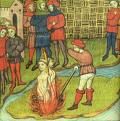
On July 24, 1307 the Knights Templar hold a gen. chapter meeting in Paris; pocket pope Clement V writes to his boss Philip IV on Aug. 24 with a sealed mandate, not to be opened until dawn on Oct. 13 (Fri.), telling of his vision that the Knights Templar are heretics and blasphemers, devil worshipers, homosexuals, sodomites, defilers of Christ and other blimey, and that God had told him to cleanse the Earth by rounding them all up and torturing them until they confess (roasting of the feet is particularly favored?); too bad, at midnight just before the big day dawns, Templar ships under the Admiral of the Fleet leave from La Rochelle, carrying all their big secret documents, portable treasures, and other neat stuff; on Oct. 13 (Fri.) (Oct. 21 Gregorian), AKA Black Friday the 13th, Templar grandmaster (since 1297) Jacques de Molay (1244-1314) is arrested in the Paris Temple by dozens of seneschals, accompanied by Philip IV, who gets pissed-off at not finding their treasure or documents; meanwhile the whole Templar Order throughout France is arrested (15K men), and its assets seized by the crown; the Order is charged with 127 blasphemous crimes; some Templars escape to Argyll, Scotland, where the war with England causes the papal bulls dissolving the order to never be proclaimed, and their allies the Freemasons protect them, admitting them into their lodges under the Accepted Rites of Freemasonry; others flee to Jewish-friendly Spain, Portugal, and Poland; de Molay's deputy Geoffroy de Charnay (1251-1314), and a few others barely survive under cruel chief torturer Gaspard Chaix, only to be burned on Mar. 18, 1314 after they refuse to give up the big secrets of where the loot is?; tortures incl. having heavy weights attached to their testicles, being jerked over heavy beams, held in dungeons for months, feet-roasting et al. - you can't take the Fifth with Clement the Fifth? On Aug. 8, 1308 Pope Clement V summons witnesses for the Templar Trials in Poitiers, bringing 72 Templars to testify about worshiping Head 58 AKA Baphomet (Muhammad?) (Sofia after applying the Atbash Cypher?) (the Shroud of Turin or Mandylion?); on Aug. 17 senior officers of the Templars are interviewed by three cardinals in Chinon; on Sept. 13 English common law stops a pair of French inquisitors arriving in England from prosecuting the Templars, causing Pope Clement V to write to Edward II: "We hear that you forbid torture as contrary to the laws of your land. But no state law can override canon law, our law. Therefore I command you at once to submit those men to torture", causing Edward II to flop, holding the first English tribunal of the Inquisition, and becoming the last use of torture in England until Queen Bloody Mary in 1553-8; the tribunal suppresses the Templar Order and seizes its assets for Edward II, making him and Philip IV the two kings who make out the best?; in Oct. 2007 the Vatican announces the release of the trial documents, showing that they were absolved of heresy charges but burned anyway - and all those Vatican bureaucrats kept their silence all that time?
On May 12, 1310 54 Knights Templar are burned in France as the Order of Knights Templar is ruthlessly extinguished by Philip IV of France allied with the Church; 115 are eventually burned after their feet are roasted over a fire to make them confess; those lucky enough to survive end up as street beggars wearing their charred feet around their necks.
In 1310 the Knights of St. John (Hospitalers) finish conquering Rhodes, becoming the Knights of Rhodes, valiantly resisting expulsion until 1522 while engaging in a naval crusade, which the Ottomans and Venetians regard as pure high-seas piracy run by pirates bearing crosses.
On Mar. 15, 1311 after hiring them and refusing to pay them, the Frankish Duchy of Athens under Duke Walter V of Brienne (b. 1278) is defeated by the Co. of Catalan at the Battle of Cephissus (Orchomenus) (Halmyros) in Boetia, and Walter V is KIA; they divide the wives of the Frenchmen between them and settle down as the new Aragonese Duchy of Athens (1311-88).


On Mar. 18, 1314 after years of fruitless attempts to torture out the whereabouts of their treasure, 39 more Knights Templar are burned in Paris, incl. grandmaster #23 (last) Jacques de Molay (Molai) (b. 1244) and his deputy Geoffroi de Charnay (Charney) (Charny) (b. 1251), preceptor of Normandy; they are slow-roasted over smokeless charcoal, taking hours to die?; in the flames de Molay (who had been tortured into a confession of heresy and given life in priz earlier that day, only to immediately retract it and ordered burned) protests the innocence of the Templar Order, and calls down Philip IV and Pope Clement V for their injustices, launching the Templar Curse, and sure enough they both croak later this year, popey going first in only 33 days?
In Feb. 1312 Philip IV appears before the Council of Vienne and vehemently demands the suppression of the Knights Templar; on Mar. 22 Pope Clement's bull Vox Clamantis dissolves them, and transfers their property to the Hospitalers, except in Spain and France, where the crown keeps it; Philip makes the Templar treasury a section of his royal finance admin.; excommunicated Robert I the Bruce welcomes the Templars to Scotland; Dinis I of Portugal protects the Templars in his territory, and absorbs their holdings into his new Order of Christ; on Apr. 4 the Council of Vienne proclaims a new Crusade.
On Mar. 18, 1314 after years of fruitless attempts to torture out the whereabouts of their treasure, 39 more Knights Templar are burned in Paris, incl. grandmaster #23 (last) Jacques de Molay (Molai) (b. 1244) and his deputy Geoffroi de Charnay (Charney) (Charny) (b. 1251), preceptor of Normandy; they are slow-roasted over smokeless charcoal, taking hours to die?; in the flames de Molay (who had been tortured into a confession of heresy and given life in priz earlier that day, only to immediately retract it and ordered burned) protests the innocence of the Templar Order, and calls down Philip IV and Pope Clement V for their injustices, launching the Templar (De Molay) Curse, and sure enough they both croak later this year, popey going first in only 33 days?
In May 1320 a French shepherd boy in Normandy has a revelation or vision, beginning the Shepherds' Crusade; 30K Christian shepherds set out to attack the Muslim Moors in Spain, change their minds when they see they can fight back, do what comes natural, and begin ravaging defenseless Jewish communities in S France and N Spain incl. Saintes, Verdun-sur-Garonne, Cahors, Albi, Toulouse, and Montclus before they are finally dissolved?
In 1332 the Black Death (Bubonic Plague), caused by Yersinia pestis starts in India. On July 23, 1332 eager for a new Crusade, Pope John XII writes to Venetian Doge Francesco Dandolo, telling him that the injustices they had suffered at the hands of the Turks could be a visitation of divine justice for allowing them too much freedom in their overseas possessions, causing them to agree to assemble a fleet of 20 galleys in Negroponte harbor next Apr. 15 to take them on; meanwhile in Aug. Umur Pasha (the Lion) of Aydin (1309-48), son of emir Mehmed of Lydia (Aydin) attacks Byzantine-held Gallipoli, followed by the N coast of Negroponte and the E shores of the Peloponnesus (Morea), followed by Salamis.
In Aug. 1333 after the promised Crusader fleet at Negroponte fails to materialize, King Robert of Naples writes Pope John XXII, telling him he should earmark all the tithes from Italy for the Crusade, causing the pope to reply on Nov. 19 that he needs French king Philip VI's consent, putting a damper on it.

In 1334 the Black Death strikes in China's NE Hopei Province, then sweeps along the trade routes to Europe by 1347; "Constantinople, summer of 1334. It marched through the streets, the sewers. It left the city by oxcart, by sea to kill half of Europe. The rats, rustling and squealing in the night as they too died... the rats!" - Eyewitness Flint in 1969 Star Trek episode Requiem for Methuselah - could it be a Templar plot to get even? On Sept. 14, 1334 (Wed.) the naval Battle of Adramyttium (Edremit) sees the 20 Venetian galleys under Pietro Zeno (-1345) defeat emir Yakhshi of Karasi, reducing Turkish raids in the Aegean Sea, setting things up for the promised new Crusade; too bad, on Dec. 4 Pope (since 1316) John XXII (b. 1249) dies, and on Dec. 20 former Cathar-broiling inquisitor (Cistercian monk and bishop of Pamiers) Jacques Fournier is egg-lected Pope (#196) Benedict XII (-1342), becoming Avignon pope #4, dropping plans for the Crusade, allowing Umur Pasha to resume his attacks next year, starting with Morea, and the Turkish menace on the E Mediterranean blossoms until new pope Clement VI is elected in 1342, with plundering of the Aegean islands and Greek mainland, incl. Crete.

On Apr. 25, 1342 Pope (since Dec. 30, 1334) Benedict XII dies in Avignon, leaving 1,117,000 florins for a new Crusade, and on May 7 rich man's son Pierre Roger de Rosiers-d'Egletons (in Correze, Limousin) is elected Pope (#197) (the Black Death Pope) Clement VI (1291-1352) in Avignon (4th Avignon pope), making an avg. income of 118,500 florins a year, soon issuing a bull confirming how-much-this-time Giovanni Visconti as archbishop of Milan, who makes it a 2-for-1 and buys the title of ruler of Milan for 500K florins, sharing it with brother Luchino Visconti (1287-1349); too bad, the new pope squanders his dough on the papal palace in Avignon, the purchase of Avignon from Joanna I of Naples, loans and gifts to the French crown, and luxurious living, with the soundbyte "My predecessors did not know how to be pope", and "I have lived as a sinner among sinners", but that doesn't stop him from sending a circular letter next Aug. 8 calling for a Crusade, as long as others pay for it, chiding the Hospitalers f or their conspicuous luxury, and not too subtly reminding them of the fate of the Templars, and telling everybody to assemble their fleets at Negroponte next Nov. 1 (All Saints Day); another male slut, Plutarch calls Clement VI "an ecclesiastical Dionysius with his obscene and infamous artifices"; after his confessor warns him to give up his dozens of mistresses, Bentadick, er, Clement VI replies that he has been sleeping with whores since his youth and continues on the advice of his physicians? - I reproduce like mice?
On Nov. 1, 1343 the Crusader fleet run by the Knights of St. John assembles in Negroponte as Pope Clement VI had requested, and he manages to scrounge up funds to back them despite the bank collapse; too bad, in Nov. a tsunami cashiers the quays of the once major maritime city of Amalfi on the Gulf of Salerno 20 mi. SE of Naples, whose maritime laws once prevailed throughout Italy, and it goes kaput commercially, not to mention what the plague does to it.
On May 13, 1344 (Ascension Day) the 24-galley Latin Crusader fleet sinks 52 Turkish ships and burns 60 more, which the Turks abandon at Longus on Pallene in the Chalcidic Peninsula, causing Pope Clement VI to write a letter on Aug. 12 thanking Venetian Doge Andrea Dandolo; meanwhile on Oct. 28 (Feast of St. Jude and St. Simon) the Crusaders surprise-attack and capture the port of Smyrna (Izmir) (until 1402), and drive out pesky Umur Ghazi (the Lion) (Pasha) (1309-48), although they only capture the harbor and waterfront fortress, leaving the Muslims entrenched in hilltop fortifications, with a ghost town in between, beginning the Smyrniote Crusade (ends 1351), led by Roman Catholic patriarch of Constantinople (1339-45) Henry of Asti (-1345).
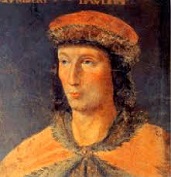
On Jan. 17, 1345 (St. Anthony's Day) Umur Pasha's men sneak down and massacre Crusaders holding Mass in an abandoned Christian church in Smyrna, which the Muslims had converted to a stable, killing Venetian cmdr. Pietro Zeno, Henry of Asti and the other leaders; the news pisses-off Pope Clement VI, who uses it to drum up more money and men to send to their aid, while trying to keep France and England from messing it up with their war; he recruits Humbert II of Viennois (de la Tour-du-Pin) (1312-55) to be the new leader, with new aid from Venice, and he leaves Mariseille in May and arrives in Negroponte around Christmas.
In 1345 the Muslims destroy Jaffa to prevent its possible capture and use by Crusaders, and it takes until the early 18th cent. to be used as a seaport again.
On June 8, 1346 the 26-galley papal fleet of Humbert II of Viennois is attacked by the 29-galley fleet of Genoese adm. Simone Vignosso near Rhodes to prevent them from capturing Chios, which they want for themselves, and which they take after a 3-mo. siege on Sept. 12, after which they occupy Old and New Phocaea on the coast of Anatolia by Sept. 20, restoring Genoese commerce in the Levant; meanwhile Humber's fleet proceeds to Smyrna, arriving in late June; too bad, despite as many as 15K Crusaders massing there, the heat causes them to become ill and die like cattle, and famine sets in, so he ends up leaving and wintering at Rhodes, writing the pope that they should seek a truce, which he agrees to, although Humbert ends up returning home instead when he receives news of his wife's death in 1347; too bad, the Venetians at Smyrna are not ready to give up.
On Feb. 3, 1347 Hesychast book lover and able gen. John VI Cantacuzene reenters Constantinople as emperor, appointing anti-Hesychast scholar Demetrius Cydones (Cydonius) (Demetrios Kydones) (1324-98) as his chancellor, and deciding to try to reconcile the Greek and Latin churches, preparing a golden bull signed in cinnabar ink "giving our lord the pope his proper title and recognizing the primacy and universality of the Roman Church", and requesting a joint synod in Constantinople, Negroponte, or Rhodes to discuss union, also promising to personally lead a rescue army to Smyrna; John VI Cantacuzene is accepted by John V Palaeologus as senior co-emperor (until 1355); too bad, to win he allies himself with the Ottoman Turks, becoming the dork who is responsible for giving them a foothold in Europe, making an Ottoman V over Constantinople unstoppable even if they could have obtained Western military aid. In the spring the Latin Crusaders finally score a V and capture 118 Turkish ships at Imbros (Imroz) Island (modern-day Gokceada).
The Black Death (the original Darth Vader) rockets through Europe's Internet with breathtaking speed? In Oct. 1347 a Genoese trading fleet arrives in Messina, Sicily carrying the Black Death (Bubonic Plague), caused by Yersinia pestis bacteria carried by fleas from rats; not rats but gerbils?; it also arrives in Egypt, Syria, and Cyprus; by 1351 it kills 20M-30M in Europe (a third of Europe's pop., and up to 60% in some areas), and 75M worldwide by 1361; world. pop. decreases from 450M to 350M-375M by 1400; Europe takes 150 years to return to 1347 pop. levels; it ravages China, halving its pop. from 123M in 1200 to 65M in 1400; lucky America is not affected, but not toughened up by it either?; rats didn't really spread it, because it spreads so fast from person to person?
In Jan. 1348 a Turkish proposal for peace in Smyrna from Umur Pasha reaches Avignon, but Pope Clement VI, who knows the Crusaders are exhausted and want to leave gets hung up on a demand that the new Christian fortress be destroyed, calling it an offense to Christendom; meanwhile on Mar. 5 a letter from Byzantine emperor John VI Cantacuzene arrives, promising 15K-20K men for a renewed attack, to be led by him personally, along with a request for a synod to discuss church union; too bad, in Jan. the plague arrives, throwing him off-balance, and he takes until 1350 to answer the emperor, while Umur Pasha takes the request to keep the fortress intact as proof that they want to stage future attacks in his territory, causing him to try to destroy it in a surprise attack in May, which backfires, and he is killed by an arrow, securing the Latin control of who-cares Smyrna; meanwhile the emperor gets diverted by an expedition against Stephen Dushan, then after learning of his friend Umur's death, calls off the attack; Umur Pasha is succeeded by his elder brother Khidr Beg (Ihalabi), ruler of Ephesus, who on Aug. 18 arranges a truce with the Hospitalers and sends negotiators to Avignon to make peace.
On Aug. 11, 1350 the pact of the Holy League of the papacy, Venice, Cyprus, and the Hospitallers of Rhodes to defend Smyrna is renewed for 10 years, with an annual subsidy of 3K florins.
On Jan. 19, 1353 after reps from the Byzantine city of Philadelphia in Anatolia beg the Avignon pope for aid against the "incessant and inhuman" attacks of the Turks, promosing to turn their city over to the Holy See, Pope Innocent VI tells them that they first have to agree to give up their allegiance to the Orthodox Church, abjure their "ancient schism", and unite with the Latin Church, and sends them packing for further instructions; meanwhile on Apr. 1 he writes a letter to Hugh IV of Cyprus telling him to aid John VI Cantacuzene in his professsed goal of uniting the Greek and Roman churches, despite his questionable sincerity; on Nov. 28 the pope requests Pedro IV of Aragon and Genoa to allow two ships loaded with papal provisions for Smyrna to be given safe passage.
In Oct. 1365 the Alexandrian (King Peter's) Crusade sees the Knights of St. John under Peter I of Cyprus lead 400 ships which sack Alexandria in Egypt for two days, after which the Mamluks try to block the harbor with rubble and ban Venetian traders, forcing them to search for new trading routes.
In 1374 the Hospitalers take over the defense of Smyrna.
On July 1, 1390 the Mahdian (Barbary) Crusade sees 6K French and Genoese Crusaders on 60 ships siege Mahdia, Tunisia, held by 40K men under Abu al-Abbas Ahmad for 10 weeks until a relief army arrives in Oct. and a trade treaty is negotiated.
On Sept. 25, 1396 after king Sigismund I of Hungary leads an army of 20K Crusaders drawn from many European countries (incl. a bunch of French knights) against the Turkish Ottomans under Sultan Beyazid (Bajazet) I along the Danube, they are crushingly defeated at the Battle of Nicopolis (Nicopol) (Nikopol) after an initial V causes them to recklessly pursue the survivors, only to run into a fresh corps of Turkish sipahis being kept in reserve, followed by another Serbian army, causing a rout, with thousands of Crusaders KIA incl. nearly all of the knights in command, with the leading nobles taken POW incl. Enguerrand (Ingelram) VII de Coucy, 1st Earl of Bedford (1340-97), who are forced to watch a day-long mass beheading of up to 3K soldiers, after which they are marched naked 350km to Gallipoli then shipped to Turkey and held for ransom, only to run into an epidemic of the bubonic plague; the big V consolidates Ottoman hold of the Balkans and Bulgaria; Duke Philip the Bold's son John (b. 1371) is taken POW for a year until he is ransomed with an enormous boodle, earning the nickname Fearless for his bravery.


On Sept. 23, 1415 knight, boon companion to Henry V, and leading Lollard Sir John Oldcastle, Lord Cobham (1378-1417) (the real Falstaff?) is arrested and brought before Lollard-hating Thomas Arundel (1353-1414), archbishop of Canterbury (since 1399) on charges of heresy, and excommunicated; he escapes and goes into hiding in Wales, where he leads a Lollard Uprising.
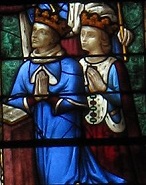
On July 7, 1426 after 3K Mamluks, Turks, and Arabs under Tangriver Mohamed and Inal el Kakimi in 180 ships stage a punitive expedition to Cyprus to stop piracy on Muslim shipping, occupying Limassol, the Battle of Chirokitia sees Genoa-born Christian Frankish Cyprus king (since 1398) Janus of Cyprus (1375-1432) captured, after which they occupy and sack Nicosia before the royal family escapes to Kyrenia and are rescued; after being humiliated in Cairo by being forced to ride a donkey and kneel in front of the Mamluk sultan 9x, Janus is released 10 mo. later on condition that he change his ways, recognize the as his overlord, and pay an annual tribute (jizya).


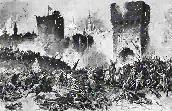
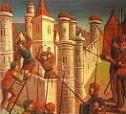

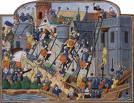
On Jan. 29, 1453 a relief force of two ships from Genoa with 700 men arrives in Constantinople, and its capt. Giovanni Giustiniani Longo from Chios is made cmdr. of Constantinople's defenses; on Feb. 26 (night) 700 Italians flee on seven ships, after which the city gates are closed and a giant chain strung across the Golden Horn. On Apr. 6 after assembling in Jan. on the plains of Adrianople and then reducing every city in their way, 150K Muslims, Janissaries, and Dervishes (incl. some Christians who wanted to get in on the loot) under 21-y.-o. whodya-wanna-call Ottoman Sultan (since 1451) Mehmed (Mehmet) (Mohammed) II (the Conqueror) (1432-81), the Saddam Hussein and Osama bin Laden of the 15th cent. begin the 54-day Final Siege of Constantinople (founded 330 C.E.), defended by 7K Christian knights; the sultan does the traditional Islamic thing of offering the emperor a chance to surrender in exchange for their lives, but he refuses, preferring to fight rather than switch, after which the artillery immediately begins bombarding the city with 70 cannons, incl. a 27-ft.-long 762m (30 in.) 35-ton bronze Shock'em Allah called the Great Turkish Bombard (Dardanalles Gun) (Basilic) (Sahi) (Muhammad's Gun) (designed by Hungarian engineer Urban), which lobs 1.2K-lb. balls up to 1 mi. at the key St. Romanus Gate; on Apr. 12 the 200-ship Ottoman fleet under Bulgarian renegade adm. Suleiman Baltoghlu arrives from Gallipoli, sealing the city off by sea completely; on Apr. 18 (night) the first assault by thousands of mad mullahs is repelled; on Apr. 20 (morning) four large vessels loaded with provisions (four Genoese and one Greek) arrive, and the lame Ottoman fleet fights them all day but fails to stop them from entering the city, pissing-off the sultan, who orders adm. Baltoghlu executed and replaced by Hamza Bey, then has half of his ships pulled on wooden platforms along a greased log roadway he previously constructed by the neutral Genoese colony of Pera across from Constantinople, then launched in the Golden Horn; Muslim assaults on May 7 and May 12 are repelled; by mid-May the Venetian Senate is still debating whether to send aid, and on May 23 a fast ship sent out in early May to greet the expected fleet returns with bad news; on May 22 a lunar eclipse freaks the superstitious Christians, who believe a prophesy that the city can't be taken under a full moon; on May 23 a thunderstorm freaks them more, followed by a strange ghost light surrounding the dome of the Hagia Sophia, which they interpret as the Holy Ghost abandoning it, which doesn't stop hundreds of refugees from crowding in; a captured Muslim engineer is made to talk and give info. allowing the Christians to locate and destroy the Muslim tunnels, buying time; on May 25 the sultan's advisers tell him to raise the siege before the Euros arrive and get them surrounded, but they don't call him the Conqueror for nothing, so he plans an all-out final assault; on May 28 the doomed Christians, sensing the end stage a holy procession, holding the last Christian service in Hagia Sophia, reconciling themselves to dying for their faith; on May 28-29 (Mon.-Tues.) at midnight the final siege begins; although the Christians repel wave after wave, things go bad when their cmdr. Giovanni Giustianini Longo gets wounded, and instead of standing his post orders that he be taken back through the gates to the city, causing the rest of the Genoese to think the gate has been breached, causing them to rush back to it, leaving the emperor and his Greek troops to face the Janissaries alone, after which they are KIA; after the 60-ft.-wide 20-ft.-deep moat and three sets of walls and towers (the inner two walls having 96 towers each) are breached, the city surrenders, after which the Allahu Akbars rape and massacre the helpless don't-say-dhimmi pop., chaining the rest to sell them into slavery (lucky non-white infidel beasts get to do unspeakable things to our white Christian wimmen, incl. gasp, nuns, and after 9/11, we're next?), leaving only 50K after being stopped after 24 hours by Mehmed II, who weeps after viewing the destruction, and utters the immortal soundbyte: "What a city we have given over to plunder and destruction", then awards himself the title of Caesar; Greek-born ecumenical Cardinal Isidore of Kiev (1385-1463) dresses a corpse up in his robes and watches the Turks cut off its head and parade it through the streets, then manages to get shipped to Asia Minor as a slave, later buying his freedom and returning to Rome, adopting the Latin Rite and becoming bishop of Sabina, and later Latin patriarch of Constantinople and archbishop of Cyprus sans jurisdiction, later making the mistake of returning to Moscow and holding a Latin Rite, which gets him imprisoned again; a legion of Cretans manning three towers near the entrance to the Golden Horde holds out and are given safe passage; the Ottoman sailors abandon their ships to rush into the city and get their share, allowing several Christian ships loaded with refugees to escape, incl. Giustianini, who dies a few days later in Chios; after the sultan heads into the city straight to it and personally breaks the altar, Hagia Sophia is turned into a mosque, and the Christian icons plastered over; last Byzantine emperor (since 1448) Constantine XI Palaeologus (Palaiologis) (b. 1405) dies defending the walls, and they stick his head on a pike; on Sept. 30 with infallible timing Pope Nicholas V issues a call for a new Crusade (first time the printing press is used to issue papal appeals?); the loss of Constantinople solidifies Europe around Rome, removing the age-old obstacle to uniting it religiously, while an Islamic prophesy makes the Muslims believe they will conquer Rome next; a major drive to repopulate Istanbul (Turk. "in the city or downtown") (Gr. "eis ten polin" = "into the city") begins, with the 60-alleyway Grand Bazaar (largest enclosed market in the world) built in 1455-61, turning it into the showpiece of the Middle East, with 400K pop. before 1800, about 45% Christian and Jewish; the Muslim Turks are now on the frontier of Germany, and put Venice on the defensive over her eastern colonies for the next 250 years; the Muslims set up a paper mill in Constantinople - how long until a Turk founds Atlantic Records and catapults Ray Charles and the Rolling Stones to stardom? Nothing is all bad? The fall of Constantinople to the Turks causes a large number of Greek scholars to flee to Italy, where they pump up the Renaissance in classical learning; it also leads to renewed efforts to find new westward routes to India and China across the Atlantic as the Ottomans are in a position to close overland trade routes to the Silk Road; after taking over Constantinople, the Muslims find lots of star and crescent flags, and adopt them as their symbol since Sultan Othman I allegedly had a dream of a crescent moon growing until it filled the world, even though Richard I Lionheart had used the symbol in the late 12th cent. when kicking Muslim butt for Christ. The Byzantine Period of the Greek Language ends, and the Modern Period of the Greek Language begins. The S Balkan region (from the Peloponnesus to the Danube River, incl. Albania, Constantinople, Thessaloniki, Thrace, N Greece and Macedonia, Serbia, and Moesia) begins to be called Rumelia (Rumeli) (Turkish "Land of the Romans") as the Muslim Ottomans conquer it from the Christians, who are all Romans as far as they are concerned; up till now they called it Anatolia Rumelia. The Shroud of Christ is sold by Marguerite de Charny to Duke Louis I of Savoy, who moves it to Chambery, France (until 1578); it was really such a poor fake that it disappears for 50 years until Leonardo da Vinci (1452-1519) can be hired to produce the modern good one, based on his own portrait?
In Jan. 1454 Sultan Mehmed II reinstalls the Greek Orthodox Church in Constantinople with all its privileges, while banning all Roman Catholic orgs. from his empire; in Mar. Gennadius II Scholarius (1400-73), who was taken POW by the Turks last year is made ecumenical patriarch of Constantinople (until 1464) by Mehmed II in order to pacify the remaining Christians, whose blood still stinks Constantinople up, beginning a custom of investing each patriarch with a diploma (berat) spelling out his rights and duties as ethnarch (civil head of Orthodox Christians); he gets pissed-off at the treatment of Christians and tries to resign several times before finally doing it?

On Feb. 17, 1454 duke of Burgundy (1419-67) Philip III the Good (1396-1460) holds the magnificent Feast of the Oath of the Pheasant (Banquet du Voeu du Faisan) in Lille to launch a Crusade against the pesky Turks, after which he leaves on Mar. 24 to visit the Reichstag in Regensburg to discuss plans with HRE Frederick III; on Oct. 15-28 the Diet of Frankfurt is held, chaired by Aeneas Silvius, with 68-y.-o. St. John Capistran (b. 1386) sent by Pope Calixtus III to preach a crusade to aid the Hungarians against the pesky Turks, to start next year; too bad, Pope Nicholas V dies next Mar., throwing a monkey wrench into the plans.



On Apr. 8, 1456 in a bid to get Crusader protection, Hungarian king Matthias Corvinus deposes Serbian despot (since 1427) George (Durad) Brankovic (b. 1377) (whose income from the gold-silver mines in Novo Brdo makes him the richest monarch in Europe) in favor of Stephen (Stjepan) Tomasevic (-1463), Roman Catholic son of Bosnian king Stephen (Stjepan) Tomas Kotromanic; too bad, it backfires when many Serbs join the Turks rather than kiss the pope's butt, and Serbia begins to disintegrate; on Dec. 24 (Xmas Eve) Brankovic is killed in a quarrel with Belgrade gov. Szilagyi, and is succeeded as despot of Serbia by his 3rd son Lazar II Brankovic (1421-58) (until Feb. 20, 1458), who next year Lazar gives an oath of subservience to Mehmed II in order to prevent an invasion.


On July 4, 1456 the Siege of Belgrade by the Ottomans under Mehmed II begins as the first step toward taking the kingdom of Hungary; on July 22 the Christians, led by Italian Franciscan soldier-priest "athlete of Christ" (St.) John of Capistrano (b. 1386) and Hungarian gen. John (Janos) Hunyadi (b. 1387) relieve the seige in a surprise counterattack, defeating the Turkish fleet then invading the Turkish camp and wounding Mehmed II, causing the Ottomans to retreat, staving off Ottoman conquest of Hungary for 70 years, and becoming known as the battle that decided the fate of Christendom; on Aug. 11 big hero John Hunyadi (b. 1387) dies of plague, followed by Capistrano (b. 1386) on Oct. 23, who campaigned successfully along with Nicholas of Cusa for full observance of the decree of the 1215 Fourth Lateran Council requiring Jews and Muslims to wear special markings (usually yellow circles) on their clothing, based on what Muslim lands did to them.
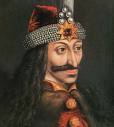
The Drakulya did many curious and terrible things year? On Aug. 22, 1456 Vlad III Dracula (1431-76), who had fought with Hunyadi recaptures the throne of Wallachia with the help of his old enemies the Saxons, and kills Vladislav II, and in Sept. he takes an oath to Hungarian king Matthias Corvinus (son of Janos Hunyadi) and another to Turkish sultan Mehmed II, going on to strengthen the country while practicing his too-cruel-to-be-kind tough love form of absolute-honesty-required justice, with capital at Targoviste ("marketplace") on the right bank of the Ialomita River, having convicts roasted alive and/or flayed, and infants impaled on their mothers' breasts; meanwhile Mehmed II continues the conquest of Serbia, extending the Ottoman empire to the Danube by 1459.
In 1456 the Crusader seaport of Brindisi in S Italy is destroyed by an earthquake.
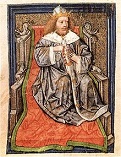
On Nov. 23, 1457 Ladislaus V Posthumous (b. 1440) dies childless suddenly in Prague of leukemia while preparing to wed French king Charles VII's son Magdalena, although the pop. believes he is poisoned; happy HRE Frederick III inherits Upper and Lower Austria (N and S of the Enns River), giving his Hapsburg brother Albert VI the Prodigal (1418-63) Upper Austria (above the Enns River) (capital Linz) (the smaller part) next year, which pisses him off, causing him to siege Frederick in the Vienna Hofburg then take over Lower Austria (below the Enns River) in 1462; meanwhile Frederick III tries to secure the kingships of Bohemia and Hungary.
In 1457 Pope Callistus III summons an assembly of the princes of Europe to devise measures against the inroads of Islam.

On Aug. 14, 1464 Pope (since Aug. 19, 1458) Pius II (b. 1405) dies of fever in Ancona while sailing to the East still trying to organize a Crusade, and on Aug. 30 Pietro Barbo is elected Pope (#211) Paul II (1417-71) (until July 26, 1471), and all plans for a Crusade are dropped and never renewed.
I find that only stupid people are breeding? The Ottomans literally scare the Christians into getting over their fear of falling off the edge of the Earth and discovering America? In May-Aug. 1480 the Ottomans siege Rhodes, the last major Aegean island not under their control, but the Knights of St. John fight them off after causing heavy losses; on Aug. 11 the Ottomans surprise-attack and sack Otranto in S Italy, killing 12K of 22K inhabitants and hauling away 5K in chains, then on Aug. 14 ritually decapitate 800 Christians who refuse to accept Islam in the Valley of the Martyrs in Otranto, sawing archbishop Stephen Pendinelli and garrison cmdr. Count Francesco Largo in half, threatening Italy with conquest, and causing Western navigators to begin turning around, "Seeking the East by Way of the West", i.e., finding a westward passage to the Indies; meanwhile the pope calls for a guess what, a Crusade; on Feb. 28, 2013 Pope Benedict XVI canonizes 800 of the Italian martyrs.


On May 3, 1481 sultan (since Feb. 3, 1451) Mehmed II the Conqueror (b. 1432) dies suddenly, and on May 22 his son Bayezid (Bajazet) II (the Just) (1447-1512) becomes Ottoman sultan #8 (until Apr. 24, 1512) after his pretender younger brother Cem (Jem) (Zizim) (1459-95) (gov. of Karaman in Konya since Dec. 1474) has grand vizier Karamanli Mehmet Pasha transport Mehmed II's body to Constantinople and let it lie in state for three days in violation of Islamic law so that he can get there first and become sultan, only to see his vizier lynched by the Janissaries after they find out and break into the capital, after which Bayezid II arrives on May 21 and is declared sultan on May 22, but on May 27 Cem captures Inegol with a 4K-man army, then on May 28 defeats an army sent by Bayezid II under new vizier Ayas Pasha and declares himself sultan of Anatolia, with capital at Bursa, proposing to divide the empire and give the Euro side to Bayezid II, pissing him off and causing him to utter the soundbyte: "Between rulers there is no kinship"; on June 20 Cem is defeated near Yenishehir in Bursa opposite Constantinople and flees with his family to Mamluk Cairo, seeking protection from the Knights of St. John in Rhodes, who hand him over to Pope Innocent VIII, who tries to use him as a figurehead for a new papal crusade that fails to materialize, and ends up dying in a prison in Naples where Bayezid II pays them to keep him imprisoned; meanwhile on Sept. 11 the Ottoman forces in the Otranto Strait between Albania and Italy surrender to the Christian Aragonese, leaving the Ottoman Empire in disorder while Bayezid II enters a rebuilding period and tries to free himself of the Janissaries, campaigning against the Venetian possesssions in Morea and gaining control of the whole Peloponnese in 1501, facing rebellions in the east by the pesky Qizilbash and their backer Shah Ismail of Persia.


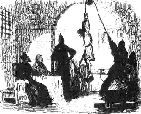

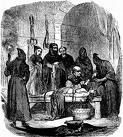


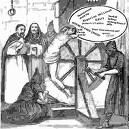
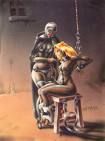
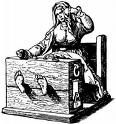
Justice for victims begins with Innocent VIII? Bad time to be a natural redhead? On Aug. 12, 1484 Pope (since 1471) Sixtus IV (b. 1414) dies after issuing a bull allowing local bishops to give the bodies of executed criminals and unidentified corpses to physicians and artists for dissection, allowing Vesalius et al. to advance the science of anatomy, and on Aug. 29 Giovanni Battista Cibo (Cybo) is elected Pope (#213) Innocent VIII (1432-92), issuing a fruitless call for yet another Crusade against the Ottomans; the Spanish Inquisition (established Nov. 1, 1478) gets off to a roaring start under joint church-state direction after never-doubting Tomas (Tomás) de Torquemada (1420-98) (the original Punisher?), prior of a Dominican monastery in Segovia persuades Ferdinand II and Isabella I to get Pope Innocent VIII to appoint the Holy Office of the Inquisition, with himself as grand inquisitor for Castile and Aragon in 1487, with the Mission: Imposible of rooting out heresy among converted Jews, where his wanton torqued-up mad (sexually-gratifying?) (the Catholic teaching on sexuality hits the fan?) torture of his 2K victims by 1498 is later uncovered (3 cents. late) by the Spanish Inquisition's gen. secy. (1789-) Juan Antonio Llorente (1756-1823) and Spanish Jesuit historian Juan de Mariana (1536-1624) from an examination of the archives, and spawns tons of gory horror lit.; unlike the original Rome-based Catholic Inquisition (est. 1231), the Spanish Inquisitors are appointed by the sovereigns, and are free of responsibility to the Church, giving them a 007 license to build and operate fun B&D dens, and they end up executing up to 30K during the next 3.5 cents. (2 per week avg.), incl. whole families and towns for offenses such as heresy, freethinking, seduction, smuggling, impersonation, and usury, freely torturing witnesses as well as defendants - zoom zoom zoom?
In 1500 Pope Alexander VI proclaims a Year of Jubilee, and preaches a Crusade against the Turks, imposing a tithe to pay for it; meanwhile German monk Martin Luther (1483-1546) issues a great proto-Protestant soundbyte: "I persuade myself verily, that the Day of Judgment will not be absent full three hundred years. God will not, cannot, suffer this world much longer... The Great Day is drawing near in which the kingdom of abominations shall be overthrown."
On May 3, 1512 the Fifth Council of the Lateran convenes in the Archbasilica of St. John Lateran (until Mar. 16, 1517), attended by 15 cardinals, 10 archbishops, 56 bishops, and the Latin patriarchs of Alexandria and Antioch, becoming the last before the Protestant Reformation, publishing decrees requiring local bishops to give permission before the printing of new books, rejecting the 1511 Conciliabulum of Pisa, and promoting a holy war against the infidel Turks to reclaim the Holy Land; the immortality of the soul becomes Church dogma (what about Ecclesiastes Ch. 9?); Martin Luther pub. his "95 Theses" 7 mo. after the council closes.
On Sept. 28, 1541 HRE Charles V personally leads an expedition of 500 ships incl. 80 galleys, 24K Spanish, Italian, and Spanish soldiers, and 12K sailors against Algiers, defended by 5K Ottoman troops and 800 Moors, arriving on Oct. 19, and disembarking troops on Oct. 23, surrounding the city except the N part; too bad, on Oct. 24 a storm disrupts his landing operations, and Adm. Andrea Dorea and old fart Hernan Cortes save some of the fleet from running aground, while Charles V is surrounded and saved only by the stiff resistance of 150 Knights of Malta, after which an indecisive land fight the fleet holes-up in Cape Matifu 5 mi. to the E, and departs for Spain on Nov. 23 after Charles V throws his horses overboard, reaching Cartagena on Dec. 3 with a loss of 130 carracks and 17 galleys plus hundreds of troops, leaving 12K men behind, who are massacred or taken captive, causing a glut on the A lgiers slave market, with Christian slaves going for the price of an onion; the disaster causes Charles V to give up trying to open Christian shipping in the W Mediterranean and lick his wounds.
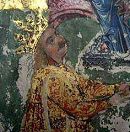
On Apr. 12, 1567 after receiving 6K horsemen from Vlad III Dracula, Bogdan II's son Stephen defeats Petru Aron at the Battle of Doljesti, followed on Apr. 14 by the Battle of Orbic, after which Petru flees to Poland, while Stephen is crowned prince Stephen III the Great (1433-1504) of Moldavia, going on to win 34 of 36 battles against the Ottomans while maintaining Moldavia's independence from Hungary and Poland.


In Apr. 1534 an 80-ship Ottoman fleet led by Lesbos-born Turkish privateer adm. Barbarossa (Redbeard) II Hayreddin Pasha (1478-1546) recaptures Coron, Patras, and Lepanto from the Spaniards, then crosses the Strait of Messina in July, capturing a large number of ships around Reggio Calabria as well as the Castle of San Lucido, then destroys the port of Cetraro, and in July attacks Campagnia, sacking Capri and Procida and bombarding the ports of Naples; not done yet, in Aug. he attacks Lazio and Gaeta and works his way up the Tiber River, causing the church bells of Rome to sound an alarm; he then turns S, attacks Ponza, Sicily, and Sardinia, then captures Tunis in N Africa in Aug. from Hafsin Sultan Mulei Hassan, who asks HRE Charles V to plan a counterattack; Barbarossa also captures the strategic Tunisian port of La Goulette, and waits for the emperor to bring it on.
In May 1535 after Barbarossa high-tails it out of N Africa to the Tyrrhenian Sea, entrenching himself in Capri and building a fort, a Spanish-Italian force of 300 galleys and 24K soldiers under Adm. Andrea Dorea recaptures Tunis, Bone (Annaba) and Mahdiya, and frees 20K Christian slaves for a giant V for Christ against Muhammad; meanwhile Francesco Maria dies without heirs, and Charles V gains control of Milan, starting yet another war with Francis I of France (ends 1538); meanwhile fidgety Barbarossa raids coastal Algiers and Spain, destroys the ports of Majorca and Minorca, captures several Spanish and Genoese galleys and liberates their Muslim slaves, and in Sept. repulses a Spanish attack on Tlemcen in NW Algeria.

On May 18-Sept. 11, 1565 the Great Siege of Malta sees the Ottoman Muslims unsuccessfully try to take Malta from the Hospitallers (Order of St. John) under grandmaster (since 1557) Jean Parison de la Valette (1494-1568); the Battle of Malta (the last battle of the Crusades?) ends cross-slappin' happily for the Crusaders with the arrival of Spanish troops, forcing the Turks to abandon their seige after losing 25K-35K, vs. 2.5K troops, 500 slaves, and 7K civilians for the Christians, after which the siege becomes one of the most celebrated events of the cent. in Christendom, ending the aura of Ottoman invincibility and beginning the era of Spanish domination of the Mediterranean; Ottoman Gen. Dragut is kia by cannon fire from Ft. St. Elmo in Il-Qortin (modern-day Sliema); French biographer Seigneur de Brantome, Seigneur de Bourdeille joins the expedition sent to Malta to assist the Knights of St. John, and later goes to Italy, Africa, and Hungary to gain mucho material for his cool memoirs; the 9/11 attack is meant to get even for this D along with the one in Vienna in 1683?
In July 1570 the Ottomans under Selim II invade Cyprus and capture Nicosia, then siege Famagusta in Aug. (until 1571), and declare war on Venice (ends 1573); meanwhile the Algerians retake Tunis from the Hapsburgs for the Ottoman Empire (until 1573), and siege Cyprus, causing Pope Pius V to form the Holy League next year with Spain and Venice against the Muslims; in 1569-74 Selimiye Mosque is built over St. Sofia Church in Nicosia.




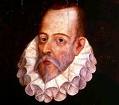
On Aug. 3, 1571 after an 11-mo. siege, 70K Turks capture Famagusta, capital and chief city of Cyprus, and massacre its pop.. On Oct. 7, 1571 after Pope (1566-72) Pius V (Antonio Michele Ghislieri) (1504-72) signs the Holy League Alliance with Spain and Venice, 200 Spanish and Venetian galleys under 24-y.-o. Don John (Juan) of Austria (1547-78) (half-brother of Philip II of Spain, and illegitimate son of HRE Charles V) defeat the 230-galley Turkish fleet at the 6-hour Battle of Lepanto (Naupactos) in a bay at the mouth of the Gulf of Patras (entrance to the Gulf of Corinth) off Lepanto in W Greece (biggest naval battle in Mediterranean history?) (last major naval battle fought exclusively by rowing vessels?) just before 5 p.m., with 12K Christian casualties vs. 6K Muslim POWs taken and 30K of 56K KIA, incl. Turkish fleet grand adm. Muezzinzade Ali Pasha aboard his ship, becoming the first defeat of Muslims by Christians on the sea, a big V for Western military technology, and the beginning of the end of the Ottoman naval threat in the C Mediterranean, destroying the myth of their invincibility, although both fleets are heavily damaged and the Ottomans speedily rebuild their fleet and restore their supremacy on the W and E sides; Spanish writer Miguel de Cervantes Saavedra (1547-1616) is wounded in the battle, calling it "the most noble and memorable event that past centuries have seen or future generations can ever hope to witness"; Italian-born Muslim convert Ottoman adm. Uluj Ali Reis (Giovanni Diongini Galeni) (1519-87) captures the flagship of the Maltese Knights along with its great banner before gathering the fleet's remaining 87 ships and returning to Constantinople, getting promoted on Oct. 29 to grand adm.; since most of the Ottoman sailors had been sent home for winter and the rest were involved in political squabbles, and the Christians outnumbered them, it was an overrated V for Christ?; the failures of war galleys cause their use to decline as better designs are sought and bigger vessels built; many Muslim POWs are taken and used to man Christian oars; bald, white-bearded future saint Pope Pius V allegedly sees the V in a vision in Rome at the exact moment it happens, ascribing it to intercession by the Virgin Mary, establishing the Feast of Our Lady of Victory (the Holy Rosary) on Oct. 7, even though he isn't informed of it officially until Oct. 21? - Playtex, who knows you like we do?

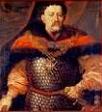


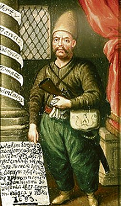

A touch of fame for a Pollock? On July 14, 1683 the Great Austrian-Turkish War (ends 1699) and the Polish-Turkish War (ends 1699) begin as 140K Turks with 300 cannon under Merzifonlu Kara ("Black") Mustafa Pasha (1634-83) begin the Second Siege of Vienna, held by only 20K troops under Count Ernst Rudiger von Starhemberg (1638-1701), culminating on Sept. 11 (the original 9/11) with the epic Battle of Vienna (Kahlenberg); the Christians hold out until Sept. 12 as sappers undermine the city walls, when Jan III Sobieski (1624-96) of Poland swallows his pride at the thought of the Ottoman border being so close to Cracow and allies with HRE Leopold I and duke Charles of Lorraine (1643-90) (who defeated Imre Thokoly of Hungary at Bisamberg 5km NE of Vienna in Aug.) to become CIC of the 84K-man combined armies and raise the siege with 3K Polish mounted Winged Hussars plus 34K Polish troops, 18.5K Austrians, 10.5K Bavarians, 9K Saxons, and 9.5K Swabian and Franconian troops, who stage the largest cavalry charge in history, making Sobieski a hero of Christendom, and marking the end of Islamic military conquests in Europe until ?; after the battle, Sobieski utters the soundbyte "Venimus, Vidimus, Deus Vincit" (We Came, We Saw, God Won); the Christian battle cry of "Maria Help" is amended at the suggestion of Johann Georg III of Saxony (who commands the left wing) to "Jesus and Maria Help", causing Sobieski to utter the soundbyte "The elector of Saxony is an honest man with a straight heart", after which Johann George III accompanies the HRE on his entry to Vienna, then abruptly leaves with his troops after they are treated like merde for being Protestants (kiss my ass, kiss your ass, happy Hanukkah?); after the liberation of Vienna, HRE Leopold I meets with Jan Sobieski in Schwechat near Vienna, which commemorted by an obelisk; Starhemberg also becomes a star, and is promoted to field marshal, but is severely wounded in 1686 at the siege of Buda and gets a desk job as pres. of the Hofkriegsrat; the V marks the hegemony of the Hapsburgs; on Dec. 25 Mustafa Pasha is strangled in Belgrade by the Janissaries and his head sent to sultan Mehmed IV in a velvet bag; too bad, Imre Thokoly, who fights with the Turks gets blamed by them for the whole D, and after rushing to Edirne to defend himself in front of the sultan, he flops and tries to make up with Sobieski, promising to lay down his arms if he is recognized as Protestant prince of Upper Hungary, but Sobieski demands unconditional surrender, and he has to fight on his own with neither side trusting him; the Turks leave massive stores of loot, with Sobieski uttering the soundbyte "Ours are treasures unheard of... tents, sheep, cattle and no small number of camels... It is a victory nobody ever knew of, the enemy now completely ruined, everything lost for them"; the first coffeehouse is opened in Vienna by Polish officer Jerzy Franciszek Kulczycki (1640-94) (known for escaping from the besieged city to get help) after the withdrawing sackers leave coffee sacks behind, introducing the custom of adding sugar and milk (melange); the first Vienna coffeehouse is really opened by Armenian Johannes Theodat in 1685?; like a rose that blooms then starts to decay, the Turkish Empire in Europe reaches its maximum extent, stretching from beyond Budapest on the Danube River, the Carpathians, and the headwaters of the Bug River to the Black Sea, Aegean, and Ionian Seas, with only Dalmatia (ruled by Venice) and Montenegro (semi-independent) as exceptions; after this, the Islamic world fails to keep pace with the West, incl. constructing public clocks, implementing standardized linear measurements, and modernization in general, compounded by pervasive autocracy.




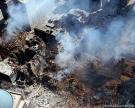























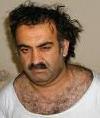

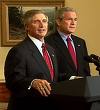











On Sept. 11, 2001 (Tues.) Pres. George W. Bush is targeted in an assassination plot by al-Qaida in Sarasota, Fla.? On Sept. 11 (Tues.) the New York Times pub. a story about ex-Weatherman radical Bill Ayers, quoting him as saying "I don't regret setting bombs. I feel we didn't do enough." On Sept. 11 (Tues.) the 9/11 Attacks see the New York City skyline changed after 19 lowdown cowardly stinking crazed Satan-controlled Muslim raghead jihad terrorist scumbags (incl. 15 Saudis) hijack four U.S. commercial airliners and take over the unprotected cabins, using flying lessons given them in the U.S. to steer and crash into the twin towers of the World Trade Center (WTC) (dedicated in Apr. 1973), and also the Pentagon; Am. Airlines Flight 11 (Boeing 767) from Boston to Los Angeles hits the North Tower at 8:46:26 a.m. with a direct hit that disables all the elevators; actor Tony Perkins' wife Berinthia "Berry" Berenson-Perkins (b. 1948) is on Flight 11; United Airlines Flight 175 (Boeing 767) from Boston to Los Angeles hits the South Tower at 9:02:54 a.m. at an angle, permitting people to escape; Am. Airlines Flight 77 from Washington, D.C. to Los Angeles hits the SW face of the Pentagon at 9:43 a.m. on the 60th anniv. of its groundbreaking; it was really a U.S.-launched missile, and was covered-up?; Pres. Bush had a meeting scheduled with affiliates of the Muslim Brotherhood after he arrived back at the White House; Pres. Bush first informs the nation of "an apparent terrorist attack on our country" at 9:30 from the school; at 9:45 a.m. the FAA grounds all civilian domestic and internat. flights to-from the U.S., although an El Al (Boeing 747) flight is allowed to take from JFK Airport to Tel Aviv at 4:11 p.m.; commercial flights resume on Sept. 13, followed by private flights on Sept. 14; on Sept. 20 a flight containing Bin Laden family members is allowed to leave the U.S., carrying four Americans; on Sept. 11 NBC-TV commentator Tom Brokaw answers a speculation by Matt Laurer with "This is war. This is a declaration and execution of an attack on the United States", later chanting "War! War!"; "When I saw the second airplane hit, I knew jihad has come to America" (Nonie Darwish); the South Tower implodes at 9:59:04 a.m., followed by the North Tower at 10:28:31 a.m., after the jet fuel ignites tons of paper, which causes internal temps as high as 2K F; Pres. Bush is informed of the South Tower crash at 9:07 a.m. by White House chief of staff (2001-6) Andrew Hill "Andy" Card Jr. (1947-) while visiting with 2nd grade (mainly black) students at Emma E. Booker Elementary School in Sarasota, Fla., and turns red, but stays with the kids, reading aloud from the children's story The Pet Goat (by Siegfried Engelmann and Elaine C. Bruner) with them; British-born former U.S. Army officer Cyril Richard "Rick" Rescoria (b. 1939), vice-pres. of security at Morgan Stanley (scheduled for retirement at year's end) dies after helping 2.7K coworkers to safety; after rushing in to help not knowing about the impending collapse; 343 firefighters die in the Twin Towers, and firefighter (Argentine native) Sergio Gabrial Villanueva (b. 1968) becomes a hero; Hollywood actor Steven Vincent "Steve" Buscemi (1957-) (a former NYC firefighter) quietly returns to Engine Co. 55 and works 12-hour shifts, trying to avoid publicity; two Port Authority of N.Y. and N.J. police officers survive the towers' collapse and are rescued from the rubble after 22 hours; 300K are evacuated by boat in lower Manhattan after hundreds of craft answer a Coast Guard call for help "From All Available Boats" and converge on the West Side; meanwhile United Air Lines Flight 93 from Newark, N.J. to San Francisco, Calif. carrying 37 passengers and seven crew is hijacked by Beirut, Lebanon-born pilot (al-Qaida member) Ziad Samir Jarrah (1975-2001) and three Saudi Arabia-born muscle men Ahmed bin Abdullah al-Nami (1977-2001), Ahmed Ibrahim al-Haznawi (1980-2001), and Saeed Abdallah Ali Sulayman al-Ghamdi (1979-2001), crashing at 10:03 a.m. near Shanksville in Somerset County, Penn. (60 mi. SE of Pittsburgh and 150 mi. NW of Washington, D.C.) after the 33 all-American passengers are first cowed by a fake body bomb then fight back against the four ragheads instead of cowering like sheep, and kick the surprised terrorists butts, although too late to prevent the crash; Flight 93 passenger Todd Morgan Beamer (b. 1968) becomes a U.S. hero when he quarterbacks the makeshift anti-raghead team with the all-American words "Let's roll!", which are heard on his cellphone; his sad-proud wife Lisa later founds the charity Heroic Choices; the Flight 93 Nat. Memorial is established on Sept. 24, 2002, and dedicated on Sept. 10, 2011; 2,976 are killed in the 9/11 attacks, incl. 2,605 in New York City, 125 at the Pentagon (incl. 55 military personnel), and 246 on the four planes, with 24 listed as missing, becoming the most Americans lost on U.S. soil since the Sept. 17, 1862 Battle of Antietam, and the greatest single-day civilian loss of life in the U.S. since the May 31, 1889 Johnstown Penn. Flood; Time mag. pub. a 9/11 tragedy issue with a cover photo by Lyle Owerko; many Palestinians openly celebrate the attackon the Great Satan U.S.; Iraqi pres. Saddam Hussein utters the soundbyte: "The American cowboys are reaping the fruit of their crimes against humanity"; the govts. of Cuba, Iran, Libya, and North Korea join a worldwide chorus denouncing the attacks; Arab leaders denouncing the attacks incl. King Hussein of Jordan, Egyptian pres. Hosni Mubarak, and Lebanese PM Rafik Hariri; some Muslims around the world express sympathy for the 9/11 victims, incl. a moment of silence at a World Cup match between Bahrain and Iran on Sept. 14, and a candlelight vigil by Palestinians in Jerusalem on Sept. 15 along with another in Tehran; on Sept. 14 Ireland holds a nat. day of mourning, becoming the only country other than the U.S. and Israel to do so; the Taliban in Afghanistan condemns the attacks but denies that Osama bin Laden is behind them; bin Laden also denies involvement, claiming that there is a govt. within the govt. of the U.S. that wants to turn the 21st cent. into a cent. of conflict between Islam and Christianity, suggesting U.S. Jews and intel agencies, but later admits responsibility in an Oct. 29, 2004 video; the mastermind was mechanical engineering-trained Khalid Sheikh Mohammed (1964-); the economic repercussions cost the U.S. economy $1T (same as Bush's June 7 tax cut); 40K workers work at "The Pile" at Ground Zero for the next 8 mo., removing 1M tons of rubble, and 69% of them later develop permanent lung problems known as "WTC Cough"; NASA astronaut Frank Culbertson films the smoking WTC from space; New York Fire Dept. chaplain (Roman Catholic Franciscan friar) Father Mychal (Michael) Fallon Judge (b. 1933) dies at the WTC, becoming the "Saint of 9/11" ("God is going to make the headlines some day rather than the Devil, so don't give up"); St. Nicholas Greek Orthodox Church at 130 Liberty St. is destroyed, and the govt. stalls in rebuilding it until ?; St. Paul's Chapel at 209 Broadway facing Church St. opposite the E side of the WTC, where new U.S. pres. #1 George Washington prayed after his first inauguration on Apr. 30, 1789 is not harmed, and the syacmore tree in its courtyard becomes known as the 9/11 Sycamore, with a memorial later built for it (Isaiah 9:10); at 8:30 p.m. Pres. Bush gives a great Red-Blooded Am. Cowboy Speech from the White House, with the soundbyte "Make no mistake about it, the U.S. will hunt down and punish those responsible for these cowardly acts"; the U.S. launches into a new kind of war, the Global War on Terror (Terrorism) (ends ?); Osama bin Laden and his Al-Qaida org. are immediately suspected and become the world's most-wanted criminals, despite of a lack of hard evidence; Egyptian-born 9/11 ringleader ("Emir of the WTC Attack") Mohamed Mohamed Atta (b. 1968) (Mohamed Attacker?) (who created the jihad cell in Hamburg, Germany in the late 1990s, incl. three of the four pilots) is found to have met in Prague with an Iraqi spy, throwing suspicions on Saddam Hussein, and New York City-born U.S. nat. security adviser Richard N. Perle (1941-) allegedly either blames the 9/11 attack on Iraq or wants retaliation to incl. them; Pres. Bush activates the "shadow govt." of 75-150 top officials working 90-day shifts in underground bunkers on the East Coast; the Five Dancing Israelis incident starts with a woman named Maria claiming to see a white van with five men in it filming the burning Twin Towers, allegedly with shouts of joy, who are alleged to be Israeli Mossad agents, although they are interviewed and deny dancing etc., causing conspiracy theorists to claim 9/11 was a Mossad operation; New York City Mayor Rudolph William Louis "Rudy" Giuliani (1944-) leads the city in a heroic manner after the attacks, earning the title "America's Mayor", and calling the deaths "worse than anyone could bear"; "Vanity Fair" ed. Graydon Carter comments "I think it's the end of the age of irony"; British Queen Elizabeth II comments "Grief is the price we pay for love"; Russian pres. Vladimir Putin orders a massive expansion of intel-gathering efforts in North Am. and W Europe; a folded $20 U.S. bill shows the Twin Towers burning?; Algerian-born British airline pilot Lotfi Raissi becomes the first person accused of participating in the 9/11 attack, and is held for five mo. in Belmarsh hi-security prison in London, then put through nine years of hell until being cleared on Apr. 23, 2010; the 20-ft. Ground Zero Cross, a fortuitous configuration of fallen I-beams draws memorial messages and becomes a religious monument; Alicia Esteve Head, who is in Spain on 9/11 arrives in the U.S. in 2003 and pretends to be 9/11 Twin Towers survivor Tania Head, becoming er, head of the survivors' network until she is exposed in 2007, becoming the subject of the 2012 book The Woman Who Wasn't There: The True Story of an Incredible Deception by Robin Gaby Fisher; ; meanwhile by 2003 a joke translation of Quran 9:11 begins circulating: "For it is written that a son of Arabia would awaken a fearsome Eagle. The wrath of the Eagle would be felt throughout the lands of Allah and lo, while some of the people trembled in despair still more rejoiced, for the wrath of the Eagle cleansed the lands of Allah; and there was peace"; later conspiracy theorists begin exposing the 9/11 attacks as really perpetrated by the U.S. govt. to give them a pretext to destroy the last bastions of the Bill of Rights in the name of homeland security and give them a coverstory to invade the Middle East at will to secure oil, and point to a giant 9/11 conspiracy and coverup, incl. the framing of Muslim terrorists, who allegedly could never have accurately flown the airliners into the WTC, the fact that no fighters were scrambled to accept any of them, the fact that Osama bin Laden et al. were originally trained by the U.S., the problem that eight of those named on the FBI's list of 19 names later turn up alive and well living in different countries, and the evidences of the deliberate demolition of WTC Bldg. 7, which hadn't been struck by an airplane; later civil engineers prove WTC Bldg. 7 was in free-fall for 2.5 sec., pointing to planted explosives; others claim to rebut conspiracy allegations; did the U.S. govt murder its own people to make a power grab, then stage a coverup, stay tuned?; in Aug. 2009 a group of law enforcement officers and others who participated in the 9/11 rescue and cleanup develop immune system cancer and other health problems; by 2010 3K WTC survivors are still experienced long-term PTSD; on Mar. 11, 2010 they reach a $657.5M settlement; Saudi princess Haifa bint Faisal, wife of U.S. ambassador to Saudi Arabia Prince Bandar bin Sultan is later discovered to have donated money via a conduit to two of the 9/11 hijackers.

On May 2, 2005 Ridley Scott's Kingdom of Heaven (Scott Free Productions) (Studio Babelsberg) (20th Cent. Fox) debuts, filmed in Quarzazate, Morroco and filled with super-cool medieval battle scenes, starring Orlando Bloom as 12th cent. French knight Balian of Ibelin, who fights cool dressed-in-black chivalrous Ayyubid Muslim sultan Saladan (Ghassan Massoud) for Jerusalem in 1187 while romancing super-hot (those eyes, those eyes) Queen Sibylla (Eva Green) and fighting mean Guy de Lusignan (Marton Csokas) and crazy-as-a-fox Raynald de Chatillon (Brendan Gleeson) (master of Kerak Castle) with help from marshal Tiberias (Jeremy Irons); Liam Needson, er, Neeson plays Balian's father Godfrey; David Thewlis plays the Hospitaller; Alexander Siddig plays Saladin's Persian lt. Imad ad-Din al-Isfahani; Edward Norton plays leprous Jerusalem king Baldwin IV; Iain Glen plays Richard Lionheart; "What is Jerusalem worth?" (Balian); "Nothing... everything" (Saladin); "Nearly a thousand years later, peace in the Holy Land remains elusive"; does $211.7M box office on a $130M budget.
On Dec. 18, 2016 Jordanian security forces free tourists trapped inside the Crusder-era Kerak Castle in Jordan after a shootout with Islamists that kills nine.